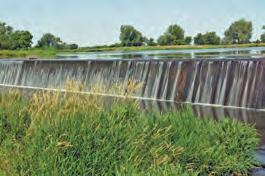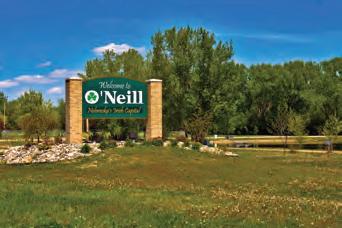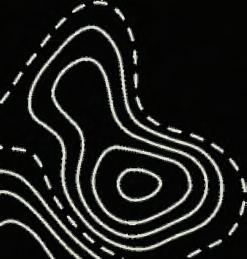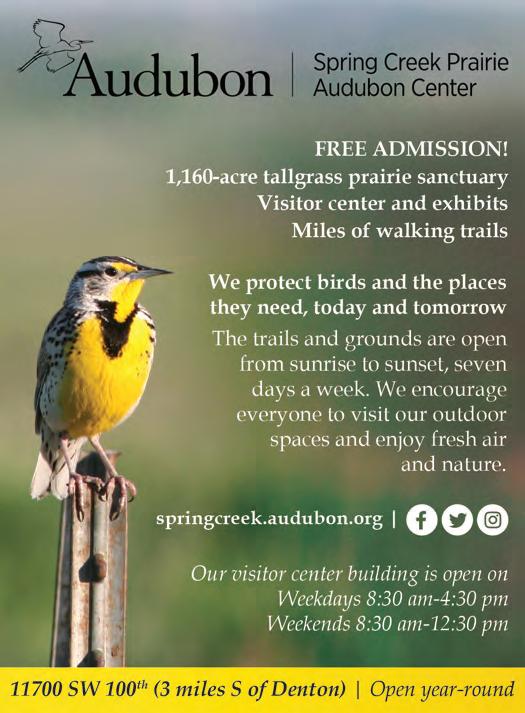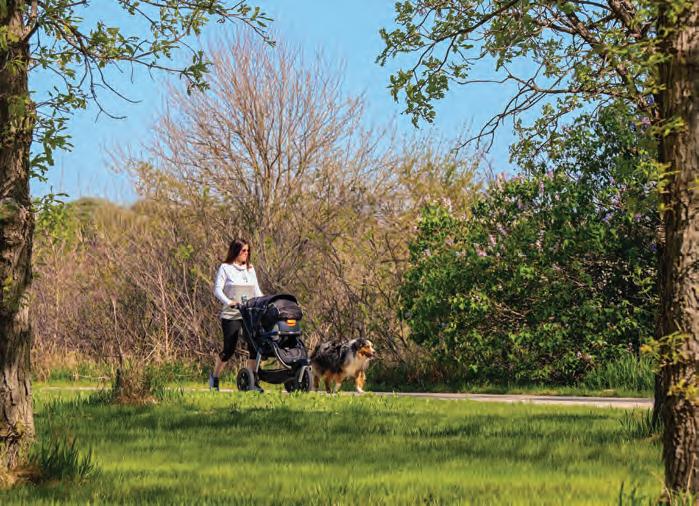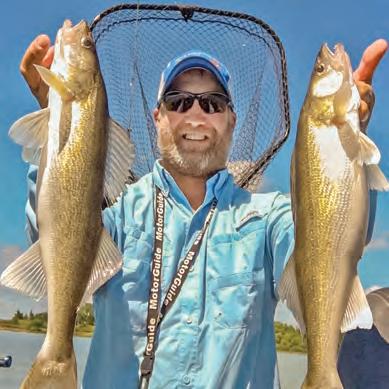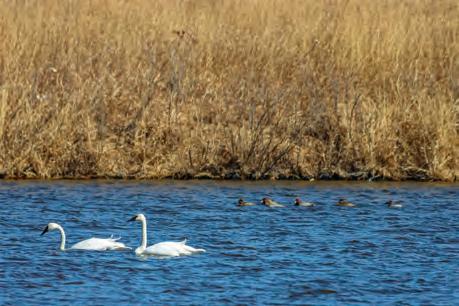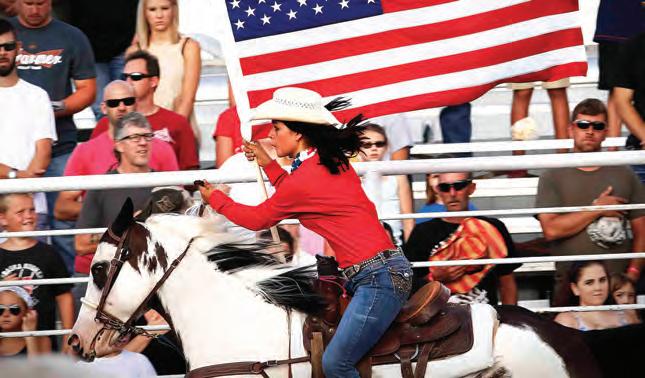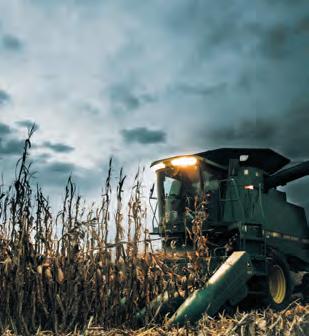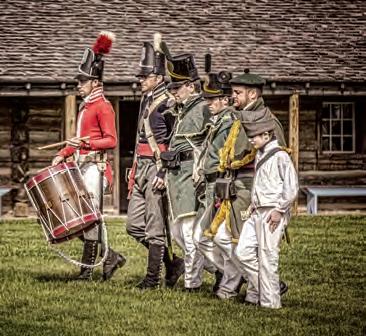


















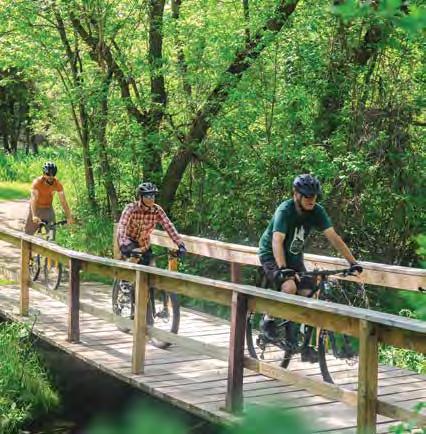
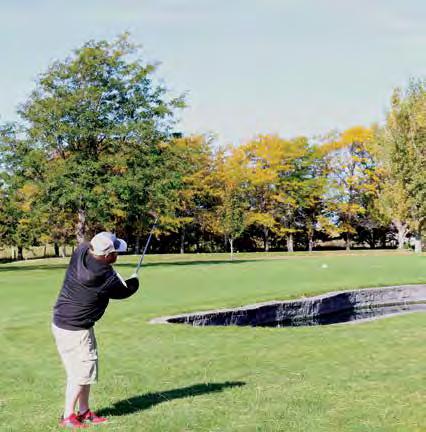
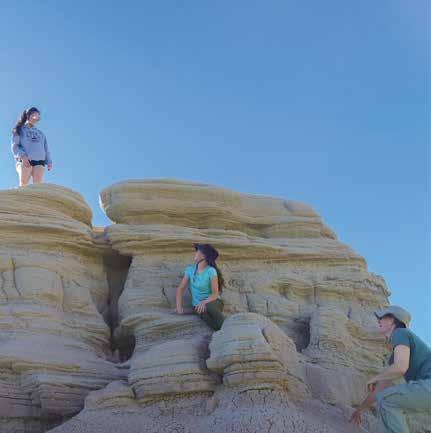
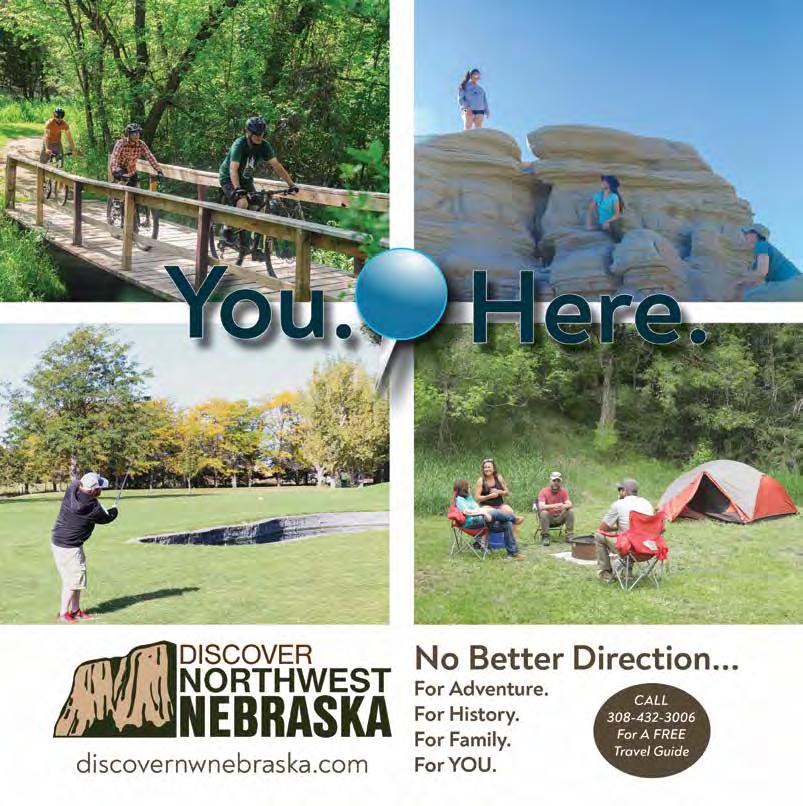
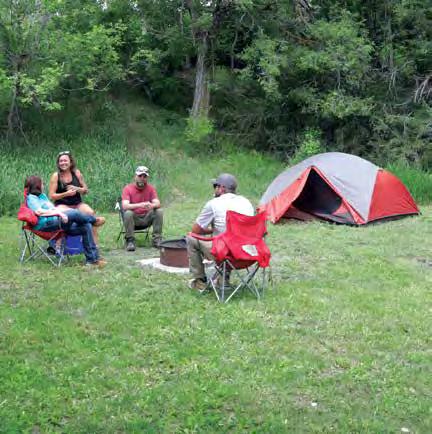
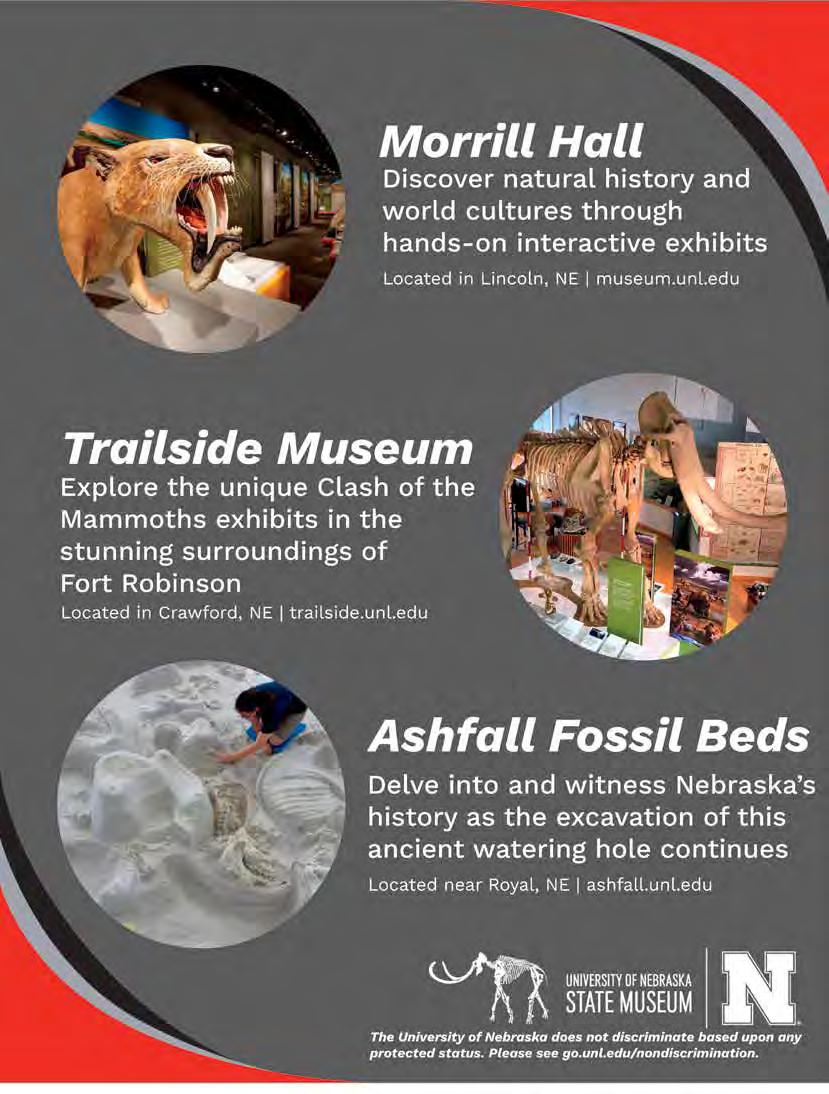
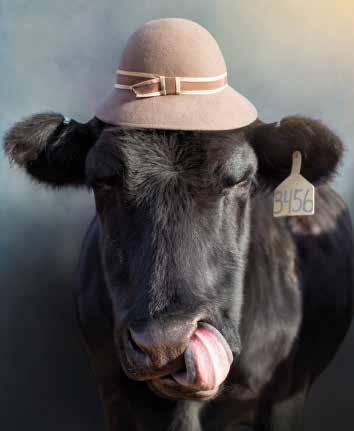
Cows Wear Hats, pg. 38
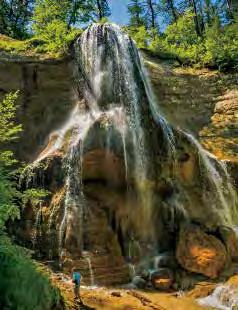
22
JUNE 2024
Honoring the Fallen
South Sioux City remembers the military heroes, far and close to home, who gave their lives for their country.
by Tim Trudell & Tom Hess photographs by Lori Risdal
26 Living History
In a summertime blast from the past, living-history events keep heritage and culture alive at these Nebraska forts, museums and farms.
by Lauren Warring
38
When Cows Wear Hats
What started with a wreath of purple flowers and a favorite cow named Velma is now an award-winning photography collection from a photographer on a Sandhills farm. by Nicole Louden photographic art by Audrey Powles
58 Cornhusker State Games
From toddlers to great-grandparents, athletes compete across Nebraska for Cornhusker gold this summer. by Cheyenne Rowe
66
Nebraska Passport
To celebrate its 15th year, Nebraska Passport adds fan-favorite stops with one-of-a-kind collectibles exclusive to passport travelers. by Lauren Warring
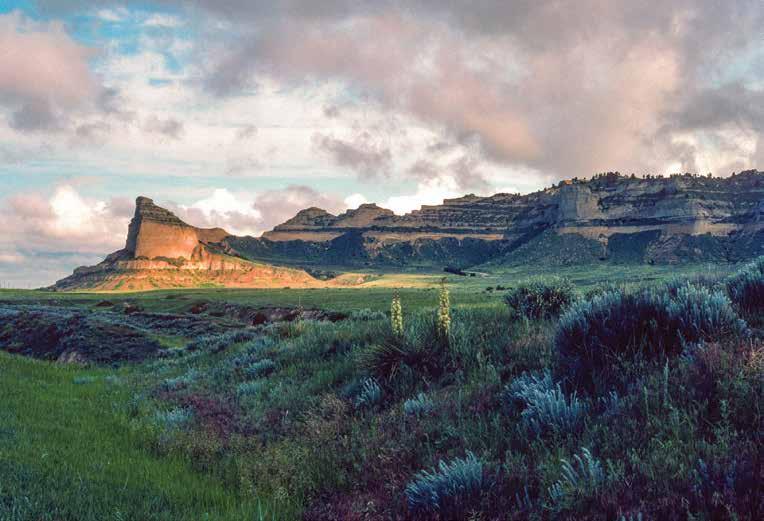


Bingham, pg. 38
Arthur, pg. 16
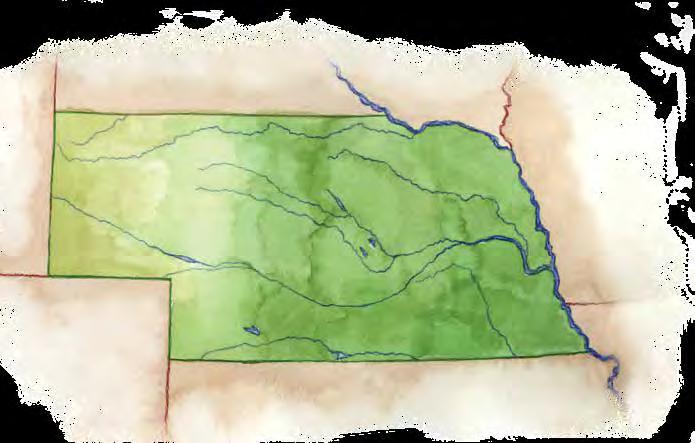
Valentine pg. 66
Norfolk, pg. 66
South Sioux City, pg. 22
Burwell, pg. 26
Grand Island, pg. 26
Kearney, pg. 26
Valley pg. 58 York, pg. 26
Fremont, pg. 58
Papillion, pg. 52
Fort Calhoun, pg. 26
Omaha, pg. 16, 52, 72
Henderson, pg. 26
Seward, pg. 52
Lincoln, pg. 58 Nebraska City, pg. 26
Burr, pg. 66
Letters, emails, posts and notes from our readers.
Peregrine falcons nest on a 28th floor of downtown Omaha’s skyline; University of Nebraska Press reveres Nebraska’s Sandhills with their newest publication.
Channel your love for Nebraska’s rivers on this quiz of the state’s waterways. Answers on page 53. No peeking!
Big or small, these museums preserve Nebraska history and heritage for all to experience.
Don’t be chicken with these recipes for your summer picnics and cookouts.
As seasons change, these Nebraska poets remain connected to the land as it awakens in the warmer months.
Fourth of July celebrations spark across eastern Nebraska with marathons, parades, live music and sports.
Alan J. Bartels has always loved these hard-shelled reptiles since a run-in with one during the eighth grade.
On “gravel travels” through farm country near Omaha, photographer Karen Kader captures agricultural art.
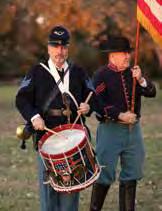
Interpreters keep Nebraska heritage alive at living-history events across the state, such as Fort Kearny State Historical Park.
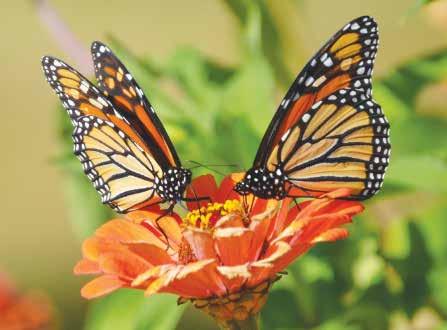
Poetry, pg. 49
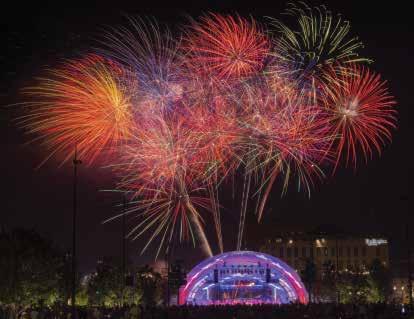
Traveler, pg. 52
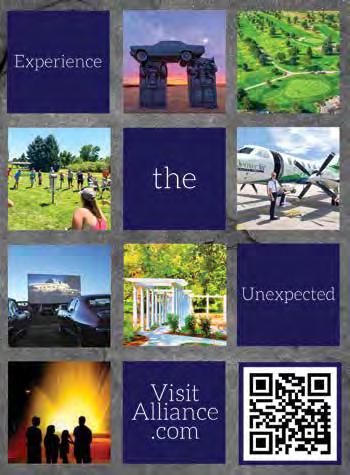

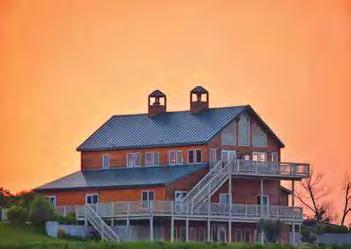


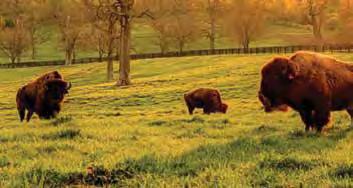

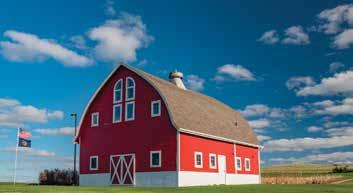




JUNE 2024
Volume 28, Number 3
Editor & Publisher
Chris Amundson
Associate Publisher
Angela Amundson
Creative Director
Darren Smith
Senior Editor Tom Hess
Senior Designer
Jennifer Stevens
Production Assistants
Victoria Finlayson
Lauren Warring
Advertising Sales
Marilyn Koponen
Subscriber Services
Carol Butler, Janice Sudbeck
Nebraska Life Magazine
c/o Subscriptions Dept. PO Box 270130 Fort Collins, CO 80527
1-800-777-6159 NebraskaLife.com
SUBSCRIBE
Subscriptions are 1-yr (6 issues) for $30 or 2-yrs (12 issues) for $52. Please call, visit NebraskaLife.com or return a subscription card from this issue. For fundraising and group subscription rates, call or email subscriptions@nebraskalife.com.
ADVERTISE
Advertising deadlines are three months prior to publication dates. For rates and position availability, please call or email advertising@nebraskalife.com.
CONTRIBUTE
Send us your letters, stories, photos and story tips by writing to us, emailing editor@nebraskalife.com, or visiting NebraskaLife.com/contribute.
COPYRIGHT
All text, photography and artwork are copyright 2024 by Flagship Publishing, Inc. For reprint permission, please call or email publisher@nebraskalife.com.
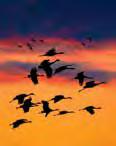
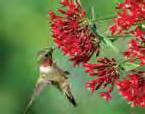
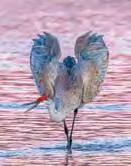
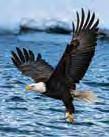
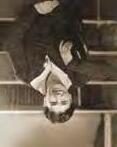
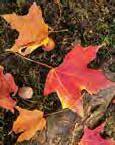
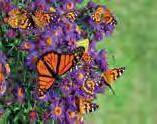
Nebraska Life Magazine celebrates the
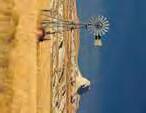
Gifting
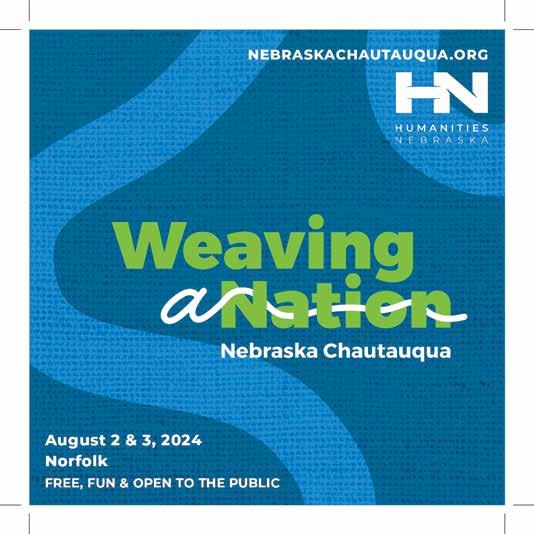
I enjoyed the Mailbox letter from Lowell Fritsche of August, Georgia, about the University of Nebraska-Lincoln goal posts (January/February 2024, “Where did the goal posts go?”). I knew Lowell’s parent in Maywood. His dad ran the hardware store – good people.
I love the magazine, especially the great pictures. I read it cover to cover. Thank you for publishing my poem “The Elopement.” Writers are used to rejection, so I was surprised.
Betty Schmelzer Lincoln
Nebraska Life is a unique magazine and a fantastic promoter of the towns, regions, and attractions found in our beautiful state. Thank you to you and your staff for showcasing Nebraska’s people and places in such positive ways. When needing gifts for others in the future, I will certainly keep Nebraska Life at the top of my list.
Jeff Bakewell Omaha
Kraut lunch recipe
I saw the letter to the editor regarding the sauerkraut/ground beef over potatoes (“School lunch mystery,” March-May 2024). I researched and this is what I could find: tinyurl.com/potatosauerkraut
Renae L. Zimmer Kearney
More right than rain for this pivot
I’m a lifelong Nebraskan being born and raised in Central Nebraska, going to school in Lincoln and been living in south central Nebraska for 25-plus years now. I enjoy receiving my Nebraska Life each time, and I always pick up something new that I really appreciate. For example, I had forgotten about the Villagers in Taylor (“The Villagers of Taylor stop traffic,” January/February 2024). Next time I am up that way I’ll make sure to go through. I did read the article on agricultural inventions and was especially interested in the article on center pivots as you can imagine (“Harvest of Ideas,” January/
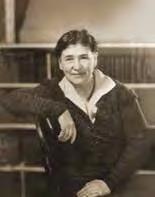
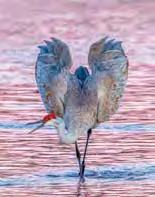
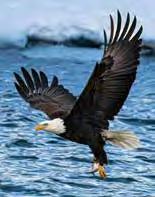

February 2024). Valley did buy the patent from Mr. Zybach, and they did make improvements to that design; however, it was Richard Reinke who made the biggest improvement by making it electrical and reversible. A link to our web page regarding this is reinke.com/company-history.html
If ever interested in learning more about Richard and what his legacy meant to agricultural production, please just let me know. We would be happy to help. Keep up the good work. Great magazine.
Chris Roth President, Reinke Manufacturing Co. Deschler
There is always something new to learn about our Nebraska neighbors and the November/December 2023 issue was packed full of interesting and new information for me. I loved hearing about the creativity of Nebraskan Pat Coldiron packaging her ideas to go in Little Brown Box Tours.
Another new bit of whimsical information were the “life-size, black and white villagers” at the intersection U.S. 183 and Nebraska Hwy 91 in Taylor (“The Villagers of Taylor stop traffic,” January/February 2024). They make me
consider taking a road trip again!
I love this magazine for the depth of coverage of all the people and places of Nebraska.
Debbie Flower Omaha
Origin of famous hymn “Forging a Faith” (January/February 2024) was a well-written accurate description of the exodus westward of Mormon people (members of The Church of Jesus Christ of Latter-day Saints) from Nauvoo, Illinois.
When William Clayton wrote “Come, Come Ye Saints,” he was in Iowa in a campground. The exact spot had never been proven. That is, until one man decided to prove where Clayton was camped. Elbert “Pid” Pidcock, retired letter carrier and avid history buff, set out to prove the hymn’s birthplace.
Pidcock used diaries, historical newspaper accounts, journals, legal documents and any verifiable source to prove what he suspected. He and wife Thelma walked the aging wagon ruts across Wayne County. When he had assembled his proof of the place the hymn was written, the proof then went to Salt Lake City, Utah.
Please send us your letters and emails by July 15, 2024, for possible publication. One lucky winner selected at random will receive a free 1-year subscription renewal. This issue’s winner is Debbie Flower of Omaha. Email editor@nebraskalife.com or write by mail to the address at the front of this magazine. Thanks for reading and subscribing!
The Church agreed that Pidcock knew and proved where the song was written. The public may visit the site from southwest of Seymour, Iowa. Highway J46 is well marked.
The summer after the proving, busloads of Church members visited the site and the Prairie Trails Museum in Corydon, Iowa. There they saw the extensive Mormon Trail display and listened to a recording of “Come, Come Ye Saints” by the Mormon Tabernacle Choir.
Pid and Thelma have passed on but what he proved added greatly to Wayne County Mormon Trail, and Iowa history. What a contribution! I was proud to call them friends.
Nancy Hamar Pleasant Hill, Missouri
Editor’s note – We found the recording on YouTube. Listen to the Choir perform “Come, Come Ye Saints” at www.tinyurl. com/comesaints
Summer in Central Nebraska I grew up in Central Nebraska. I learned how to drive the tractor while dad would pick up bales of hay and stack ’em on the flat bed. I learned how to drive a junker of a car. A 4-door, so when turning a corner or hitting a bump, all the doors came open – and at times the trunk too. All before going to DMV. Helping family put up sweet corn and shelling black walnuts. Riding Pedal bike over dirt roads – 8 ¾ miles one way. Always knowing where to stop and get a drink.
Being entered in parades in Gothenburg, Cozad and North Platte. Being dressed up as a majorette, a clown, a TV set with antennas. Lots of ribbons and prizes won.
On hot days, going swimming in the irrigation ditch (flume) – cut-offs required. Hauling water from house to shed to wash clothes, using the old wringer washers. Then hanging them on
clothesline “No under clothes allowed.” Drinking water out of a garden hose. And surviving it all. These are some of my many memories.
A friend subscribed to your magazine to be sent to me. Love it – read from front to back.
P.S. I will always call Nebraska Home.
Lynette Smith Denver, Colorado
In the Trivia photo identification on page 57 of the March-May 2024 issue, we incorrectly identified Arbor Lodge State Historical Park as Lied Lodge (photo on page 20).
We invite every Nebraskan to visit both landmark locations in Nebraska City this summer.
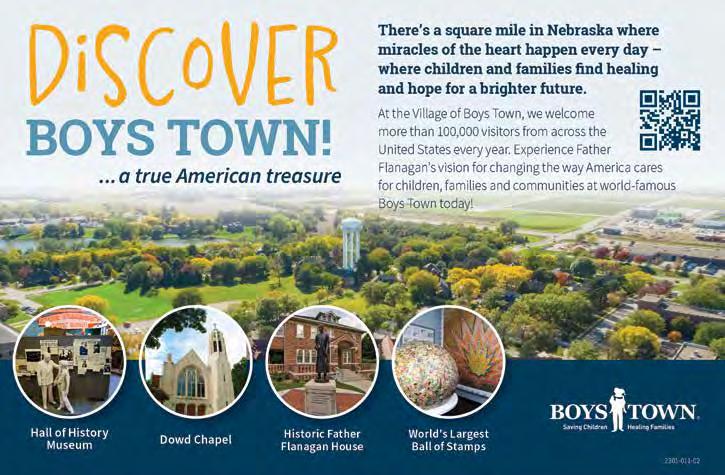
by ALAN J. BARTELS
What is more than twice as fast as a cheetah and can be seen darting as a blur through Omaha’s skyline? No, it’s not airplanes flying in and out of Eppley Airfield or fly balls from the College World Series at TD Ameritrade Park. It’s the peregrine falcon.
Since 1988, the WoodmenLife building in Omaha has served as critical falcon habitat. More than 80 young have
hatched from the 28th floor nest box, boosting the recovery of the once-endangered species. Peregrine falcons hunt other birds for food and have been recorded in dives of more than 240 miles per hour. The species also has nested atop the state Capitol in Lincoln.
A webcam mounted on the WoodmenLife Tower allows people to watch the eggs hatch, the young grow and eventually fly away.
To track the peregrine falcon recovery,
members of Fontenelle Forest’s Raptor Recovery team will fit leg bands to young falcons that hatch atop WoodmenLife Tower this summer. Don’t worry, the few grams of added weight won’t slow these speedy Omaha birds down one bit.
Falcon watchers follow along at www. WoodmenLife.org/falcons.
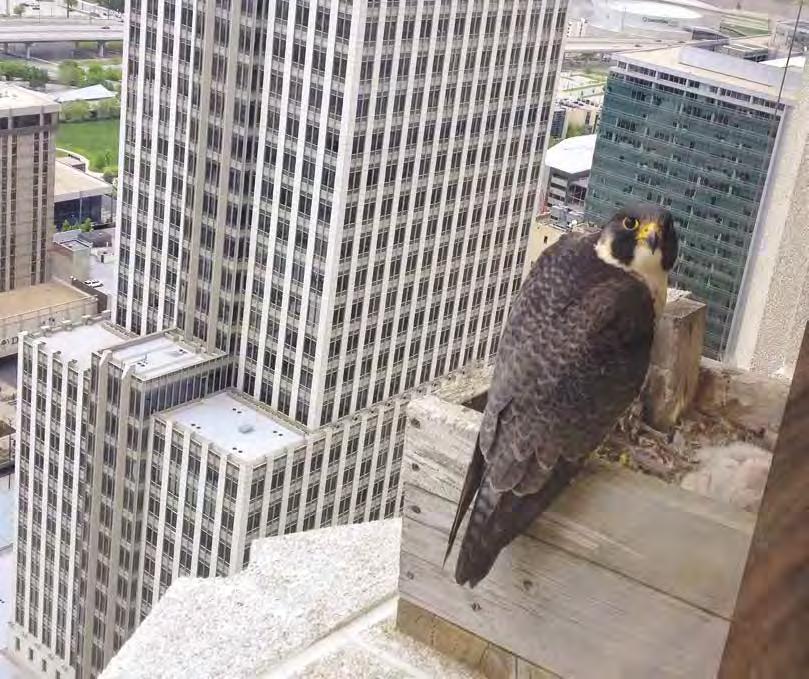
Peregrine falcons began nesting on the WoodmenLife Tower in Omaha in 1992 and have since hatched over 80 young.
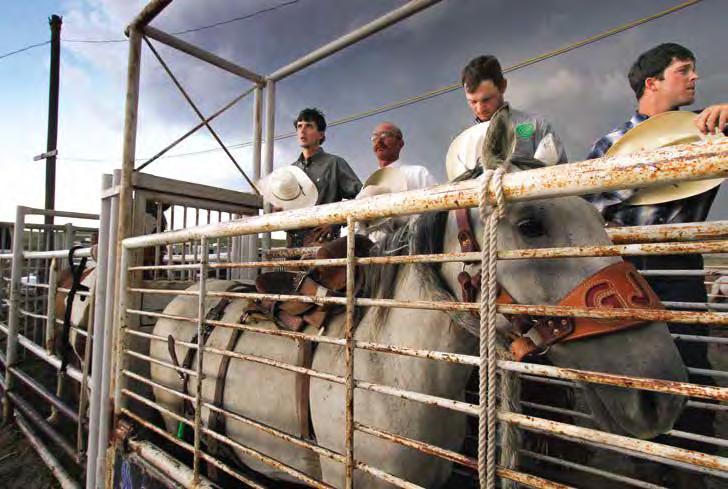
by ALAN J. BARTELS
Covering approximately 20,000 square miles of north central and western Nebraska, the Sandhills region is immense. The area is so rich with natural landscapes, wildlife, geology, hydrology, history, culture, and people whose familial connections to the region span generations that a printed volume of 20,000 pages could fall short of authoritatively telling its story.
The simply titled The Nebraska Sandhills fills just 259 pages. But the new release from University of Nebraska Press is a multi-faceted chronicle of the Western Hemisphere’s largest grass-stabilized dune field.
and additional agencies and institutions. They present essays about geology, range and forage, entomology, herpetology, ecology, climate, atmospheric sciences, botany, virology, archaeology and geography – to name a few. The voices of indigenous writers also rise from the text.
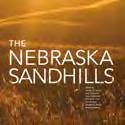
Experts lead this narrative, many from the University of Nebraska, others from the Nebraska Game and Parks Commission
The book digs deep to answer the common query, “How old are the Sandhills?”
The writers then go deeper, revealing the age of the oldest grains of sand, and how and when they were assembled into the monumental dunes we know today.
Other essays seemingly sift from that sand – like Loup County rancher Sarah Sortum’s descriptive account of a year in the life of a Sandhills ranch family. Seasoned ranchers who’ve attached their share of ear tags to still wet newborn calves know what Sortum means when
describing the “dragon stare” warning of a protective mother heifer standing guard over her progeny.
Through her earthy and honest account, Sortum honors her family, the animals they rely on, the land, and the old Sandhills ranchers whose “bodies have broken down over the years as they gave themselves to their work, to the land.”
Initial efforts in creating the book were modeled after the University of Nebraska’s 1989 seminal book An Atlas of the Sand Hills, according to editor Kim Hachiya. Like that book, this one is profuse with detailed, colorful maps depicting Sandhills topography, dune types, water table elevation and other graphical elements.
“Our goal was to be comprehensive but not encyclopedic,” Hachiya said. “We wanted to give folks a good introduction to the Sandhills and whet their curiosity to learn more.”

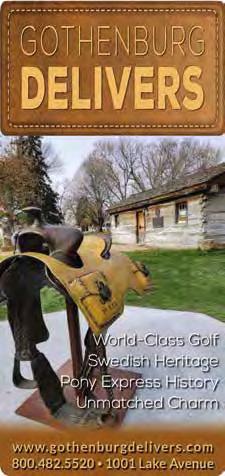

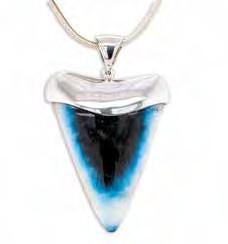


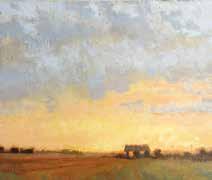

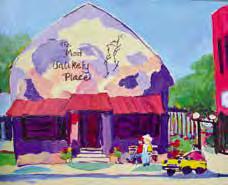
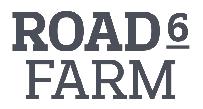
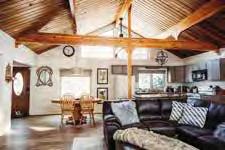



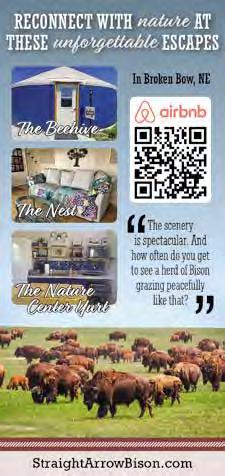

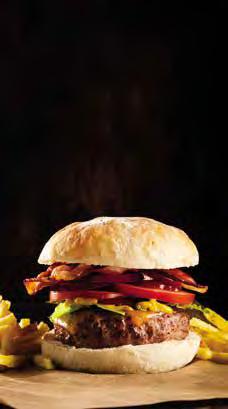
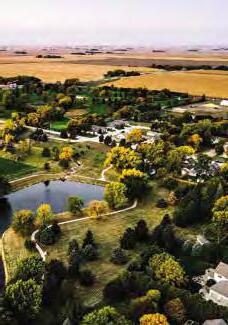

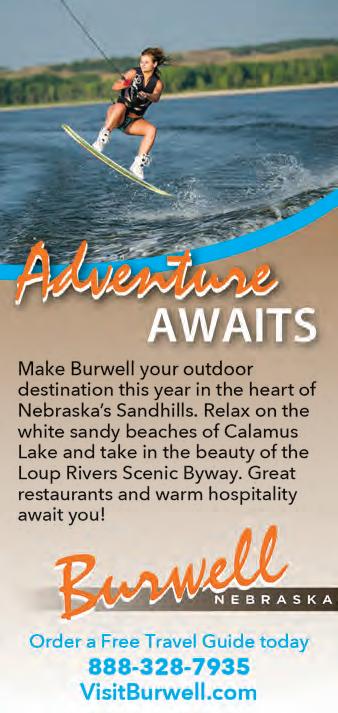
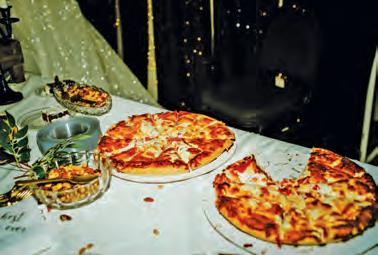

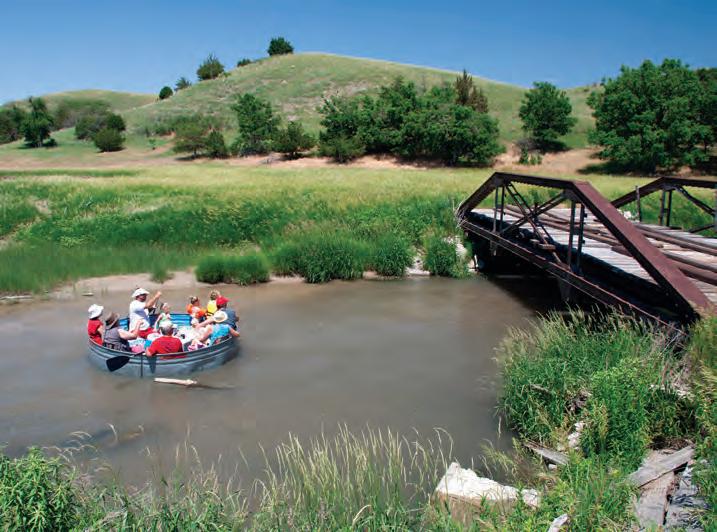
1 In 1804, the Lewis and Clark expedition had a tough time with sand at the mouth of the Platte. Today you can see that spot in what aptly named town of 6,600?
2
Listed soon after Niagara in a nationwide alphabetical index, the Ponca word for “spread-out water” provides the name of what Nebraska river with its own state park?
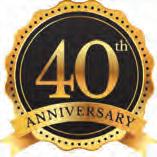
3 All the forks of the Republican River originate in what neighboring state, which coincidentally has gone blue in each of the last four presidential elections?
4 What two-word phrase is bad news on Wall Street but is an economic boon for river outfitters in the Sandhills?
No peeking, answers on page 53.
5 Merritt Reservoir in Cherry County is supplied by two waterways, the Snake River and Boardman Creek. Which of these two waterways continues past Merritt Dam to flow into the Niobrara River?
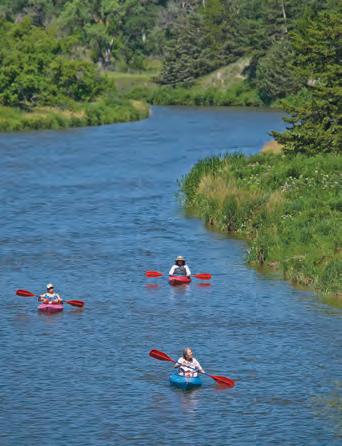
6 Nebraska is named after the Platte River.
7 The Little Blue River and the Big Blue River both start in Nebraska but don’t meet until they reach Blue Rapids, Kansas.
8 The Nishnabotna River got its name from a band of Russian settlers.
9 The Loup River gets its name from the magnifying glasses that frontier jewelers used to assess its mineral deposits.
10
Lined up from end to end, all the rivers, creeks and streams in Nebraska would circle the Earth three times.
11
The Omaha people migrated west from what non-Nebraska river valley?
a. Hudson
b. Ohio
c. Suwannee
12
Found throughout Nebraska’s rivers – not to mention the whole eastern two-thirds of the United States – what is the official state fish?
a. Bluegill
b. Channel catfish
c. Northern pike
13
Predictably situated on the Dismal River, the Dismal River Golf Club was designed by what legend?
a. Pete Dye
b. Bobby Jones
c. Jack Nicklaus
14
The Salt Creek, which flows through Lincoln before reaching the Platte River is home to what endangered creature?
a. Salt Creek tiger beetle
b. American burying beetle
c. Scaleshale mussel
15
Of three historic mills that are now museums, which one no longer has a river or creek running nearby?
a. Neligh Mill
b. Florence Mill
c. Champion Mill
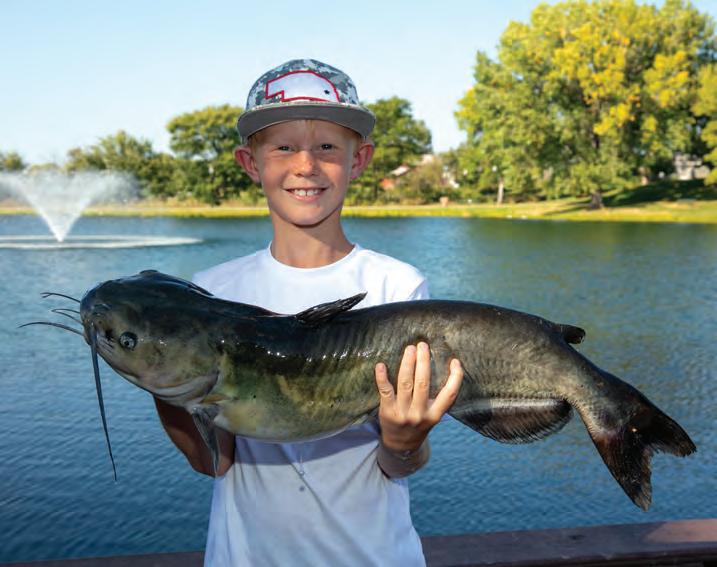
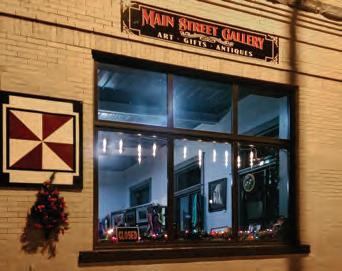
Spring is in the air new work arriving, new artist with wonderful work have joined us.
Explore the heart of Nebraska’s fine art at Main Street Gallery.
Open Wed-Sat, 10 am-5 pm or by appointment. dynomitered.61@gmail.com
308-219-0382 • Join us on 414 1st St • North Loup, NE

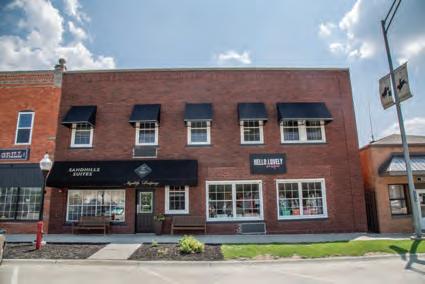
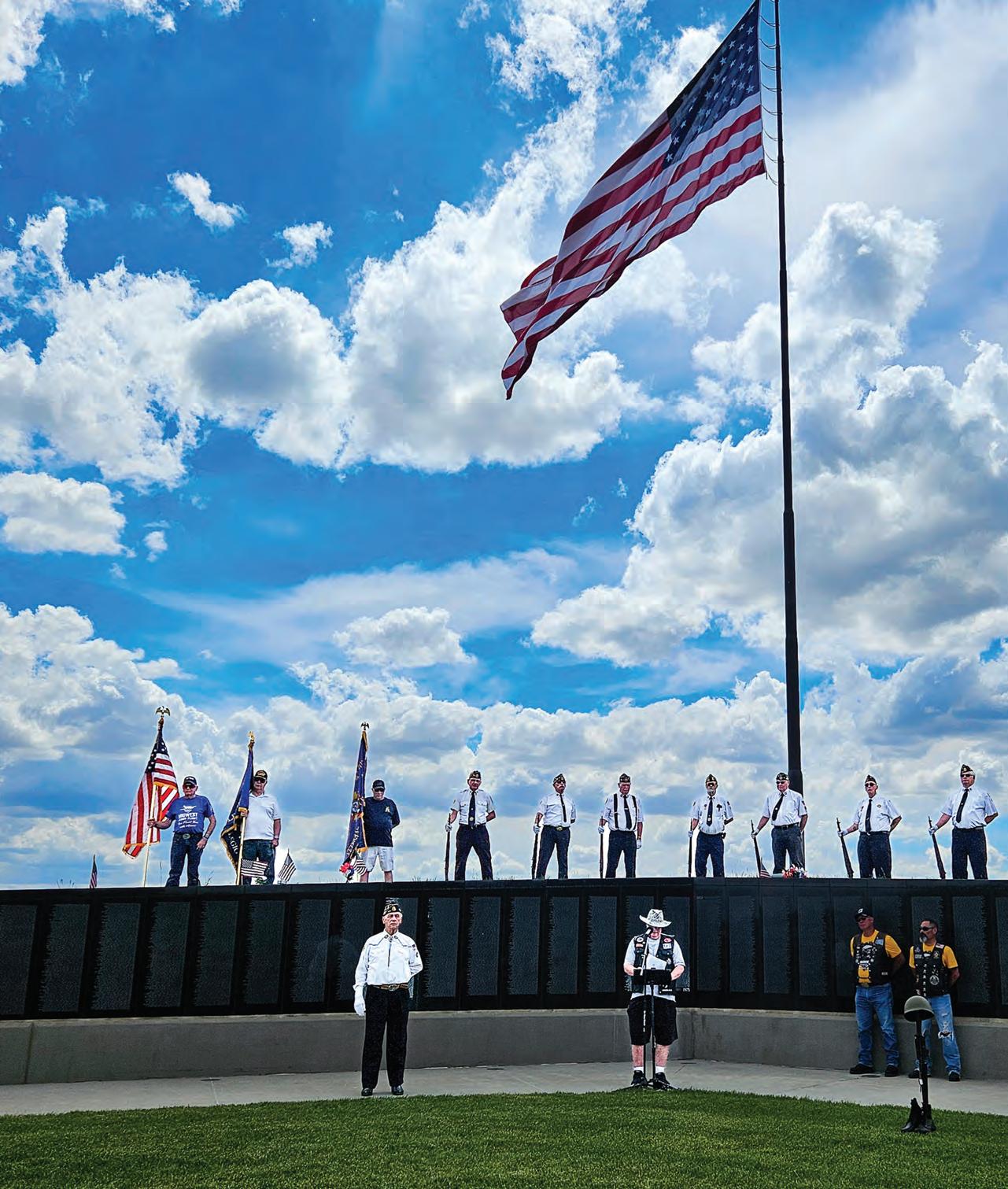
American Legion members and Legion Riders stand guard over the Vietnam Veterans
in
The complex honors veterans with three memorials and an indoor interpretive center.
at


by TIM TRUDELL & TOM HESS photographs by LORI RISDAL
SOUTH SIOUX CITY and Washington, D.C. are more than 1,000 miles apart, and even farther apart in population and culture, but there’s something they share: three memorials to war dead. They are sisters in remembrance.
At the Siouxland Freedom Park in South Sioux City is a half-scale replica of the Vietnam Memorial in Washington, with all 58,272 names inscribed – 99 of them from the Siouxland area, just like the one in the nation’s capital. Among those names is a Lincoln native, one of nearly 400 Nebraskans who died in the southeast Asian conflict.
With bullets whizzing past, Lincoln-born Army Specialist Four Jerry Cozad stood behind the big gun in the jungles of Cambodia, firing off rounds toward the enemy, unsure if they were hitting their targets. Then, a month shy of his 21st birthday, he was hit by a bullet. Cozad died from his wounds on May 16, 1970. His name is found in section 10w, line 47 of both walls in South Sioux City and Washington.
Growing up in Lincoln, Lynn Fuller never knew her Uncle Jerry. Still, she wondered how her family’s life would have changed had he survived. The Lincoln Northeast High School graduate wrote a letter on the Vietnam Veterans Memorial Fund website.
“On days like today (Memorial Day 2017), all the ‘what ifs’ flood my mind,” Fuller wrote. Knowing Jerry Cozad’s name on the wall provides comfort, appreciating that her uncle has been recognized for his service to the country. South Sioux City’s wall was dedicated in 2014.
Her father, Keith, a Marine veteran, raises the flag every military-related hol-
iday, missing his brother: Jerry and Gary, who was paralyzed after his vehicle hit a landmine in Vietnam and later died after returning home. Her family continues to honor her relatives on holidays.
Driving by Freedom Park, located about a stone’s throw from the Missouri River, it’s common to see a solitary figure at night, leaning against the memorial or pressing a hand next to a name. For some, it’s a private moment remembering one of the most difficult – if not the toughest –times of their lives. Fighting a determined enemy in jungles 8,000 miles from home, and knowing the war was unpopular, they endured. Coming back, it has taken decades for their service to be recognized and honored.
Attending a traveling exhibit of the wall about 20 years ago in Sioux City, Iowa, Mike Newhouse, president of the park foundation, and a few other people realized the Siouxland area needed an exhibit that wouldn’t travel. They set about to make a permanent installation happen, raising millions from large donations to schoolchildren’s spare quarters.
Vietnam War dead aren’t the only ones remembered at Freedom Park. The “Forgotten War” – Korea – is remembered, too, with two-dimensional replicas of the 3D soldiers depicted in Washington, trudging through the muck and mire of a two-year-long war that ended in stalemate. Night visitors to Freedom Park’s Korea exhibit, dedicated in 2023, can find those soldiers walking through an illuminated rice field, offering a ghostly and breathtaking experience.
Beyond the memorials, visitors get an up-close look at war and its impact, as area veterans share personal stories
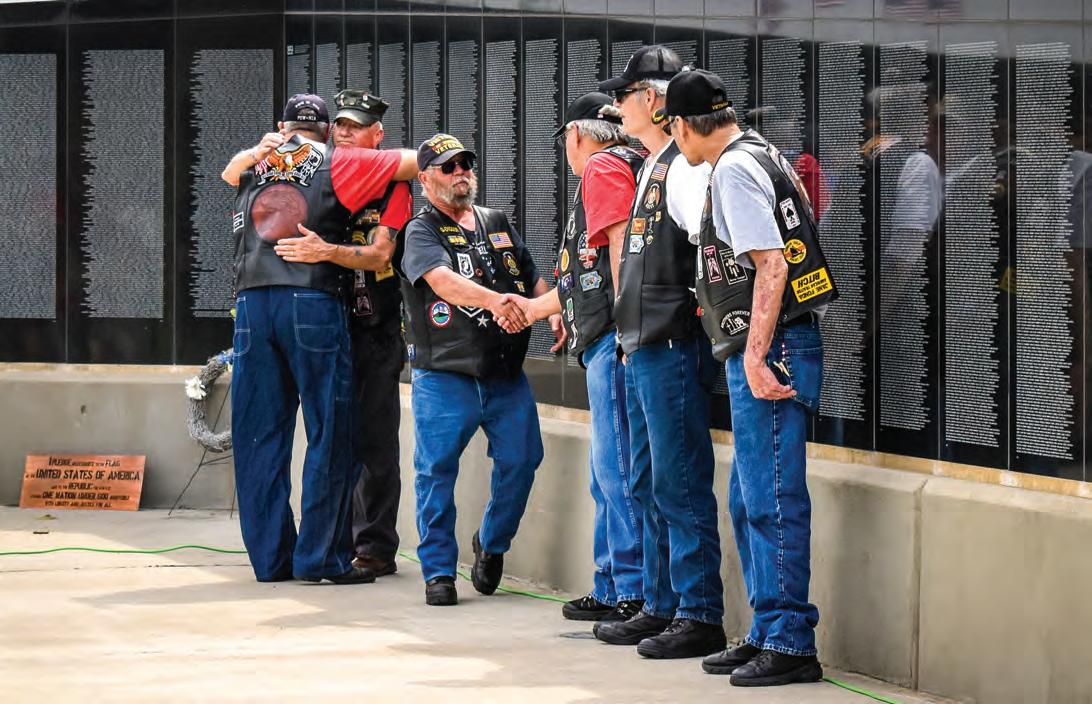
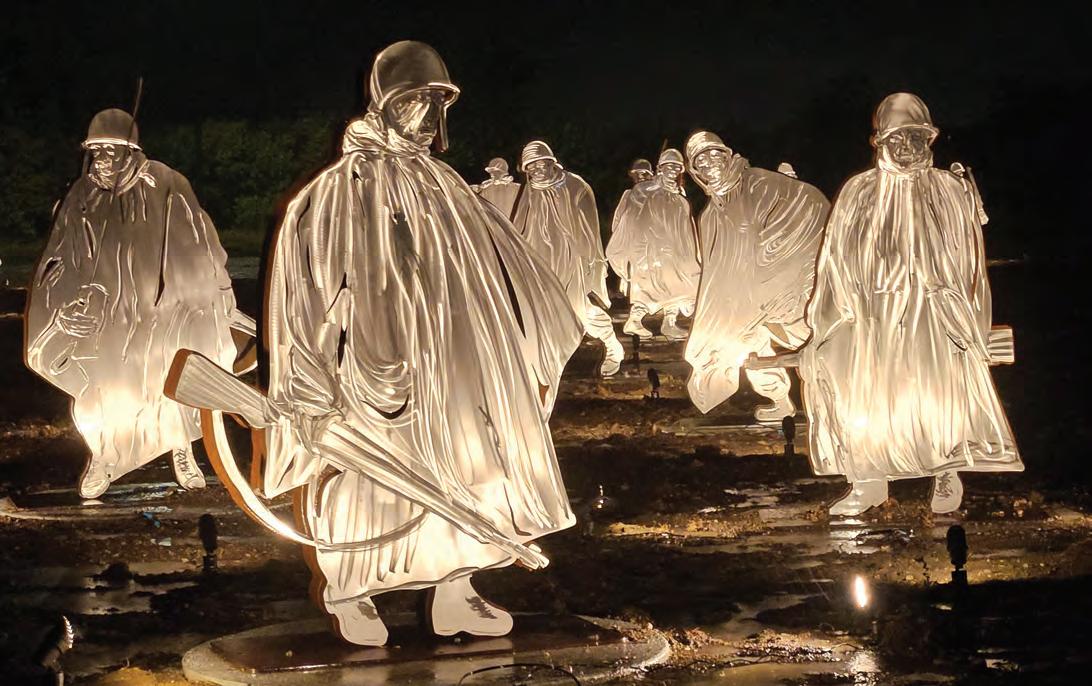
through a series of videos at the Brigadier General Bud and Doris Day Interpretive Center. Military uniforms, Army boots, a cavalry hat and helmets highlight personal memorabilia at the center. A mural showcasing a timeline of American wars is also located at the center.
John Rice, an enrolled citizen of the Winnebago Tribe of Nebraska, died during the Korean War. Denied a burial spot at Sioux City cemeteries because he was Indigenous, President Harry S. Truman ordered Rice buried with honors at Arlington Cemetery in Washington. Rice appears along with several area military personnel on the Freedom Rock near the Freedom Park interpretive center. The Freedom Rock is the first to appear outside of Iowa, created by Iowan Bubba Sorensen, who painted Freedom Rocks for his state’s 99 counties.
Once a 55-acre dumping ground, the Freedom Park includes the Memorial Dog Park named in honor of fallen Navy
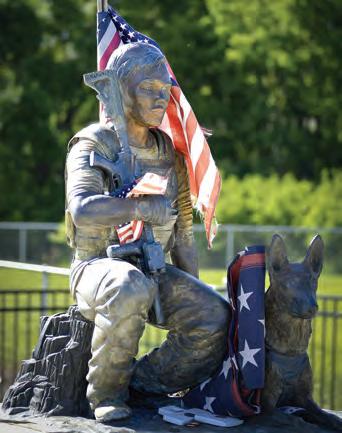
SEAL Team Six member John Douangdara. He and his War Dog, Bart, and 29 fellow service members died in 2011 when their CH-47 Chinook helicopter crashed after a rocket-launched grenade disabled it on Aug. 6, 2011, in the Wardak Province of Afghanistan, the costliest day in SEAL Team Six history.
The son of Laotian immigrants and a 2003 graduate of South Sioux City High
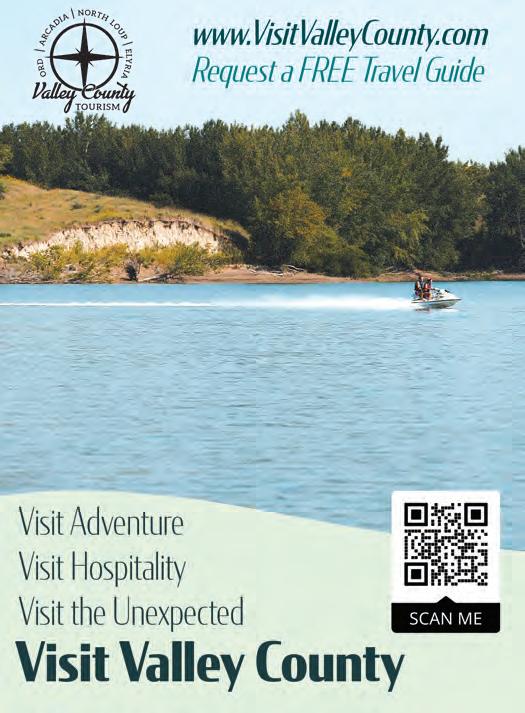
School, Douangdara handled Bart, a Belgian Malinois, for SEAL Team Six. He is buried at Arlington National Cemetery, “so he’s not close to home,” said his sister, Ghan Follen, at Freedom Park’s groundbreaking in 2012. “We wanted something that would be of him, close to home.”
Freedom Park welcomes leashed dogs and their owners. Dog owners approve. The park receives five-bone reviews on the BringFido website. The dog park includes a replica of a statue of Douangdara and Bart at the U.S. Navy Memorial Visitors’ Center in Washington, 1,200 miles away. Follen was on hand for the 2021 dedication of her brother’s Washington statue, titled “Service and Sacrifice,” commissioned by the U.S. War Dogs Association. Most Navy SEAL dogs are Malinois. That includes Cairo, who helped SEAL Team Six kill Al Qaeda leader Osama bin Laden at his compound in Pakistan on May 2, 2011, three months before the helicopter carrying Douangdara and Bart went down.
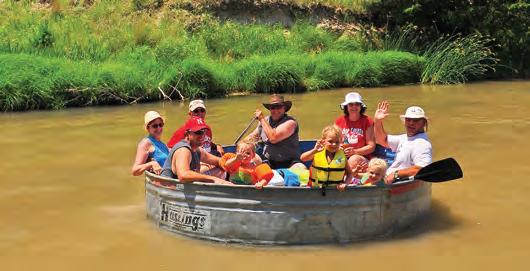

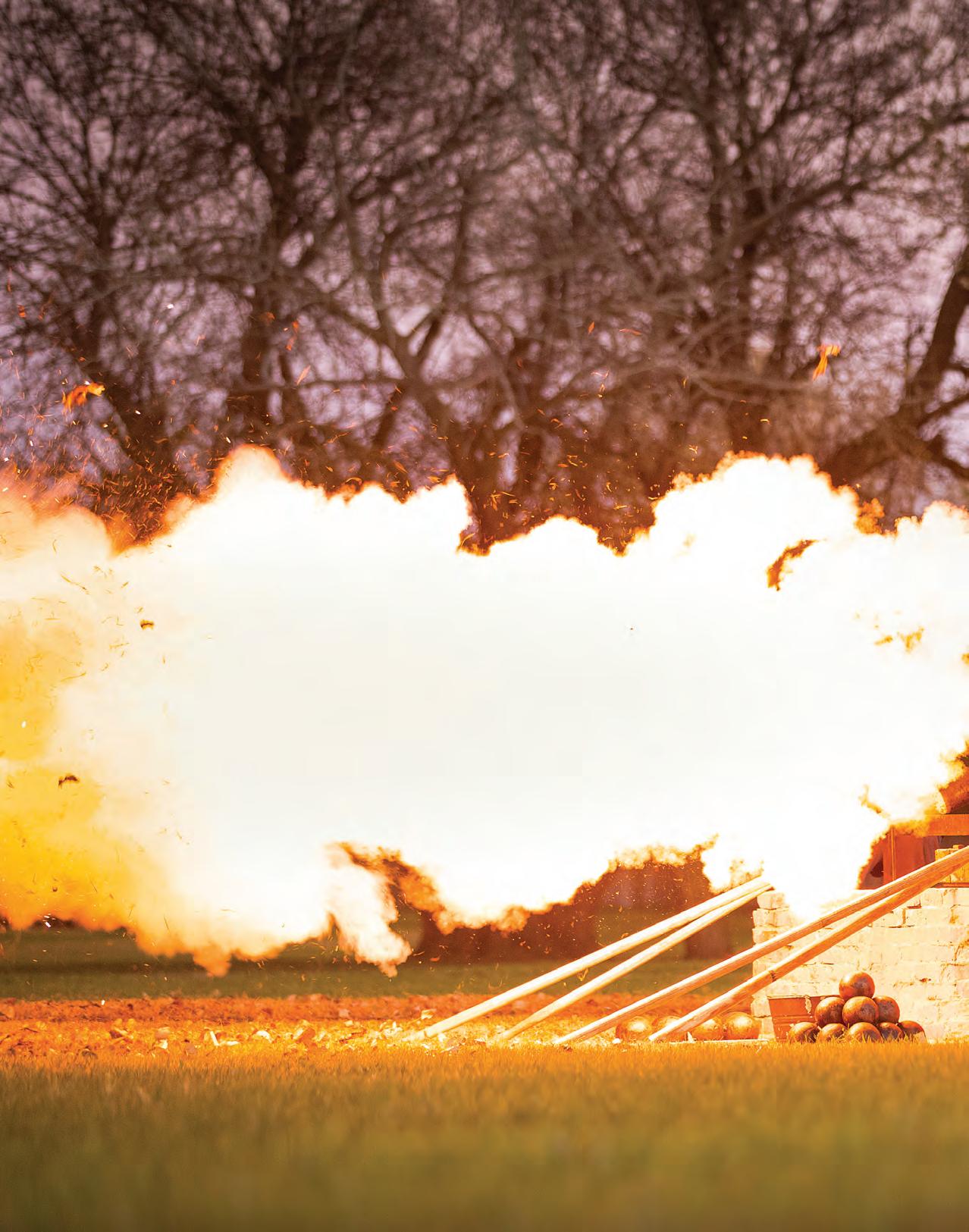
by LAUREN WARRING
Nebraskan heritage comes to life at these historic forts, farms and museums.
Travel back in time to see a battle, learn a frontier skill or taste what’s for dinner.
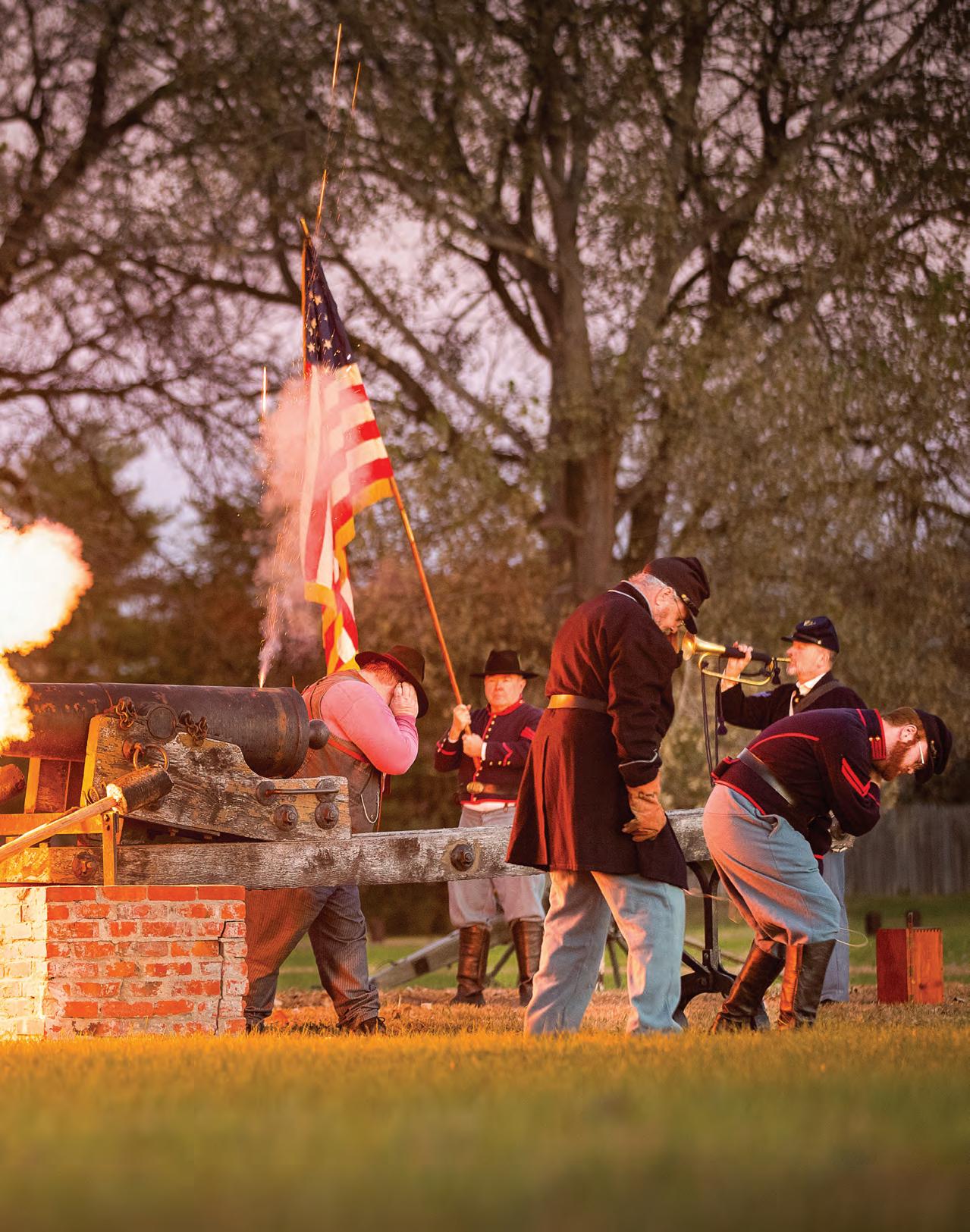
Living-history
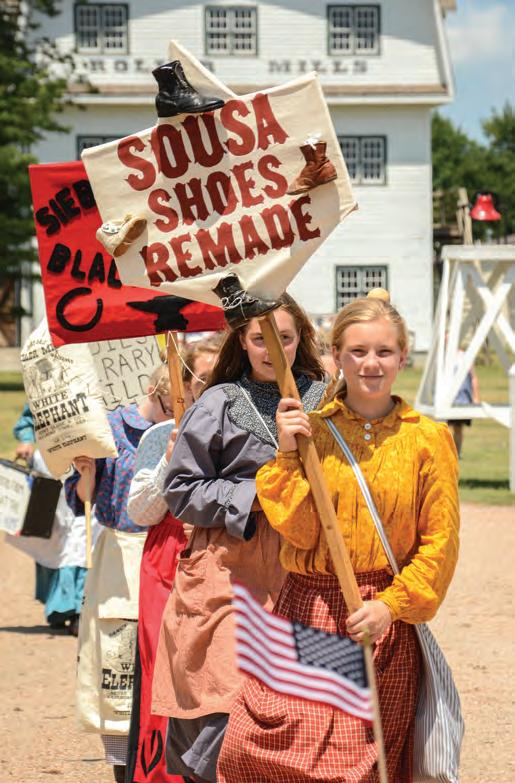
NEBRASKA DOES history differently – it’s hands-on, tangible and active. From dusk cannon fires to blacksmiths to heritage festivals, there is no shortage of history events across the state. Here are seven places in Nebraska where you can experience living history firsthand.
Stuhr Museum, Grand Island
Railroad Town is pretty busy for a town with no residents. It’s not abandoned nor a ghost town – but a walkable life-size frontier town part of the Stuhr Museum in Grand Island. More than 60 structures stand as a representation of prairie towns circa 1890s.
Every summer day, Railroad Town comes alive as volunteer living historians crowd the streets. Children play jack-
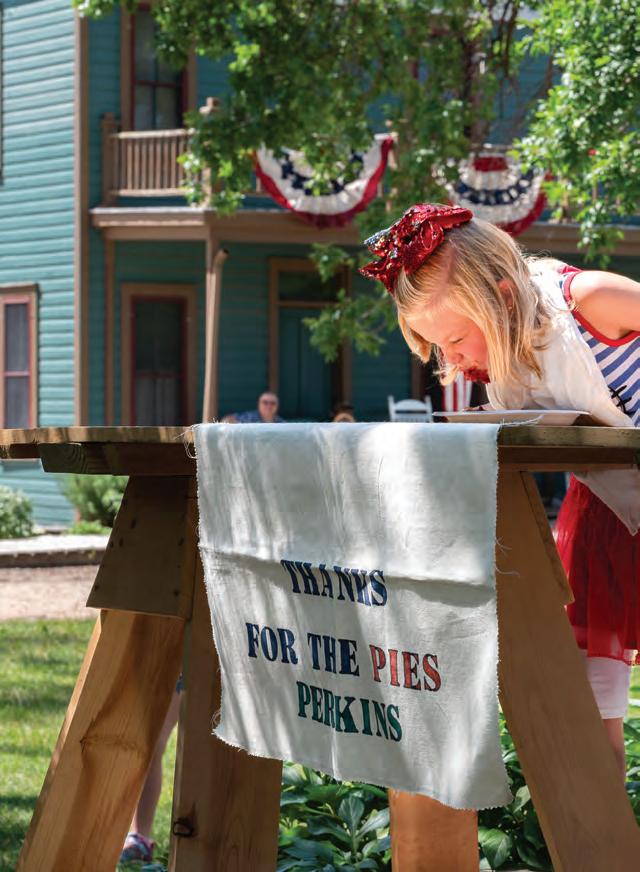
straws on the lawn. The blacksmith fires the forge and pounds steel on the anvil. A post man sifts through the mail at the post office. A shopkeeper opens the General Mercantile Emporium and counts bills. Students walk down Depot Street for class at the one-room Peters schoolhouse.
Women and girls wear gigot sleeved dresses while the men and boys adorn their button-ups with vests and suspenders. It’s 1890s life as it was – work, play, dress and all.
While guests may not look like a pioneer, they are encouraged to engage in 1890s life: learn how the tinsmith makes tin cans, play croquet at the Milisen House, tend to the herb garden at the doctor’s house, write a letter at the post office – and even read real stories first published in the 1890s in the latest issue of the Platte Valley Independent
The newspaper isn’t the only real his-
torical record – all the homes along the town’s four-city blocks are original to Grand Island. Bell Cottage on College Street is the birthplace of Oscar-winning actor Henry Fonda. His family rented the home on 622 W. Division St. in 1904 from banker George B. Bell. The green 1884 house continues to portray a small rental cottage from the 1890s, telling the story of middle-class families in Nebraska.
Many of Railroad Town’s 60 structures are also original artifacts from Grand Island. Front Street features the most buildings in town with an 1890s telephone exchange, Elftman’s Barber Shop, A. J. Sousa Shoe Shop, Kechely Bank, Marshal’s Office and the Wm Siebler Blacksmith Shop.
The living historians who interpret Railroad Town’s frontier life are local volunteers and employees trained by the museum. Youth as early as fifth grade join the town’s history as living-history
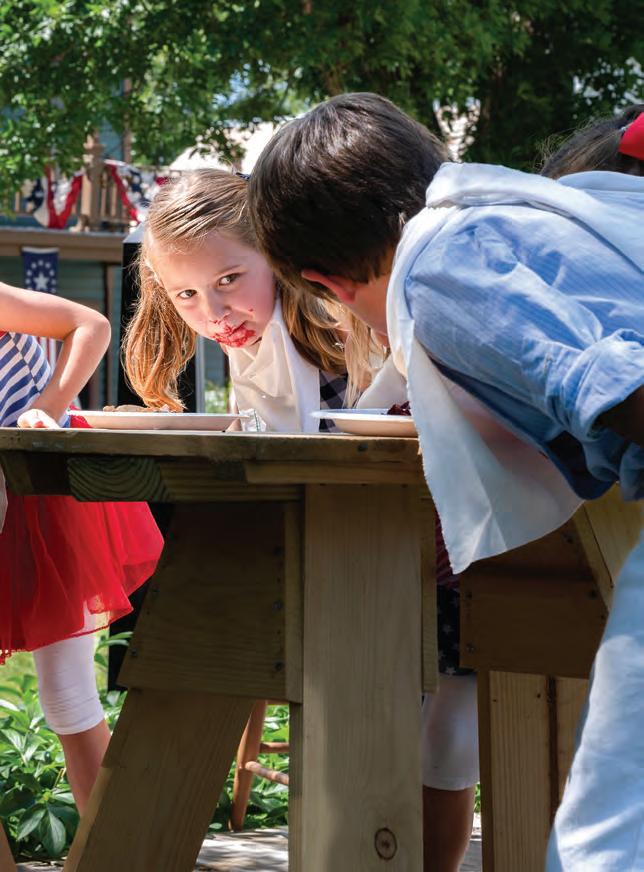
Living-history apprentices at Stuhr Museum interpret 1890s life, dress and characters. Apprentices often become historical interpreters like Devin Rathman (top right), working fulltime in Railroad Town and teaching skills and history during the museum’s summer classes.
apprentices. Apprentices join other historical interpreters every July for Railroad Town’s 1894 Independence Day.
Grab a frozen pickle juice from the Silver Dollar and celebrate America’s independence as it was 130 years ago.
Missouri River Basin Lewis & Clark Visitors Center, Nebraska City
President Thomas Jefferson was always curious of the west and the untapped frontier that awaited. With the Louisiana Purchase in 1803, official exploration of the land began. Jefferson commissioned an expedition to find new trade routes, establish positive relations with the Native
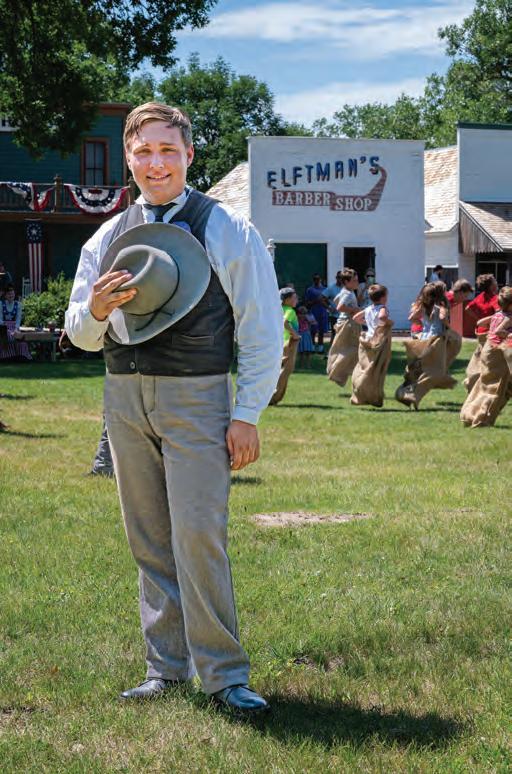
American tribes and study the land and climate of the West.
Jefferson selected two military officers to lead the expedition: Captains Meriwether Lewis and William Clark. For two and a half years, the Corps of Discovery traveled through the West marking their discoveries and meetings with Native American Tribes, including their journey along the eastern edge of Nebraska.
In July of 1804, Lewis and Clark arrived near present-day Nebraska City along the Missouri River. Overlooking the very route the captains took over 200 years ago, the Missouri River Basin Lewis & Clark Visitor Center details the captains’ scientific discoveries during their 8,000-mile journey.
Lewis and Clark systematically documented their discoveries and recorded at least 178 plants and 122 animals during the expedition. Life-size animals round each corner of the 12,000 square foot center
Stuhr Museum’s Railroad Town is a prairie town with over 60 structures, representing frontier life, culture and businesses during the 1890s.
while interactive displays sing bird songs for identification and categorization.
Every month throughout the summer, the center hosts Saturdays with a Soldier: reenactors represent members of the Corps of Discovery and share stories of daily life on the expedition. Visitors join demonstrations that include tomahawk throwing, musket shooting and hide scraping. After testing their throw against the reenactors’, guests explore the full-size replica of a flat-bottomed keelboat. Children and adults climb on board the 55-foot vessel to learn the strength it took to paddle upstream and travel over 4,000 miles of rivers.
The center celebrates its 20th anniversary Aug. 23-25 as reenactors portraying expedition soldiers, French engagés, blacksmiths and mountain men inspire visitors to explore and be curious – just like Lewis, Clark and Jefferson 220 years ago.
Fort Atkinson was Nebraska Territory’s first military post, school, library and large-scale agricultural operation. Troops arrived in 1819 and built the fort in 1820 to primarily protect the American Fur Trade but also maintained a self-sufficient community west of the Missouri River.
Fort Atkinson was home to two primary military regiments: the Sixth Infantry and the Rifle Regiment, both represented by distinct uniforms at the fort’s livinghistory demonstrations. The Sixth Infantry, named “The Regulars,” served from 1819 to 1827, the entire tenure at the fort. The Rifle Regiment, or the “Rifles,” was a group of specially trained long-range sharpshooters who served the fort until 1821 when it dissolved into the Sixth Infantry.
At its peak, Fort Atkinson housed onefourth of the standing United States Army – nearly 1,200 troops – under the command of Col. Henry Atkinson. During living-history demonstrations, the Regulars are recognized for their blue wool
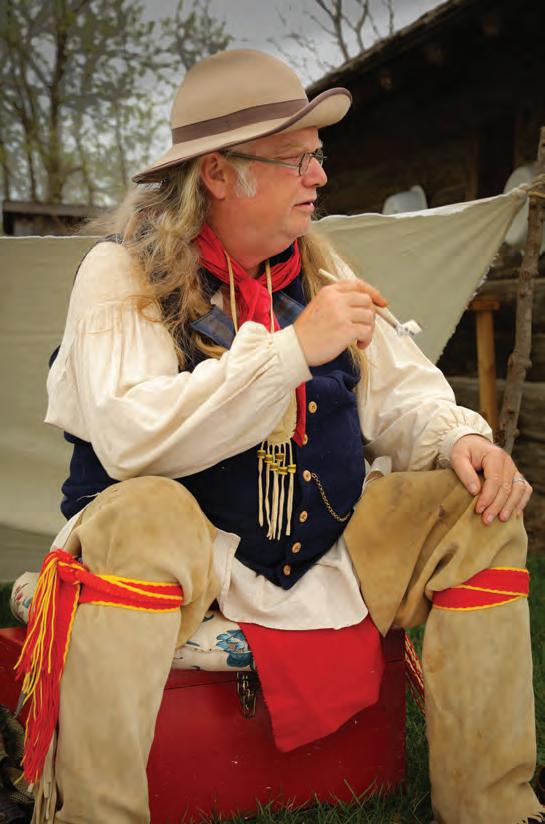
dress coatee and a .69 caliber smoothbore, flintlock musket. Rifles wear green linen frocks with yellow fringe and bear Harpers Ferry Model 1803 rifles.
Self-sufficiency was essential to life at Fort Atkinson as supplies were limited and transportation was arduous. Daily work was largely agricultural to sustain the soldiers and civilians. Demonstrations at Fort Atkinson are representative of the tradesmen and practices that sustained the fort: carpenters, blacksmiths, sutlers, musicians, fur traders, tinsmith, laundresses and military personnel.
Reenactors at Fort Atkinson personify real soldiers and civilians who served at the fort – using carefully researched records from the National Archives. During candlelight tours in November, a docent leads guests through a third-person view

of evening life at the fort during the 1820s.
The fort continues to celebrate its bicentennial anniversary with living-history weekends throughout the year.
Fort Kearny was the first fort built to protect travelers along the Oregon-California Trail. Established in 1848 as Fort Childs, the U.S. War Department renamed the fort to honor Gen. Stephen Watts Kearny. Until 1871, the fort served as a supply depot, sentinel post, Pony Express Station, stage station, and protected workers building the Transcontinental Railroad.
Dedicated volunteers reenact life at Fort Kearny – and it’s a family affair. Not only did Fort Kearny host soldiers, workers
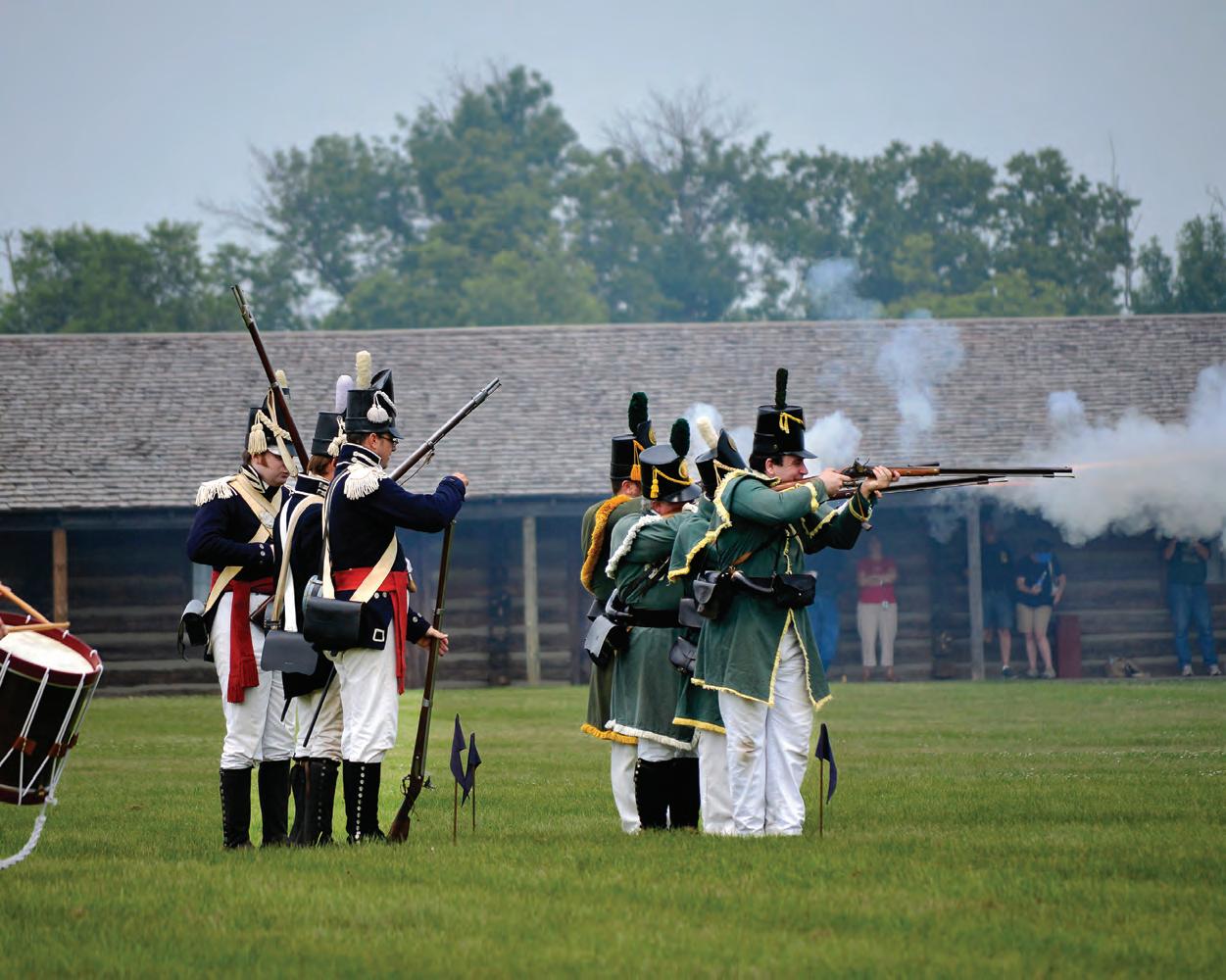
and Pony Express riders, but it was home to the soldiers’ families, dairy farmers and laundresses. Families reenact alongside the soldiers as the civilians that kept the fort fed, clean and company.
Every day is different as volunteers curate their own specialty with the characters they choose to represent, whether that is their speech, dress or profession. Guest may interact with wooden barrel makers to trappers to generals and laundresses – but a crowd favorite is nightly cannon fire during Labor Day weekend.
“When you’re watching a youngster, and they see a guy in an 1860s uniform, and they see a cannon go off, and there’s people around with these firearms – it’s a shock, but after a while they get comfortable, and you see their eyes opening up,” said Gene Hunt, Park Superintendent.
To fire an 1860s cannon, six military personnel must work in unison with precision to clean, load and fire the cannons. Debris and embers must be removed before another round is loaded. One man scrapes out large debris, careful not to ignite any residual gunpowder, while another wets a sponge to collect embers.
Once the barrel is dry, a round is prepped, approved by the sergeant and loaded. While the man walks the round to the barrel, he must use his body as a shield to avoid enemy fire. With a gentle tap, he pushes the round to the bottom. Another pricks the powder and inserts a friction primer. At the command of “fire,” the cannon ignites.
Booms echo throughout the grounds as five cannons blast one after another as the sun sets over Fort Kearny. “It really
Fort Atkinson was Nebraska’s first military post, school, library and largescale agricultural operation.
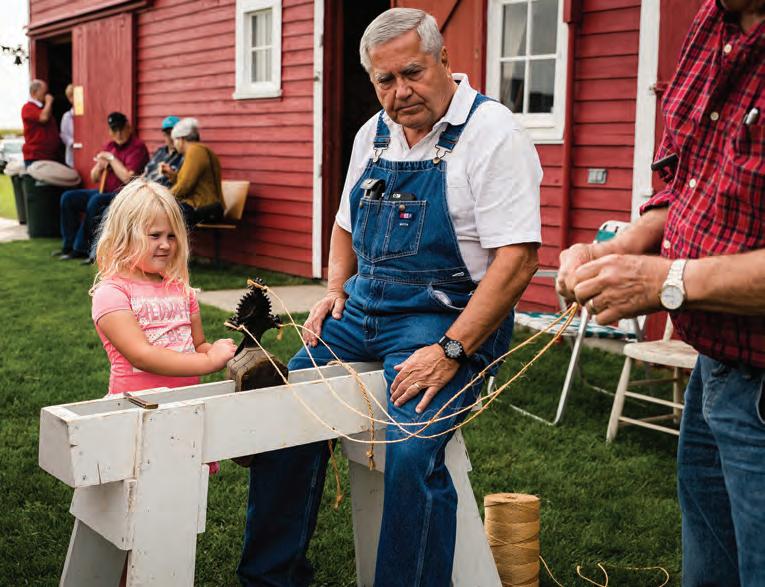
shows how dangerous these cannons were during the Civil War,” Hunt said.
Guests hear the crack of the barrel, smell the gunpowder and watch the smoke as the cannons fire on Aug. 30-Sept. 1.
Over 200 immigrants crowded into a narrow, roughly constructed Immigrant House in 1874. From grandparents to children, 35 families crammed into their new home and endured their first Nebraska winter. This September, Henderson Mennonite Heritage Park celebrates the journey and history of the 35 Mennonite families who immigrated from Russia and settled in Henderson 150 years ago.
Mennonite families in the Molotschna Colony in Russia sought peace and freedom to practice their beliefs. As Russia’s Minister of War Dmitry Milyutin pushed for mandatory military conscription, the families’ military exemption and religious freedoms were at risk. A delegation was sent ahead to scout America, and in 1874 they journeyed to America in search of a new home: Henderson.
The Henderson Mennonite Heritage Park began in 1998 on the 8.5-acre home-
stead of original setters Jacob and Anna Friesen. The Immigrant House was the first structure built as a replica of the original building built by the Burlington River Railroad – the families’ first home. Today, it houses a collection of artifacts from the journey including immigrant trunks, Russian clocks, family photos and Bibles.
Every September, Henderson celebrates the journey and history of its founding families during Heritage Day. Children attend country school in the fully restored District #73E country schoolhouse. Guests learn how to bake bread on an outdoor wood stove or get wet washing the laundry. Volunteers demonstrate how to rug braid and rope – and anyone can help press homemade apple cider.
Each building represents a part of Henderson’s history and its Mennonite community. The newest edition to the site is a reconstruction of a Country Mennonite Church that was built outside of Henderson in the late 1880s.
The Mennonite families created a home, community and lasting heritage in Henderson. Visitors join the 150th celebration on Sept. 14 to see one of the many communities that founded the great state of Nebraska.
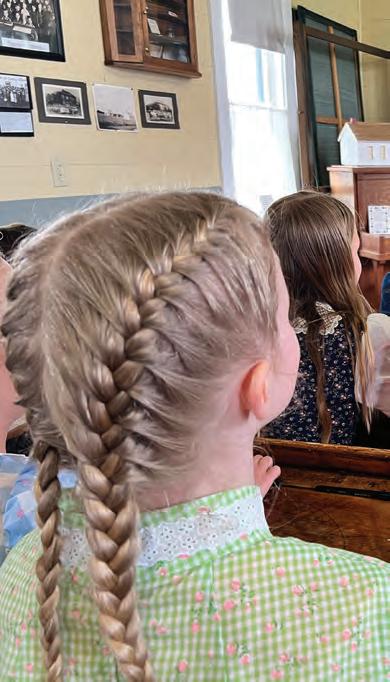
Nine of the original permanent buildings still stand at Fort Hartsuff. Known as the “prettiest post on the plains,” its lime structures preserve one of the most complete examples of forts during the Plains Indian Wars. This September marks 150 years since its establishment in 1874.
As settlers expanded west, tension arose between Native American tribes and the settlers. After Sioux attacks in October 1873 and January 1874, settlers asked for military protection. Construction began on Sept. 1, and was renamed that winter in honor of Gen. George L. Hartsuff. Soldiers patrolled the valley while the fort became a major employer and market for local farmers and construction workers.
This Labor Day weekend, life at the fort will be on display as reenactors from the First Nebraska Volunteer Infantry Regiment Company A and Fremont Pathfinders host military demonstrations like bayonet displays and cannon fires. Reenactors love to tell stories of the Plains Indian Wars and the Fort Hartsuff soldiers who protected homesteaders.
Original structures like the post headquarters, barracks, hospital, officer’s quar-
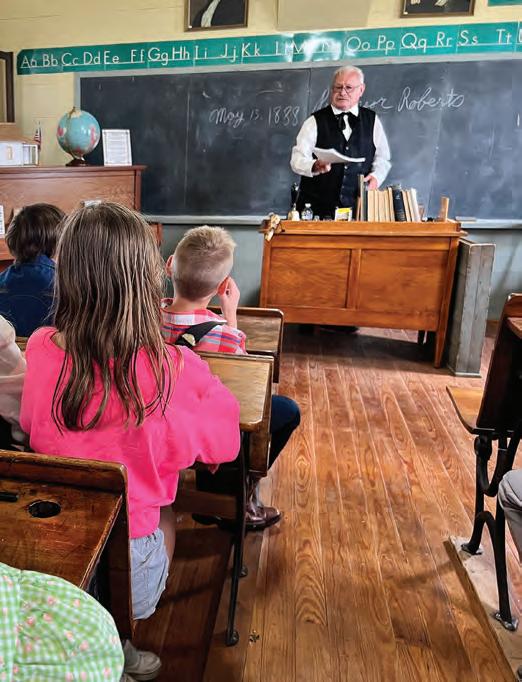
ters and quartermaster stable stand alongside reconstructions of the wagon scale, privy and blacksmith-carpenter shop. Reenactors fill the fort representing the military and civilians. Demonstrations can include blacksmithing, baking, laundressing – and even an 1870s doctor.
Guests celebrate the fort’s establishment on the exact date of construction and enjoy historical speakers, children’s activities and food vendors Aug. 31-Sept. 1.
David Wessels didn’t want the story of the American farmer to die with him. Life on the farm needed to be preserved and real for the next generation. In his will, he requested that a portion of his land and capital be used to construct and maintain Wessels Living History Farm at York.
Wessels wanted real, active history –get your hands dirty in the soil and learn about agriculture as it’s been done for generations. At Wessels Living History Farm, guests are put to work. Gather eggs from the hens. Handwash the laundry. Haul water from the 140-foot well. Shell corn for the chickens and pop some over
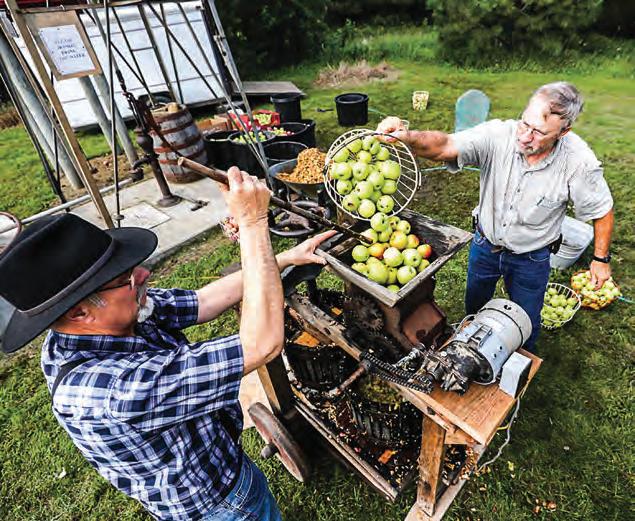
the wood burning stove as a little reward for your hard-earned history lesson.
The 160-acre site south of I-80 displays a 1920s farm typical to York County. Not only does it include Wessels’ house and original tractor building, but it features a collection of historic buildings gifted from members of the surrounding communities.
Bill Peters donated the 1920s red, timber barn from its home in Shelby. The granary, which belonged to Ralph Stuhr,
moved from its original location a couple miles west of Bradshaw. The 1905 church was a gift from the congregation of the Zion Lutheran Church from Thayer. The one-room schoolhouse relocated from its place in Sutton.
The farm and its volunteers tell a generational, collective story: grandmothers see the life of their parents, fathers relate to their grandparents’ stories and children see their heritage come to life by their own hands.
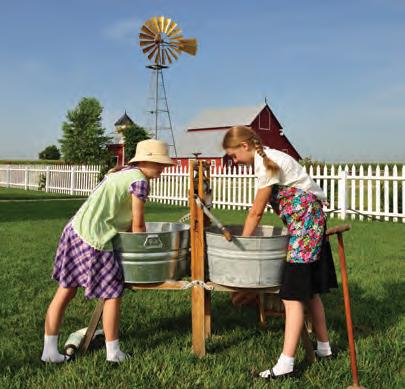
Director David Batty started volunteering after relating his own family history to the farm during a visit in 2018. “The wood burning stove is just like the one our grandmother had that she used ‘til the day she died,” Batty said.
Wessels Living History Farm preserves David Wessels’ dream and continues to educate visitors, young and old, on what it took to not just survive but enjoy the simple life as a Nebraska farmer.
At Wessels Living History Farm, sisters Sarah and Hannah handwash laundry, one of many hands-on chores that guests experience while learning about life in the 1920s.
BANCROFT
John G. Neihardt
State Historic Site p 70
BAYARD
Chimney Rock Museum p 37
BOYS TOWN Hall of History Museum/Historic Father Flanagan House p 15
BROKEN BOW
Custer County Museum p 36
CHADRON
Dawes County Historical Museum p36
Museum of the Fur Trade p 35
CRAWFORD
Trailside Museum p 8
DAVID CITY
Bone Creek Museum of Agrarian Art p 34
FORT CALHOUN
Washington County Museum p 35
FREMONT
Dodge County Historical Society Museum/Louis E. May Museum p 36
GRAND ISLAND
Stuhr Museum of the Prairie Pioneer p 37
HENDERSON
Henderson Mennonite Heritage Park p 51
KEARNEY Museum of Nebraska Art p 35
LA VISTA
Czech and Slovak Educational Center and Cultural Museum p 36
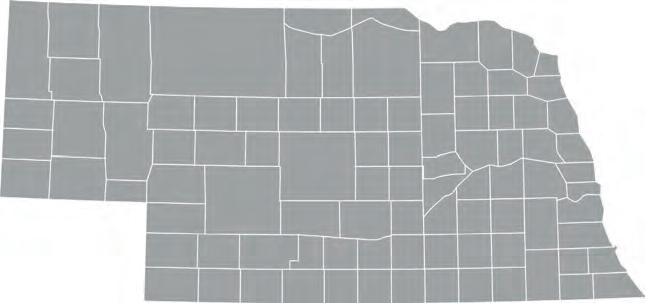
LINCOLN Morrill Hall p 8
MADISON
Madison County Museum p 37
NEBRASKA CITY
Wildwood Historic Center & Period House p 68
NELIGH
Pierson Wildlife Museum & Learning Center p 37
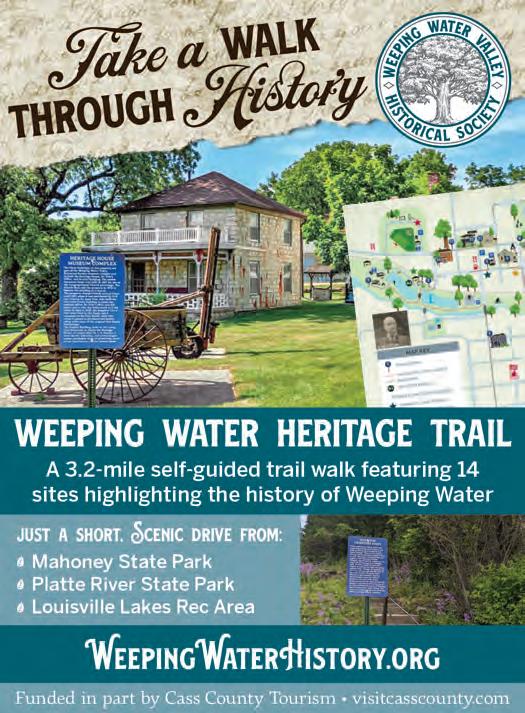
NORFOLK Elkhorn Valley Museum p 36
SIDNEY Fort Sidney Museum p 61
TEKAMAH Burt County Museum p 35
WEEPING WATER
Weeping Water Valley Historical Society/
Heritage House Museum Complex p 34
WYMORE
The Great Plains Welsh Heritage Centre p 37
YORK
Clayton Museum of Ancient History at York College p 51
Wessels Living History Farm p 51
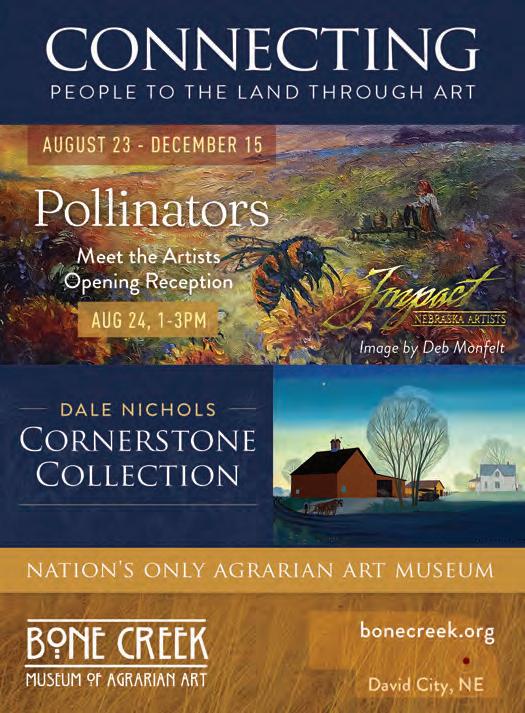
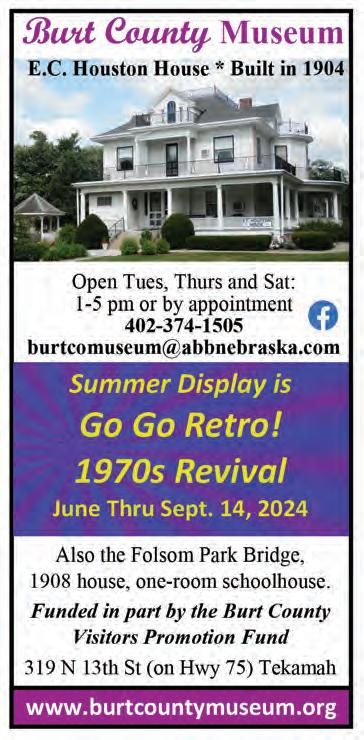
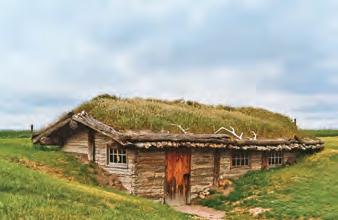
See the history of the first business in North America -the fur trade.
10 Unique items to view!
John Kinzie’s gun
HBC Officer’s sword
Brass Handle Cartouche knife
William Clark Fabric Samples Chief’s Coat
Kit Fox Society lance
Russian American Co. note Oldest dated trap 1755
Parchment HBC Officers Certificate
Andrew Henry’s leggings

Open 8-5, May 1 to October 31
3 miles east of Chadron, Nebraska on US Highway 20. www.furtrade.org 308-432-3843 • museum@furtrade.org
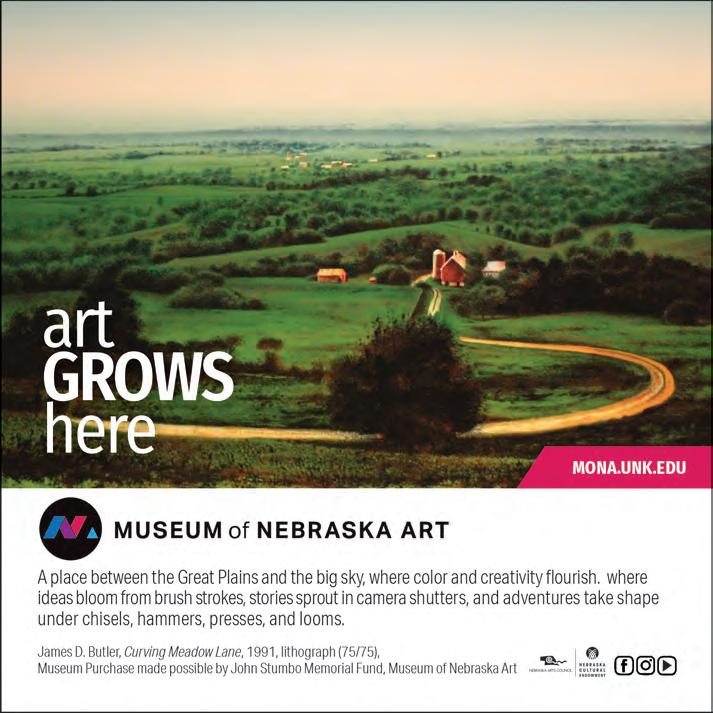
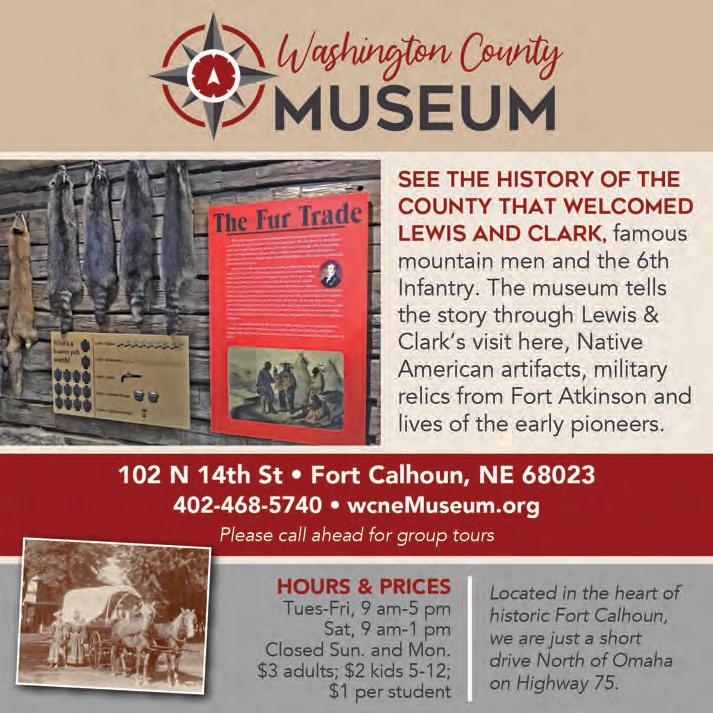
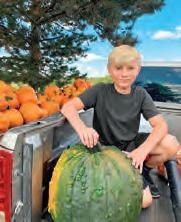
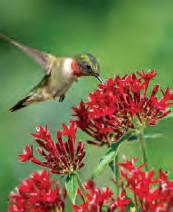
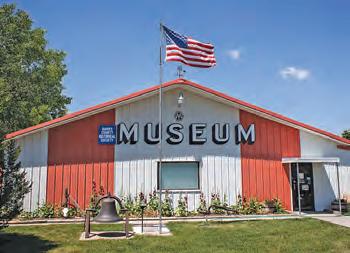




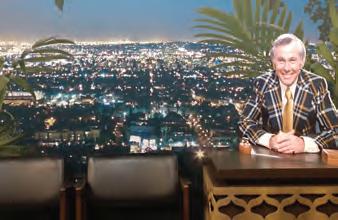

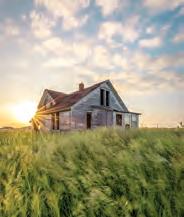
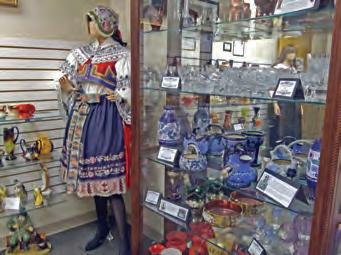
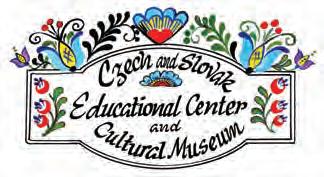
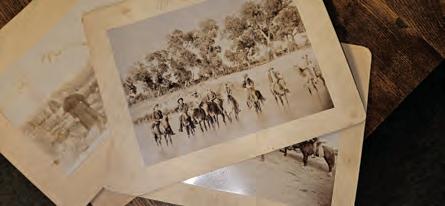
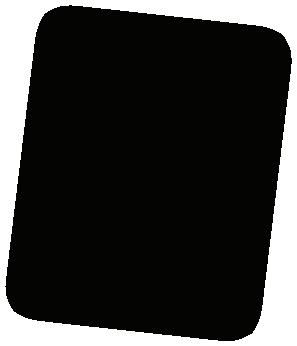
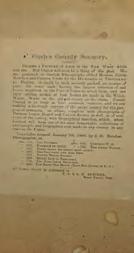
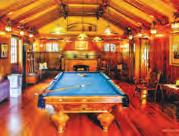
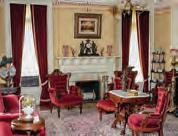


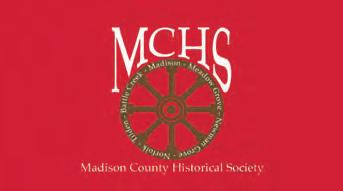

MADISON COUNTY MUSEUM
Remember the PAST Build the PRESENT Create the FUTURE
Displays of military, railroad, firemen, communications, sports, quilts, lighted christmas village, Santa train, and more!
Hours: 1:30-5 pm
Mon-Fri or call for appointment 402-454-2313 or 402-649-1881
212 S Kent St • Madison, NE madisoncountyhistory.org
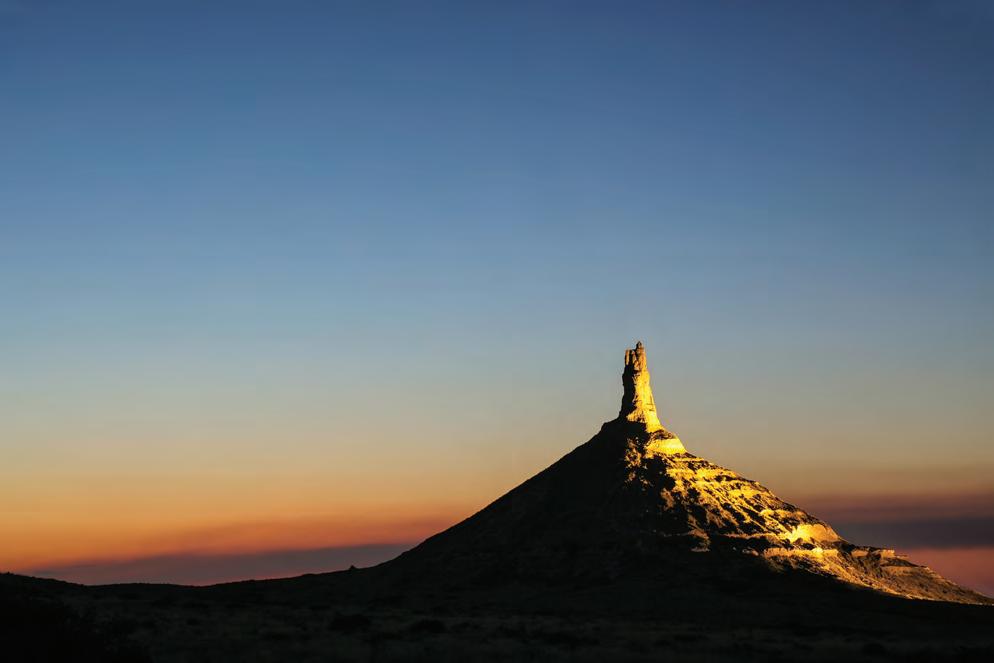
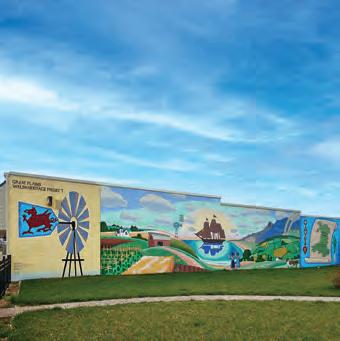
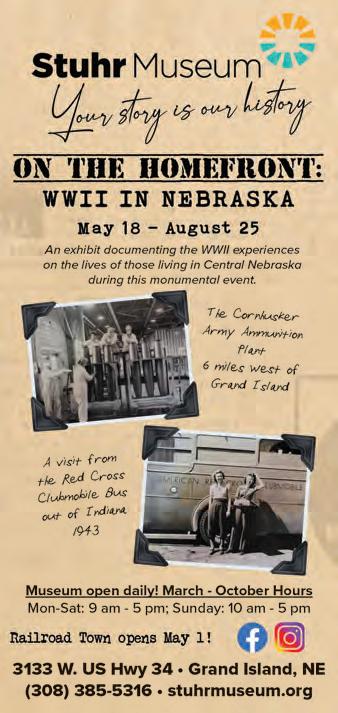
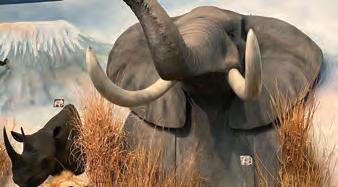
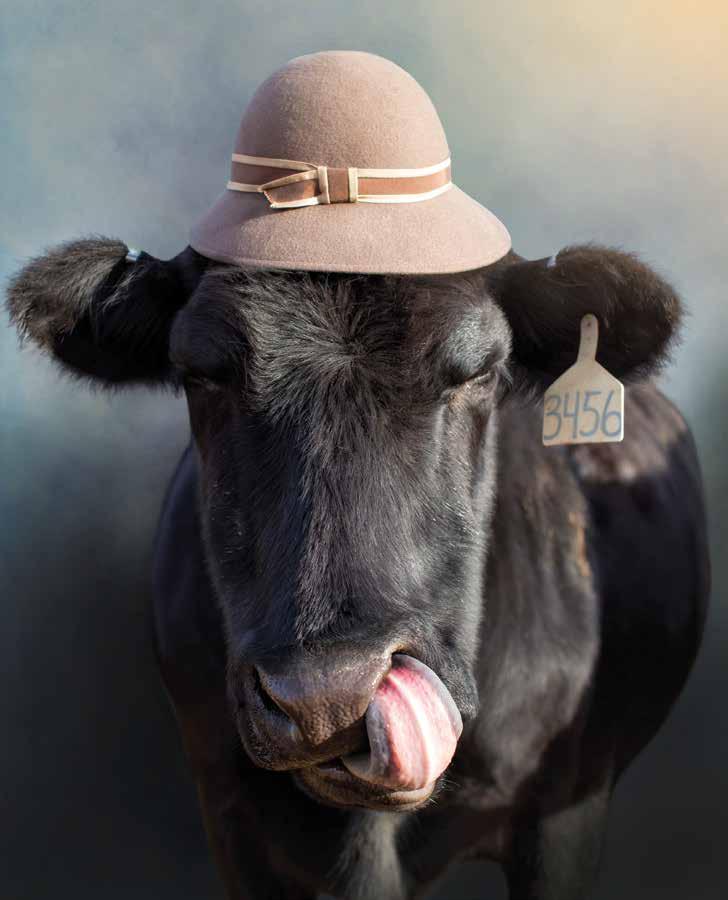
story by NICOLE LOUDEN
art by AUDREY POWLES
IT’S A WARM, windy May afternoon in the western Sandhills of Nebraska.
Cattle dot the hills covered with grass, and ranch wife Audrey Powles heads to a horse barn near the corrals. It’s dusty and hot in the long barn, with tack lining the walls and saddle blankets piled in the corner. She grabs a curry comb, but instead of brushing down a horse, she runs the comb over the coarse hair of a cow.
A hand-painted canvas drop cloth creates a backdrop behind a platform, which sits in the corner next to pens and feed troughs. Portrait lights stand with their translucent umbrellas, and Audrey places a hat on the brushed cow. Not just any hat, but an old-style lady’s hat – round and worn, with a pattern of soft pink roses and bright pink netting over the top. Audrey offers the cow a treat, then quickly backs away to snap photos before the cow tosses the hat off in search for more treats, licking Audrey’s shirt and hands.
The cow, named Baby, is Audrey’s latest portrait subject in a series of fine art photography she calls “Cows in Hats.” Audrey photographs cows wearing vintage women’s hats in a custom make-shift portrait studio she has constructed in a barn near her home just west of Bingham.
Her artwork has quickly gained in popularity since she went public with it in late
2022. It has been featured in dozens of galleries around the United States and Europe, earning Audrey awards and a loyal following of “Cows in Hats.”
For Audrey, the cows are more than merely portrait subjects. Many are tame “pet” cows, favorites among the herd of Gelbvieh-Angus cross cattle that her family raises. These favorites get names – Tilly, Shortie, Toots, Agnes, Velma, Patty and Baby – just to list a few. And her group of favorites is continually growing; close friends and family tease her about being the “cow whisperer.”
Audrey loves to carry a bucket (or two) of cake – a pressed seed product that cattle enjoy – as treats for the cows when she checks pastures. She even carries a hairbrush in the side-by-side ATV, brushing out stray cactus and burrs from the cattle she stops to inspect. Each cow is special, each one with a personality as unique as her markings or physical features.
Being around livestock and country life at an early age cultivated Audrey’s love of animals. Audrey grew up on a farm east of Hastings where they raised corn and soybeans and kept cattle and horses.
In grade school, Audrey met a lifelong friend who became an important inspiration for her journey into photography. Her friend Steph went to college for photography, and during that time they worked to-
gether in the Walmart photo department. When Steph began shooting weddings as a professional photographer, she invited Audrey along to be second shooter. From then on, Audrey was hooked on photography. Audrey moved to Chadron in 2010, where she met husband Bryon Powles and moved to Bingham in 2011. She started her own photography business the next year.
Besides running her photography business, Audrey ranches with Bryon. She ensures the well-being of the cattle by monitoring pastures for water, salt, minerals, and animal health, providing feed and maintaining accurate cattle records for the ranch. She manages night calving and has successfully pulled calves by herself.
THE INSPIRATION for Audrey’s “Cows in Hats” idea struck her on a summer day in 2019 while she was checking cattle in a pasture, a task she had performed thousands of times.
Purple wildflowers were blooming profusely near a lake where the herd was grazing. While observing the group, Audrey specifically searched for Velma, a special pet cow. On a whim, she crafted a wreath of the purple wildflowers and set it on Velma’s head.
“To my surprise, she wasn’t bothered and let me take a few cell phone photos of
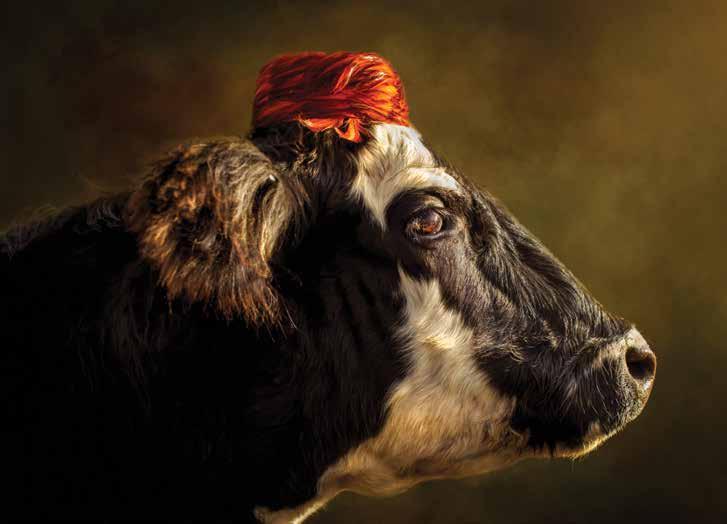
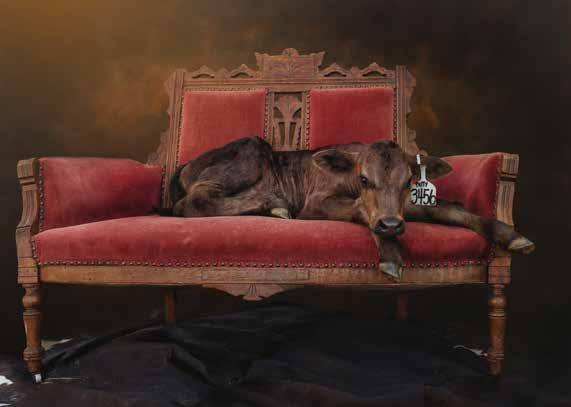
Velma, known as the queen, wears a pheasant feather hat while looking west on the pasture – a first for both cow and photographer. Patty gave birth to Baby in 2023.
Senior cow Agnes, or “Aggie,” stands content in the barn studio: eyes closed, brows furrowed, wearing a vintage hat.
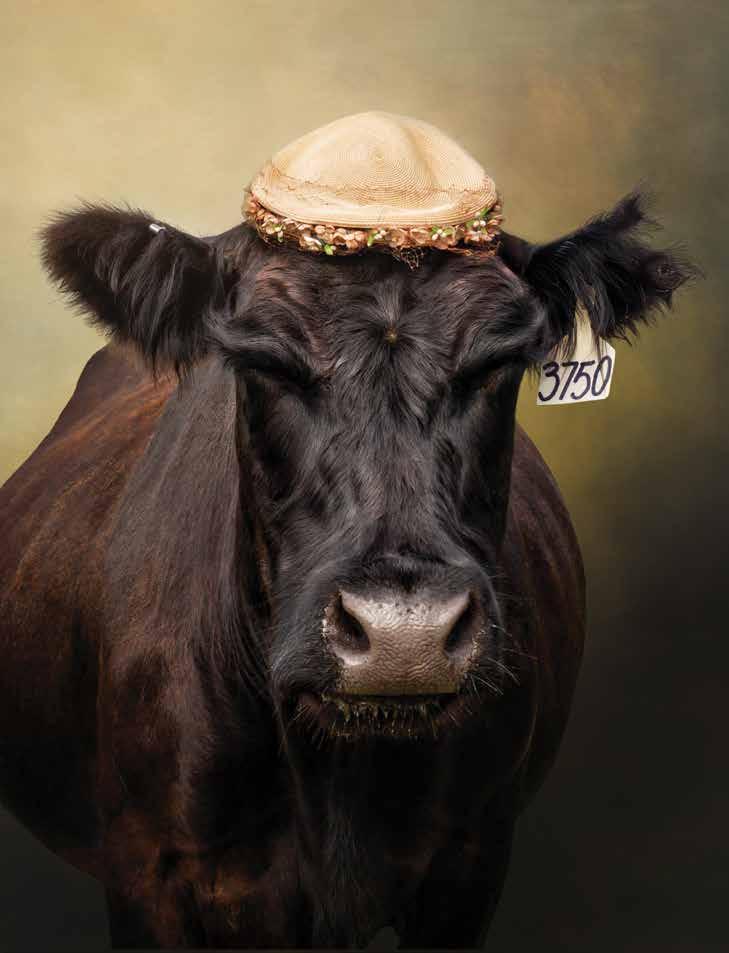
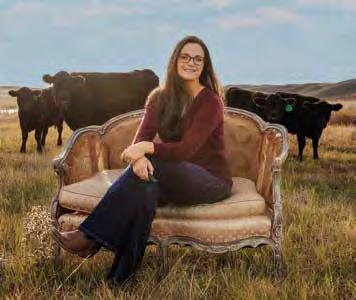
her wearing the floral crown,” Audrey said.
That same summer, Audrey had been cleaning out her husband’s grandparents’ abandoned home and stumbled across a collection of vintage hats, still in good condition. Audrey especially liked a beautiful hat of pheasant feathers, likely handmade. She wondered if Velma would stand for a photograph while wearing the hat. Audrey returned to the pasture, photographing Velma in the feathered hat.
Audrey photographed other pet cows wearing hats from the vintage collection. Not sure what others would think of cows in hats, she sat on the photos for several years.
Audrey has always loved painting as a hobby and began experimenting with a “painterly” style of fine art editing in her photographs, giving them the painted feel – inspired by masters like Renoir and Rembrandt – that she longed to create with her brushes.
With encouragement from Bryon, in 2022 Audrey entered a portrait contest through a professional print lab. She won an honorable mention with a painterly style portrait of her cat Popeye wearing a bow tie. Audrey received a grant for a creative project through that print lab. With the grant, she weaved the painterly style of editing into the “Cows in Hats” photos, making artful photos worthy of a gallery.
A local artist suggested she submit photos to an online call for entries to art galleries. She had three pieces chosen to go to a gallery in Long Island, New York, and won the competition overall with Velma’s portrait.
As Audrey’s art is growing in popularity, so has her collection of vintage hats. What started with the hats she found that day in her husband’s grandparents’ house has expanded to include hats she found at yard sales and antique stores, and gifts from friends and family members. Each hat is unique, and Audrey enjoys the selection of the hat to match the cow – sometimes letting the cows make their own choice between two hats.
Audrey hopes to learn more about all the hats, the assorted styles and stories behind them. She has considered creating a coffee-table style of book featuring photos of the cows and stories about the hats.
Powles plans to continue to create fine art with the growing hat collection. Her artwork has expanded to include calves in a collection of antique chairs, as well as horses in the painterly style. She has a solo exhibition this summer at the Carnegie Arts Center in Alliance.
While she’s busy with photography, most days find Audrey in the pasture with her family’s cattle. The ranch and livestock business takes priority to her photography business and art. “It is what allows me to be able to do what I do.”
She hopes people see the beauty and reality of her art – that the cows really are wearing hats, the calves really are sitting in chairs. “I’ve been blessed with some phenomenal cattle who are gentle and patient. Many of those will allow me to put hats on their heads; some will not, but I won’t hold it against them. And that’s just fine.”

“I really didn’t think people would like my cows in hats as much as I did, and I was afraid to put myself out there.”
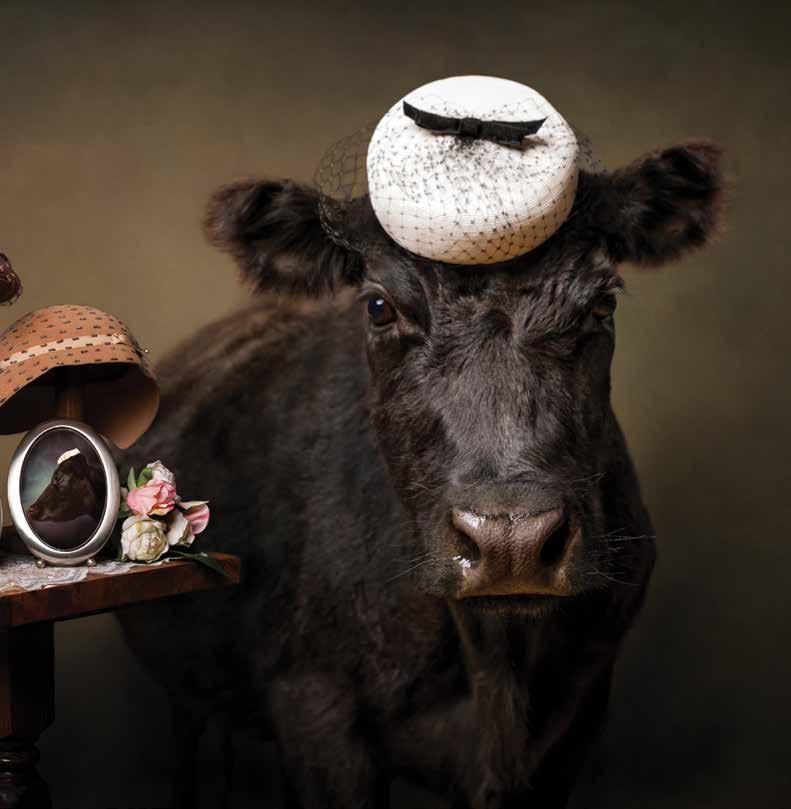
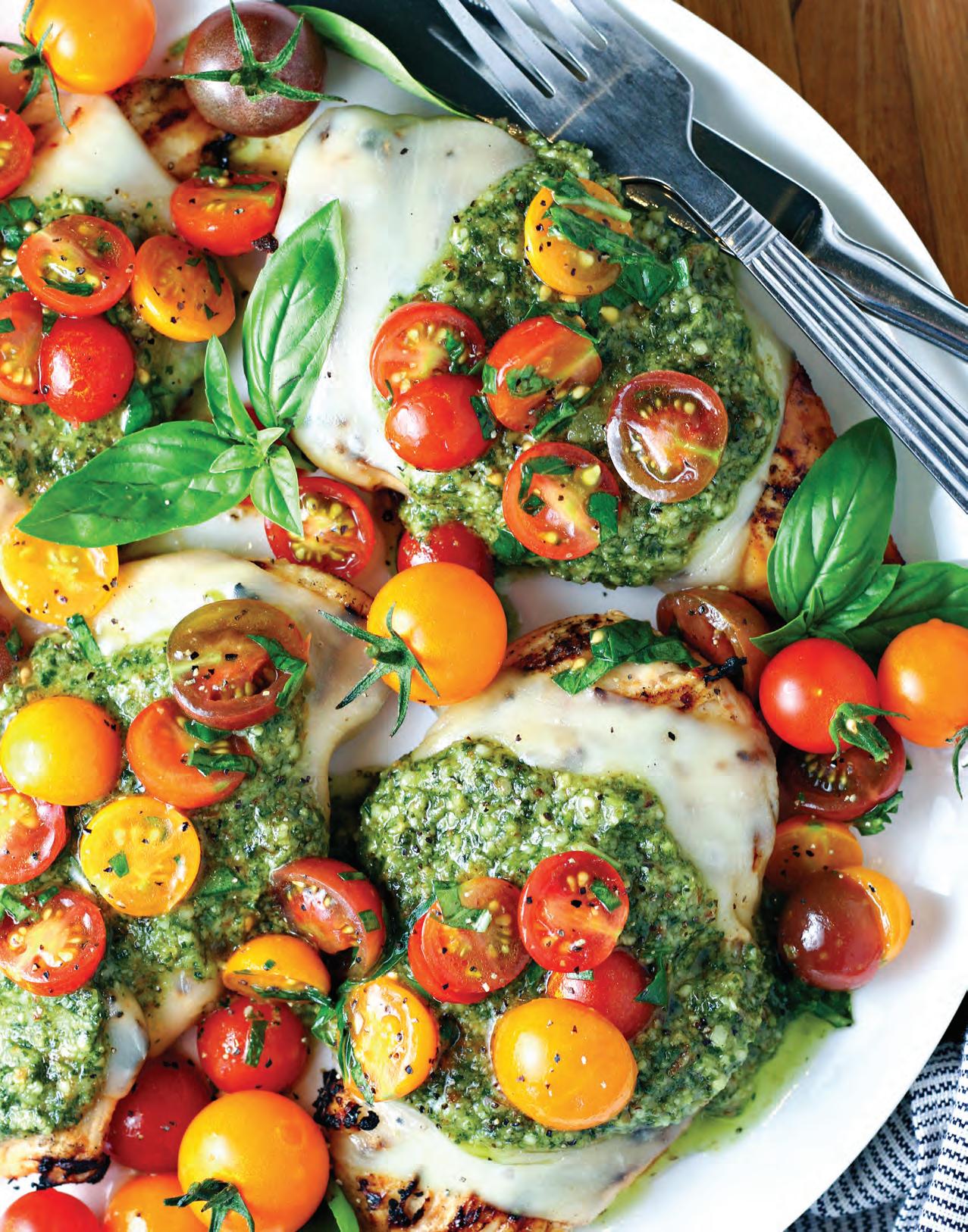
Add fresh garden vegetables, and your guests will shake your tail feathers.
recipes and photographs by
DANELLE McCOLLUM
Chicken grilled or cooked, in dishes hot and cold, make for quick, wholesome, delicious, go-to meals for family and friends.
Summer gardens supply freshness to this basil and cherry-tomato dish, blended with mozzarella cheese and basil pesto and served over grilled chicken breasts for a simple yet elegant version of a caprese salad. Add a salad or crusty bread for a complete meal.
Place chicken in a large zip-top bag. Pour Italian dressing over chicken and seal. Refrigerate for at least one hour.
Preheat grill for medium-high heat. Remove chicken from marinade and grill for about 8 minutes per side, or until cooked through.
Top each piece of chicken with a slice of cheese and cook for 1-2 more minutes, or until cheese is melted. Spoon 2-3 Tbsp. pesto over each chicken breast.
Toss tomatoes with olive oil, fresh basil and salt and pepper to taste. Spoon tomato mixture over chicken and serve immediately.
4-6 boneless skinless chicken breasts
1 cup Italian dressing
4-6 slices of mozzarella cheese
½-¾ cup prepared basil pesto
3/4 cup cherr y tomatoes, halved
1/4 cup packed fresh basil leaves, chopped Salt and pepper to taste
Ser ves 4-6
This is one quick, one-pot dish that includes wholesome veggies and the kick of red pepper flakes over a unique pasta – all of it ready in just 35 minutes.
Sprinkle chicken with garlic salt. In a large skillet, sauté chicken and onion in oil 5-6 minutes or until chicken is no longer pink. Add minced garlic and cook 1 minute longer.
Stir in the diced tomatoes, broth, orzo, Italian seasoning and red pepper flakes. Bring to a boil.
Reduce heat. Cover and simmer about 15 minutes, or until orzo is just tender and liquid is absorbed. Stir in spinach and cook an additional 2-3 minutes, until spinach is wilted.
Sprinkle with Parmesan cheese before serving.
1 lb boneless skinless chicken breasts, cubed
1 tsp garlic salt
1 small onion, chopped
1 Tbsp olive oil
2 cloves garlic, minced
1 14-oz can diced tomatoes, undrained
1 cup chicken broth
3/4 cup uncooked orzo
1 tsp Italian seasoning
1/8 tsp red pepper flakes
5-6 oz fresh spinach, chopped
1/4 cup grated Parmesan cheese
Ser ves 4
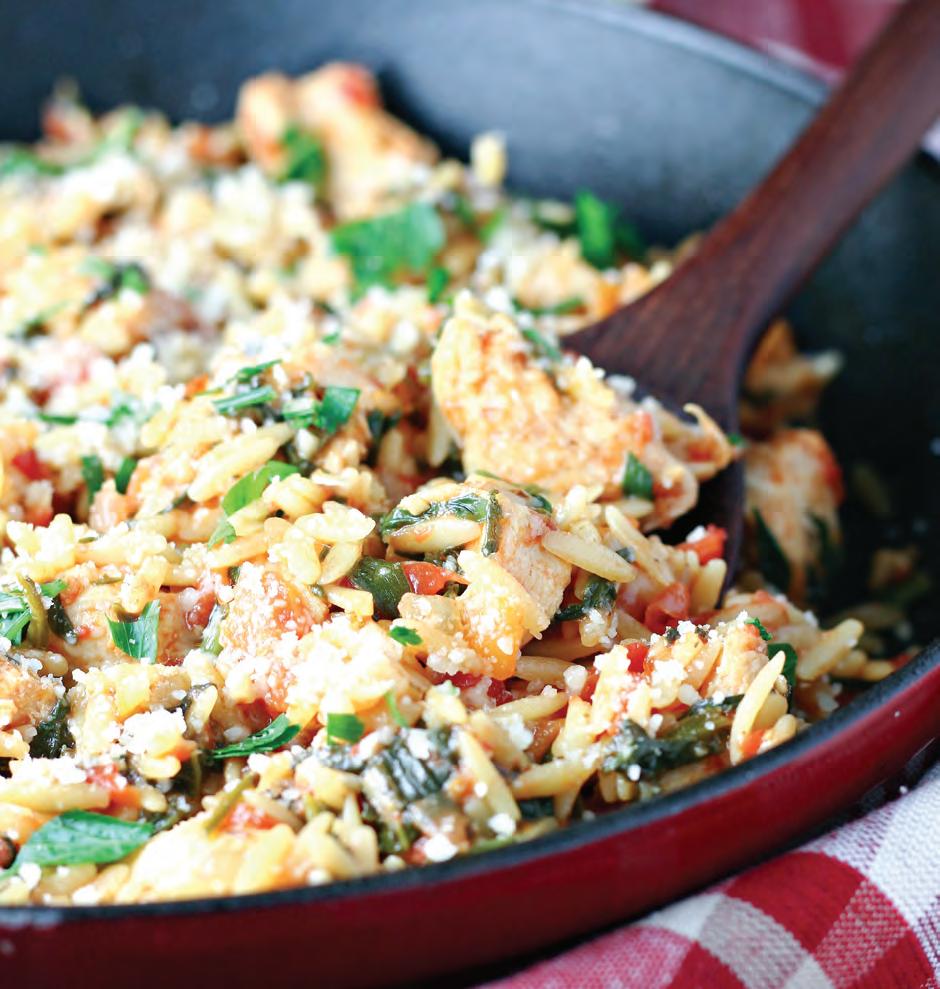

Here’s a recipe for a summer potluck. The homemade dressing boosts the flavor of tender chicken, mandarin oranges, cranberries, cucumber and a bed of herbs, nuts and other tasty morsels.
In a large bowl, whisk together the ingredients for the dressing until smooth. Set aside.
Cook the pasta according to package directions. Rinse with cold water and drain.
Add pasta to bowl with dressing, along with other ingredients, except for chopped cashews (or peanuts). Toss to coat well. Refrigerate for at least one hour, or until serving.
Re-season with salt and pepper, if desired.
For the dressing
1/4 cup vegetable or canola oil
1/4 cup apple cider vinegar
1/4 cup teriyaki sauce
2 Tbsp honey
1 Tbsp sugar
Salt and pepper to taste
For the salad
16 oz bowtie pasta
2/3 cup cooked cubed chicken
1/2 cup dried cranberries
2 15-oz cans mandarin oranges, drained
1 cup diced cucumber
1/4 chopped fresh parsley
1/2 chopped green onions
1-2 Tbsp sesame seeds
1 cup cashews or peanuts, chopped
Ser ves 10-12
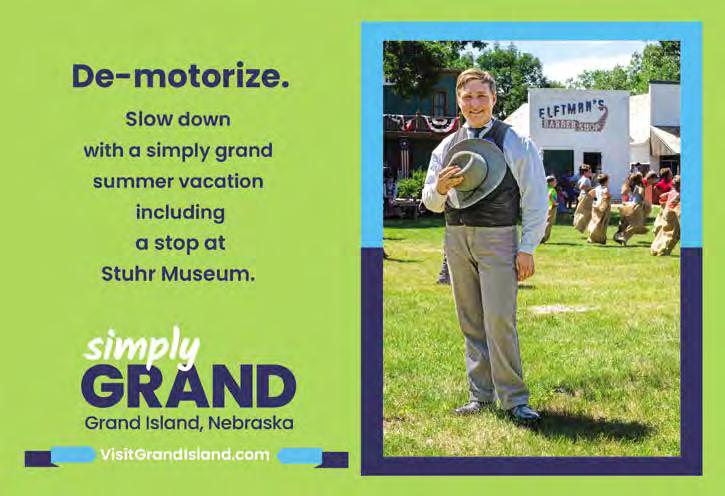
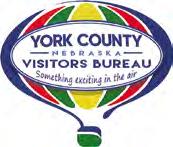
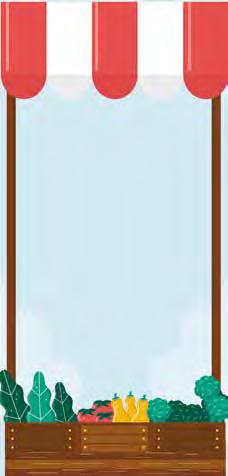
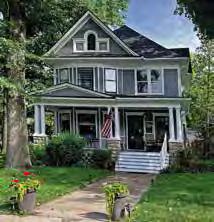



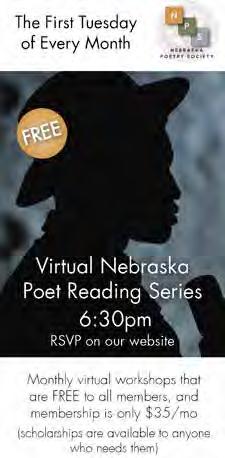
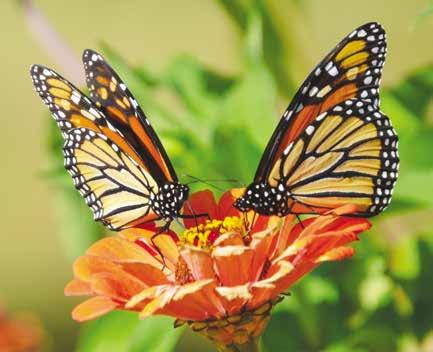
From something so simple as a small blooming flower to the singing waters on the rivers, these Nebraska poets rejoice in our warming skies and budding landscapes.
Duane
Anderson, La Vista
I had to look twice, for it appeared snow was falling in late April as the wind blew the white blossoms from the flowering crabapple tree, covering the yard with white petals as if a wedding was taking place with the flower girl tossing them side to side as she walked down the aisle, and as I went outside, I picked up a handful, tossing them over my head as I danced on the white carpet, celebrating the beginning of spring.
Lloyd
Friesen, Omaha
A flower seed lies in repose. Just below the soil’s surface. Wrapped in winter’s frozen cloak.
Come spring, ever longer days and the sun’s rays will warm the soil. Awakening the seed from its slumber.
Then it will sprout and begin an upward journey to meet the sun.
And bloom.
Debbie Flower, Omaha
Oh, Gardenia
How we love you, your fragrant scent and colors of pink, yellow and blue.
And favorite of all are the blooms of cream that embody pure love and innocence and are the choice of many a brides’ dream.
We have many things to look forward to in spring, but, the blooming of Gardenias is the season’s shining engagement ring.
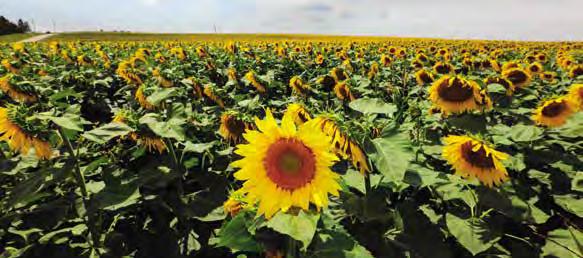
Jerry Gronewold, Kearney
The garden of color embraced by the morning sun
Red, orange, yellow welcomes the sun.
The blossoms ablaze with hues of morning
The petals unfold to butterflies’ rejoice
The morning dew is like diamonds on mother’s ring
Soft sounds creep over the radiant flowers.
They come quietly to rest on colorful blooms
They flitter around like leaves in the spring wind.
They float to color blooms that wait in anticipation
They gather pollen like precious perfume.
The butterflies are like gentle messengers of the air
In harmony, butterflies and flowers intertwine.
Wings of color and blooms glitter with gold
A patchwork quilt of color emerges over the garden.
Sunlight enhances wings of color and blooms of many colors
The garden brings joyful memories.
Their fragile presence a floating delight
Colorful butterflies and flowers, a wonderful site.
Bright wings of color enhance the morning
Let us cherish their fragile souls.
Mary Olszowka, Bennington
The grandmother held the child’s hand
As they moved across the drying land
On their way to the county fair.
And looking down at the sunburnt ground
The child breathed a sighing sound
As they walked to the county fair.
For amid the tangled drying grass
She witnessed splendor unsurpassed
So close to the county fair.
A lone tickseed bright as the sun
Revealed its splendor to the little one
Pausing the trek to the county fair.
Then with an awe-filled simple word,
A whispered, beautiful, but Grandma heard
And smiling led the way again to the county fair.
Walking two generations apart
Entwined by a blossom in the heart
On their way to the county fair.
SEND YOUR POEMS on the theme “Fertile Ground” for the September/October issue, deadline July 15, and “Around the Table” for the November/December issue, deadline Sept. 1. Email your poems to poetry@nebraskalife.com or mail to the address at the front of this magazine.
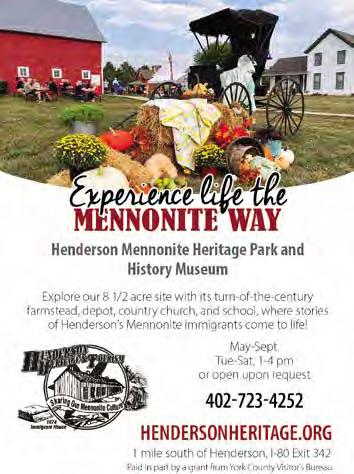
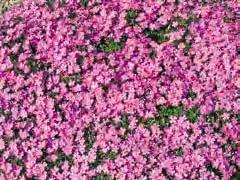

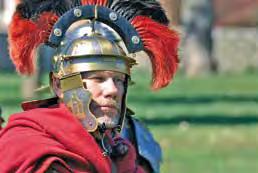
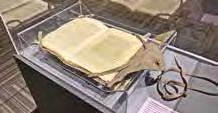
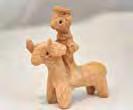
Explore ancient Rome, the Near East and much more. Special Bible exhibit shares the story of scripture from scroll to modern translations. Children’s interactive Little Kingdom now opened!
View rare artifacts from the ancient civilizations of Mesopotamia and Roman Empire! Young and old can experience the museum’s Little Kingdom interactive area. Uncover objects in an archaeological dig, “live” in an ancient house and “shop” a Roman market. Admission is FREE with donations always accepted.
ADMISSION IS FREE Check Facebook page for hours
Open Tues-Fri, 10 am-5 pm • Sat 1-4 pm claytonmuseumofancienthistory.org
ClaytonMuseumOfAncientHistory.org
402-363-5748 • 1125 E 8th St • York
Paid for in part by a grant from the York County Visitors Bureau
402-363-5748 1125 E 8th St • York, NE

Paid for in part by a grant from the York County Visitors Bureau
Lower level of the Mackey Center on the York University campus
Located in the lower level of the Mackey Center on the York College campus
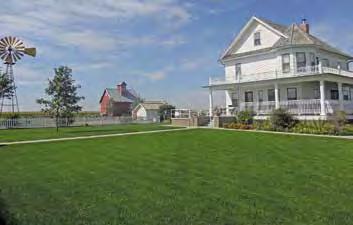



by LAUREN WARRING
JULY 3-5 • SEWARD, OMAHA, PAPILLION
Nebraskans are gearing up for an enthusiastic 4th of July across the state. Between freedom runs, parades, live music and sports – and of course, fireworks – millions of Nebraskans gather in their communities to celebrate America’s independence. Here are a few events to consider as you plan your celebrations.
Seward, Nebraska’s Official Fourth of July City, begins celebrating on Wednesday, July 3. The 156th annual celebration started humbly in 1868 and has since garnered the attendance of over 50,000 people every year. This year’s theme is “Always Ready – Always There!” honoring first responders: police, firefighters and the Nebraska National Guard. Festivities begin on with an open house at the Nebraska National
Guard Museum and an evening Civil War concert at 7 p.m. at the Seward High School Auditorium.
Events kick off early at 7 a.m. with 2-mile and 10K Freedom runs. Decorate your bike and ride along the Grand Parade on Seward Street, beat bubble gum and apple pie championships, explore handmade goods at the craft fair and enjoy anvil firing, cloggers and concerts at the bandshell. The Giant Fireworks Salute starts at 10 p.m. at Plum Creek Park. Full event schedule is available at JulyFourthSeward.com.
Live music and national pride come together at the Omaha Symphony’s 4th of July Performance in downtown Omaha. Visitors arrive as early as 3 p.m. with lawn chairs, blankets and snacks to se-
cure a spot on the lawn before the Performance Pavilion on the Gene Leahy Mall. The concert starts at 8:30 p.m. as the Omaha Symphony presents favorites like “America the Beautiful” and “Stars and Stripes Forever” and music by renowned composer John Williams. The night crescendos with a synchronized performance with fireworks across the backdrop of Omaha’s skyline.
Another great view of fireworks comes with a hot dog and beer at Werner Park in Papillion after the Omaha Storm Chasers versus Iowa Cubs baseball game. Game starts at 7:05 p.m. on July 3 and ends with an Independence Day firework display. No matter who wins the game, celebrate America’s independence with an American pastime.
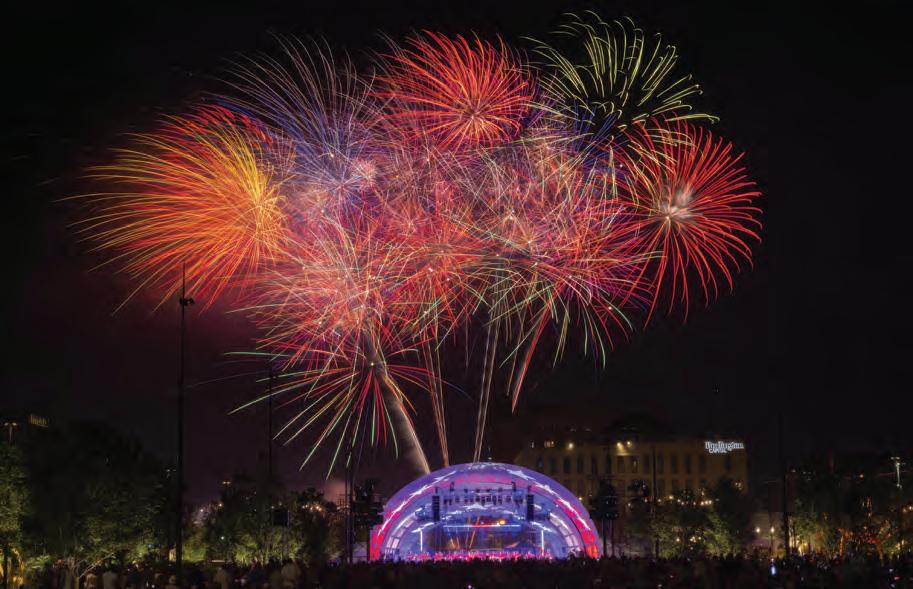
Communities across Nebraska gather to celebrate the Fourth of July. On the Gene Leahy Mall in Omaha, families meet for a live ensemble by the Omaha Symphony, culminating with a musical firework display.
JULY 11-14
• CHADRON
Pitch a tent at a buckskinner’s primitive camp and celebrate the American Fur Trade in northwest Nebraska. Community events include parades, water slides, carnival rides, fireworks, live performances and a trader’s market with specialty foods and crafts. (307) 622-1920. FurTradeDays.com
JULY 19-21
• NORTH PLATTE
Celebrate Native American culture, traditions and veterans at Buffalo Bill State Historical Park. Experience a Wichita War Dancer, Potato Dance and Chicken Dance and more dances with drums from the Creekside Singers. Overnight camping is available. Nebraska Game and Parks permit required. 2921 Scouts Rest Ranch Rd. (308) 520-9516. See full schedule on Facebook at NPpowwow
JULY 20-21 • WAVERLY
What began as a neighborhood threshing bee is now one of the biggest threshing shows in the state. Start with a pancake breakfast and watch demonstrations of threshing, bailing and tractor pulling with a parade at 2 p.m. Try your hand to churn butter or shell corn. 17200 Bluff Rd. (402) 789-3003. ccthreshers.org
JULY 24-27 • BURWELL
Since 1921, cowboys across the state test their skill bareback, wrestling, racing and roping. Enjoy carnival rides, animal shows, parades and performances every night, plus dancing and socializing in the Bull Pen Beer Garden. Children compete during the Little Rodeo on Saturday. 46710 L St. (308) 346-5010. NebraskasBigRodeo.com
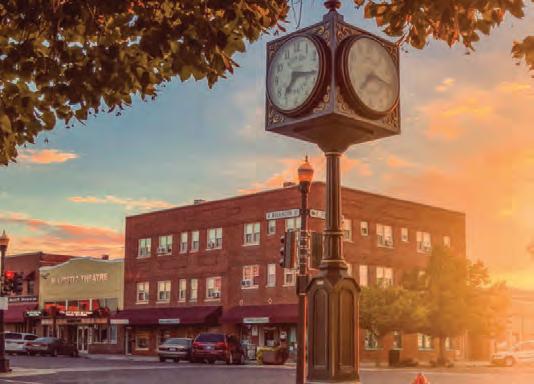


Questions on p 20-21
1 Plattsmouth
2 Niobrara
3 Colorado
4 Stock tanking, aka “tanking”
5 Snake River
6 True (Nebraska is Otoe for “flat water”)
7 True
8 False (it’s an Otoe name, meaning “canoemaking river”)
9 False (it’s French for “wolf”)
10 True (the state’s waterways would circle Earth 3.17 times)
11 b. Ohio
12 b. Channel catfish
13 c. Jack Nicklaus
14 a. Salt Creek tiger beetle
15 b. Florence Mill (Mill Creek runs underground in a culvert)
Page 20, top Tanking the Middle Loup River near Mullen.
Page 21 Kayaking the Niobrara River near Valentine.
Page 21 Big channel catfish at Ord. Photographs
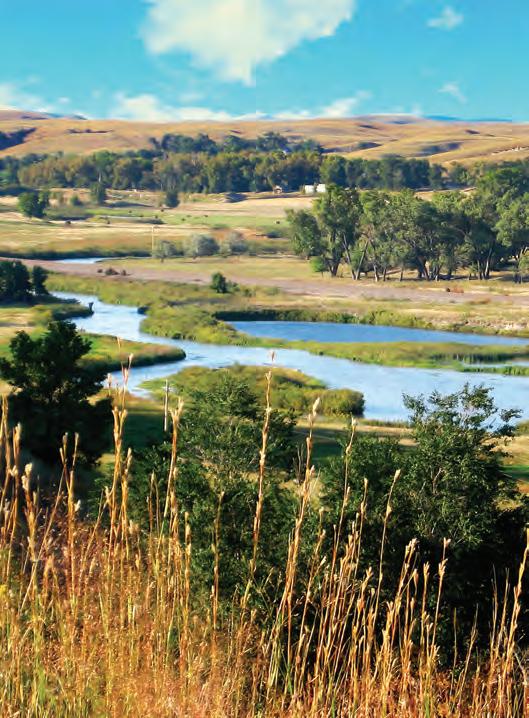

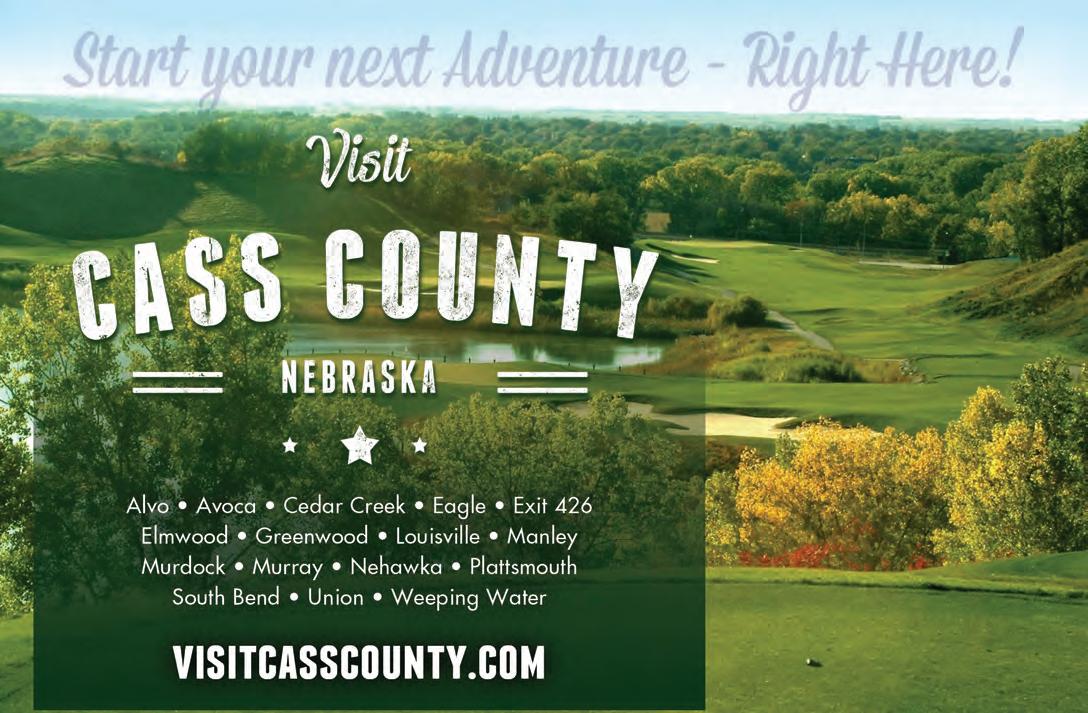
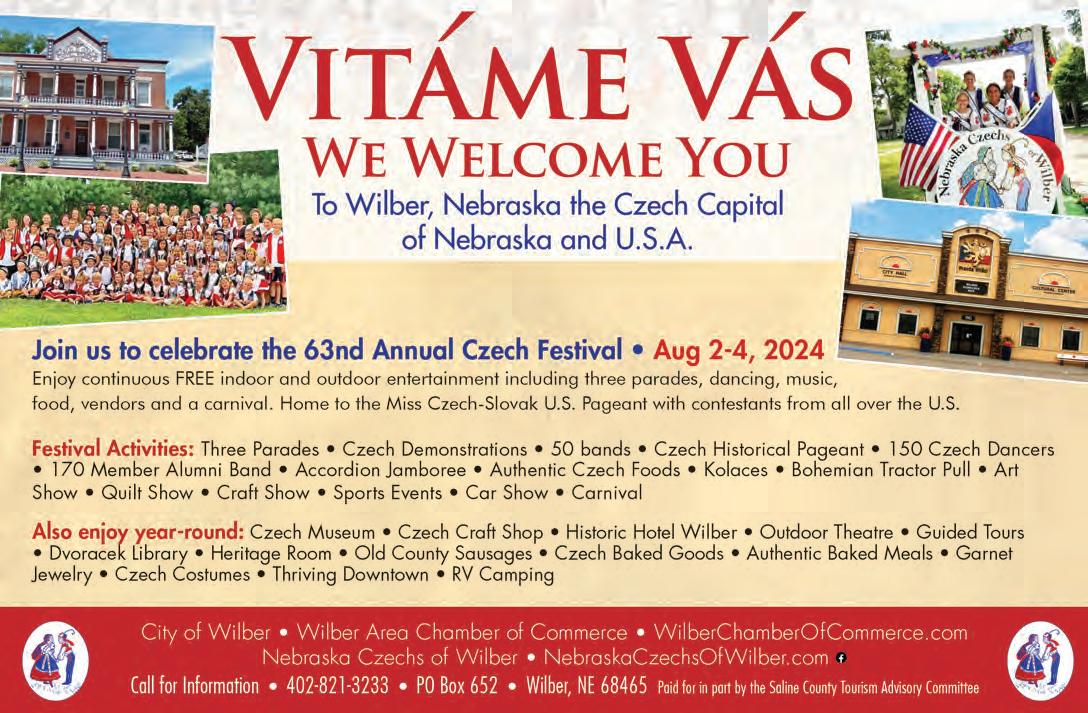

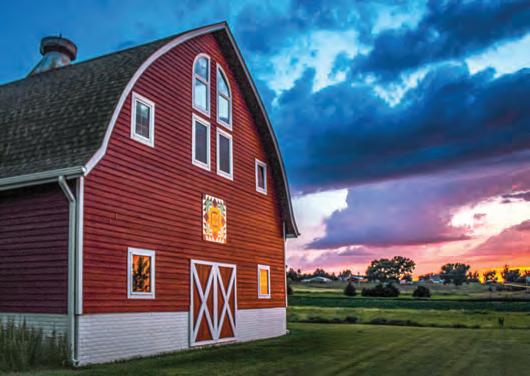
“Center Of It All” on scenic Highway 2, along the Sandhills Journey National Scenic Byway.
Broken Bow has something for everyone.
• 126 total acres of parks
• Aquatic center
• Fishing pond
• Picnic and camping facilities
• Numerous playgrounds
• Visit our downtown merchants
• Custer County Historical Society
• Restaurants and brewery
The roots are deep. The roots are strong. But they don’t keep us earthbound. They keep us growing.
For more information: brokenbow-ne.com
BROKEN BOW. ROOTED, BUT NOT STANDING STILL.

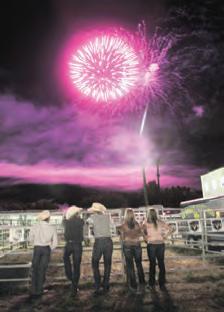
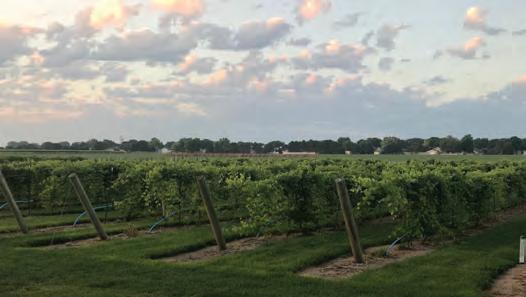
Enjoy our wines, hard ciders, craft beers and appetizers. Hike our walking trails, enjoy our creekside fire pits and stay in our quaint cottages.

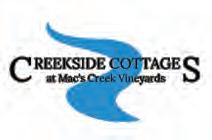
308-324-0440 • macscreek.com 43315 Road 757 • Lexington
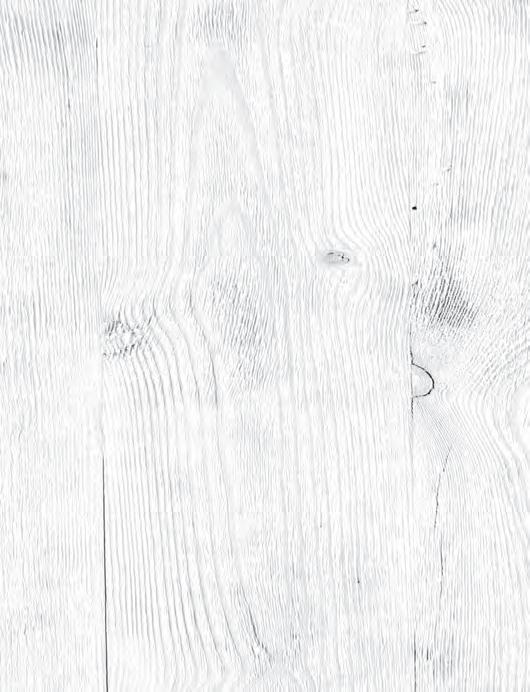
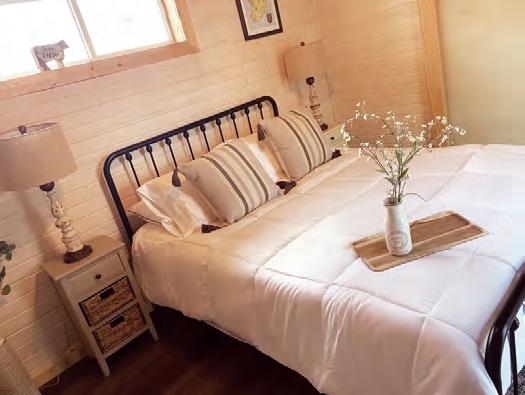
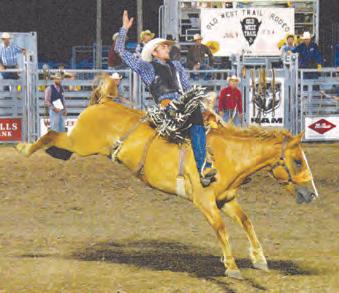
Enjoy the only PRCA rodeo in Nebraska at Crawford July 4th weekend. Stay for reworks after the rodeo.
Jr. King and Jr. Princess Rodeo at 9 am Kids Fun Day Rodeo at 10 am For more details and info on PRCA rodeo and Junior Rodeo fun day visit owtrodeo.com July 3-4 8 pm TICKET LOCATIONS IN CRAWFORD AND CHADRON
July 1
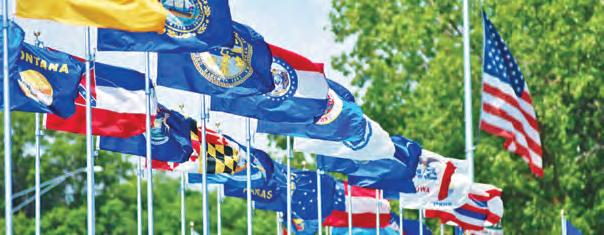
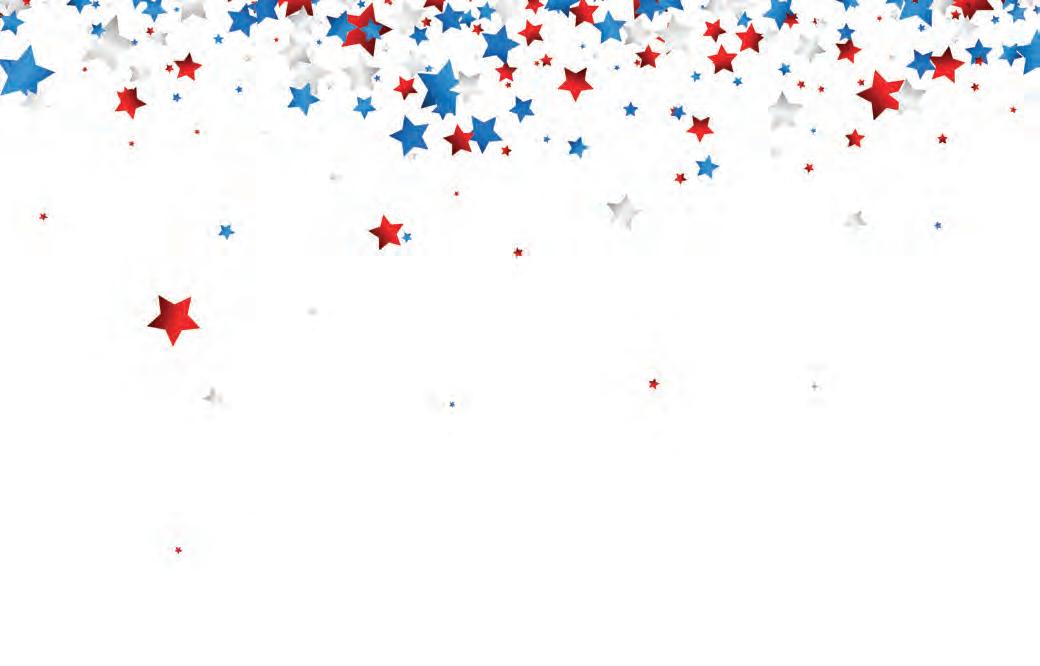
Welcoming Visitors to the 4th of July City
Located East of Seward on Hwy 34
• Features as its focal point a large American flag on a fifty-foot pole. This flag is surrounded by six smaller polesthat display the flags from the five military branches and POW flag
• A walkway extends beyond this focal point and features the fifty state flags on either side
• A special pathway, donated by Don and Barb Suhr, connects the display to the nearby walking trail and features five territory flags
• Display of all 50 states flags and flags from the five military branches and POW
• Flags lit at night for spectacular viewing opportunity
• Entire display is handicap-accessible and open year round
• Additional donations to assist with maintenance would be greatly appreciated
Made possible by the Seward County Visitor Bureau
For more information or to donate contact: Seward Kiwanis Foundation • Attn: Marv Taylor c/o Parade of Flags PO Box 245 • Seward, NE 68434

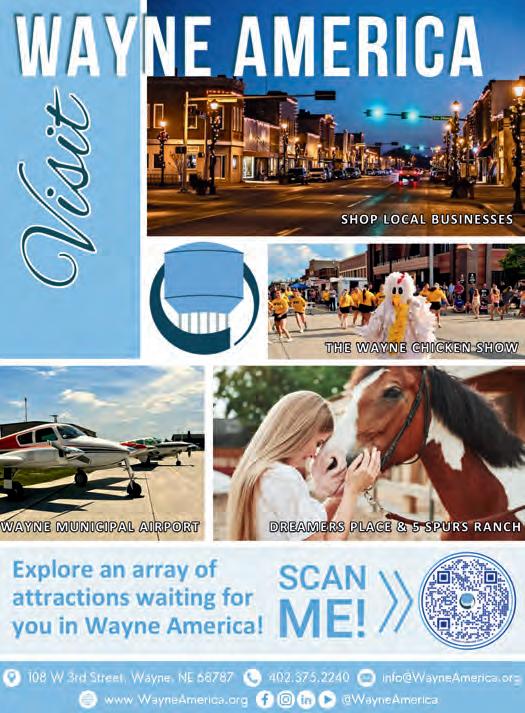
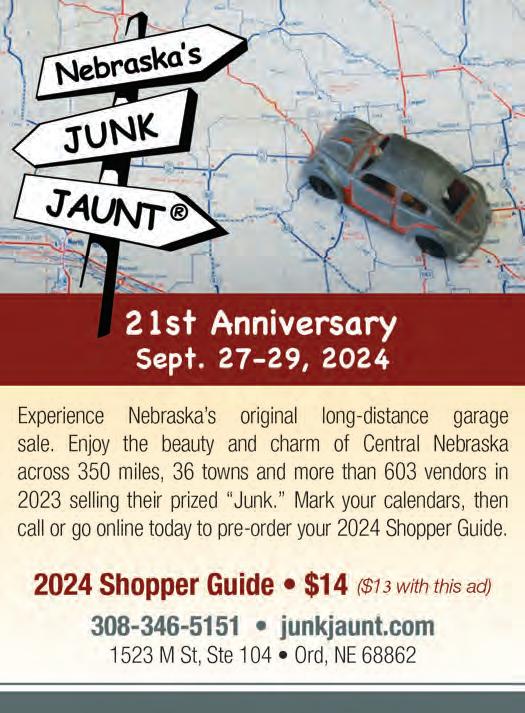
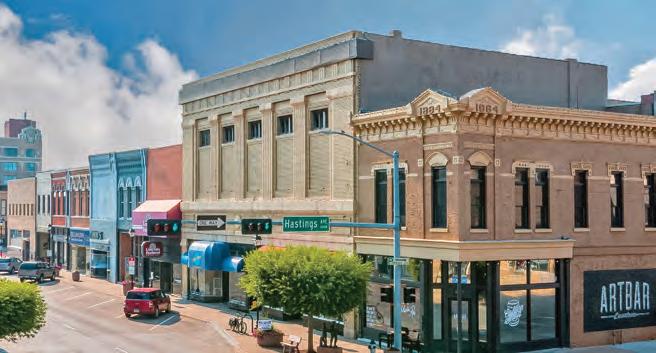
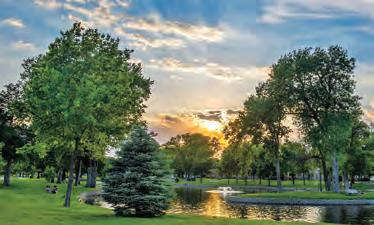

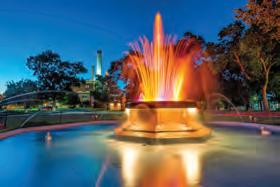


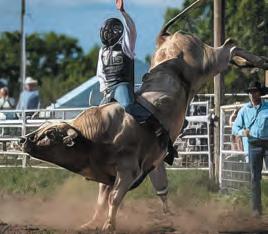
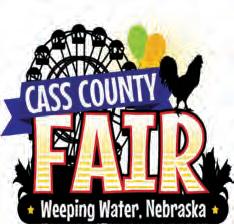
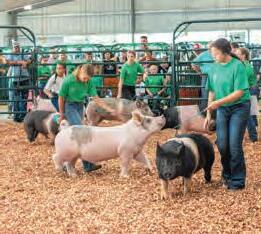
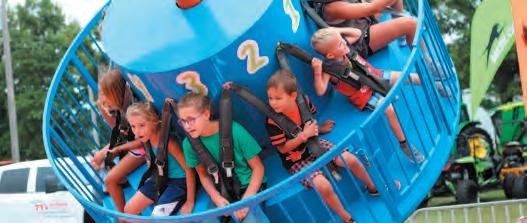
North Loup
Aug. 16-18, 2024
DISCOVER EXCITEMENT in North Loup with the pig scramble, mutton bustin’, Garry Moore Amusements, ranch rodeo and more at Popcorn Days. Visit our website for a complete schedule and register for fun events.
Team Sorting and Penning Popcorn Days DASH Parade of Floats & Bands

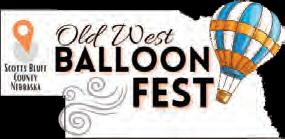
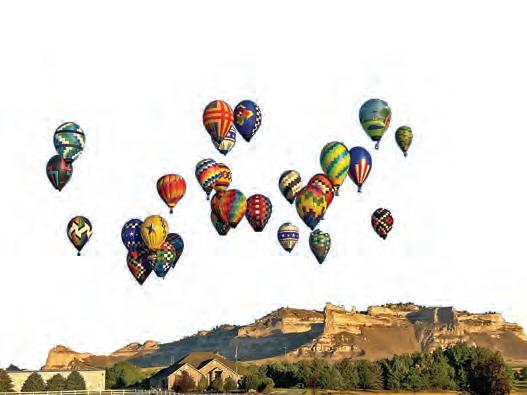
Crowning of Popcorn Queen Free Popcorn all 3 days
Contact Larry at 308-219-0297 or Carrie at 308-219-0854 for details.
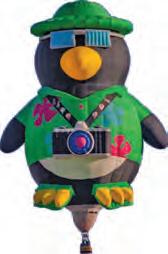
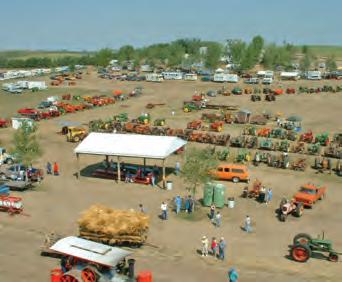
Cultivate excitement at this
Saddle up or start your engines for antique machinery, International Harvester, daily parades, kid’s activities, flea market and working exhibits.


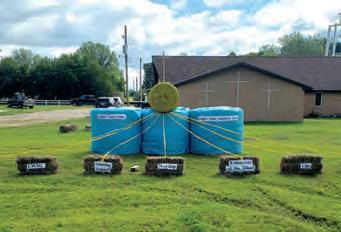
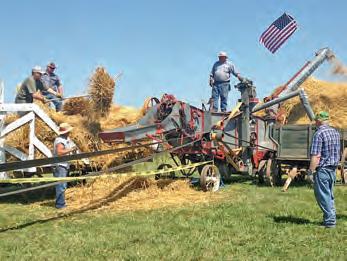



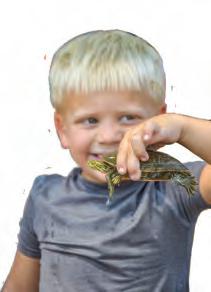
The Cornhusker State Games is a 40-year summer tradition in Nebraska, bringing together athletes ages 2-92 competing in more than 70 events at over 50 sites across the state, including long jump at Lincoln High School.
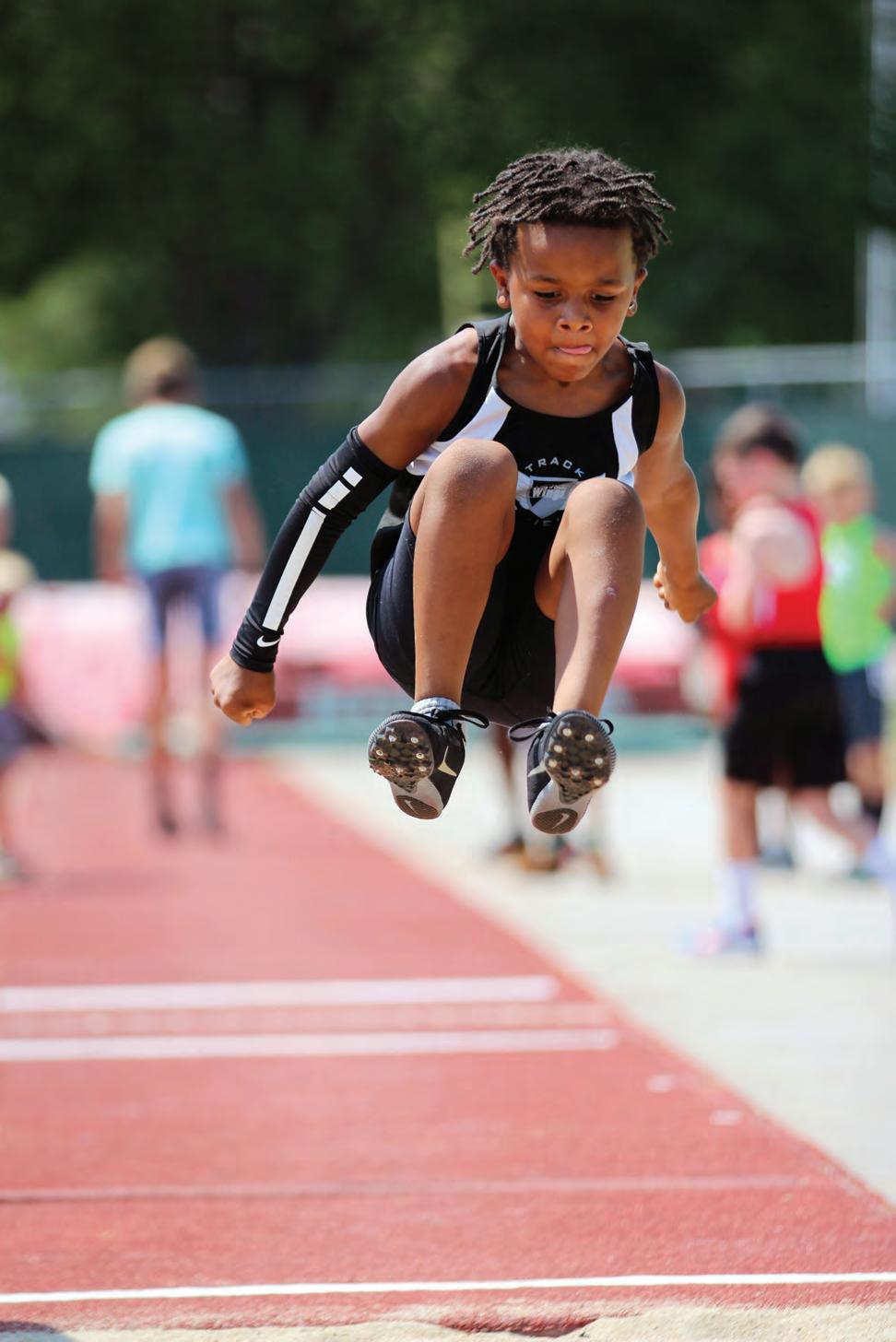
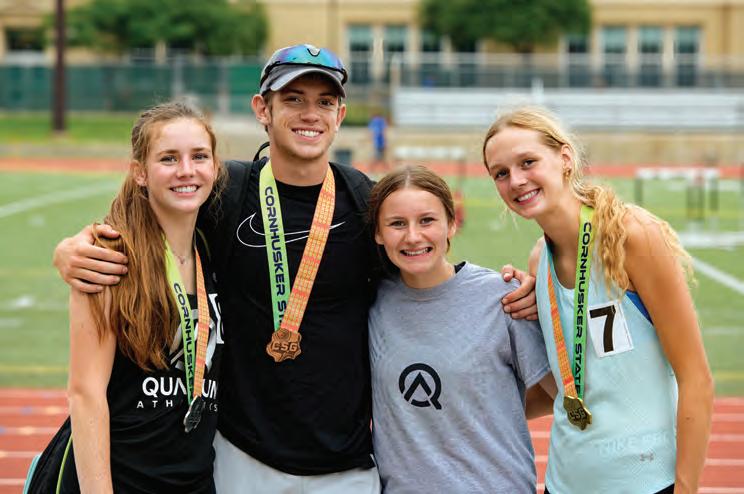
PATIENTLY WAITING her turn at the discus arena, 91-year-old Harriet Bloemker sat quietly among family and friends ready to cheer her on. She was the only one competing in her age bracket for the women’s discus throw, but that didn’t sway her competitive – yet kind – spirit.
The Cornhusker State Games, hosted at more than 50 sites across Nebraska, is a 10-day spectacle of amateur sportsmanship and athleticism every July. Individuals of all abilities and backgrounds gather to test their strengths, cheer on others and have a good time. They all have one thing in common, of course: being Nebraskan.
With sure steps, secured by fresh white tennis shoes, Bloemker made her way to the task at hand. At this point she’s guaranteed a gold medal finish, but that’s the last thing on her mind. She’s just glad to be here for another year.
Her first throw didn’t quite go as she’d hoped, only making it a short distance before bouncing to a stop. Her worn smile only faltered for a second, then her game face was back on. Bloemker had competitors to watch, with the next one being 71-year-old Barbara Griffith, and she wanted to win.
A Nebraskan through and through, Bloemker grew up on a farm in an athletic family with five brothers. While there were always contests to be had on the
Cornhusker State Games unites Nebraska athletes of all stripes
by CHEYENNE ROWE
Over 8,000 athletes participated in the 2023 Cornhusker State Games. Amateur athletes across the state compete in July for gold, silver and bronze.
farm, she couldn’t pursue anything much further than home competitions – only males could participate in high school sports at that time. But that didn’t stop her love of the games from growing.
“I read the rules of softball before I ever went to school,” she said. “Farm kids play tough and if it was a sport, I loved it.”
In 1996, the Fremont resident decided to retire after a lifetime of hard work. A new chapter in her life was just beginning, however, thanks to the Cornhusker State Games, and she’s competed ever since –including many trips to Nationals and a world record in javelin under her belt.
“I just kept competing, and I’ve never lost my love for competition,” she said. “And the Lord has blessed me with a body that allows me to be here, to exercise and to compete.”
And compete she did. With a steady windup and firm focus, Bloemker took the turn, arm extended and released the discus toward the horizon. Her longest throw was 41 feet, three inches – a solid five feet farther than the competitor closest to her in age, at 71.
“This just gives me a reason to keep exercising,” Bloemker said, sitting in the shade after winning two gold medals for the day. “It gives me a chance to compete. As long as my body allows me, I’m gonna compete.”
Sportsmanship and the opportunity to
compete are resounding values for Nebraskans alike. Like seasoned athletes, participants at the games were eager for their chance. Some were prime athletes who were honing their college sports during summer break.
Others, long past their competition days, are just looking for a chance to have some fun. Moms line up alongside the fence at Lincoln High School, home to the Cornhusker State Games track and field events. Some spread a healthy amount of sunscreen on their children. Others take care to hydrate their husbands, while more still lace up their sneakers and get ready to race themselves.
In 2023, 70 sporting events saw 8,000 participants from every corner of the Cornhusker state. Sporting events ranged from the standards of track and field to the unique, including skydiving, fencing, sailing, footgolf, BMX, martial arts and even chess.
A Clearwater native and lifelong sports fan, Dave Mlnarik, president of the Nebraska Sports Council, holds the Cornhusker State Games close at heart. Growing up in Nebraska, everybody played every sport, he said. He still loves competition to this day.
Mlnarik has been developing the games for over 30 years and has seen it grow and impact in thousands of Nebraskans in different ways. Those who stick out the most are often those individuals who earn an Athlete of the Year title like Bloemker.
And then, there is the story of Emmett Hassenstab.
As part of the Morrison Relay, named after former track and field sport director Steve Morrison, family groups race together and run a 4x100 relay. Grandparents hand off the baton to their children or grandchildren, all with a common goal. The event encapsulates what the games are all about, Mlnarik said.
In 2020, Hassenstab and his family participated in the relay, easily outrunning all the competition to take home gold medals. The familial athleticism impressed Mlnarik and others in attendance, sticking the race to memory. Emmett had run the anchor leg. Competing in the race quickly became a tradition for the Hassenstab family – one that would

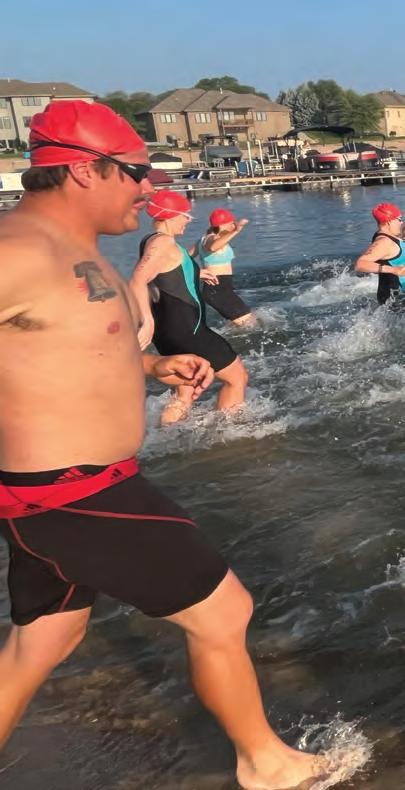

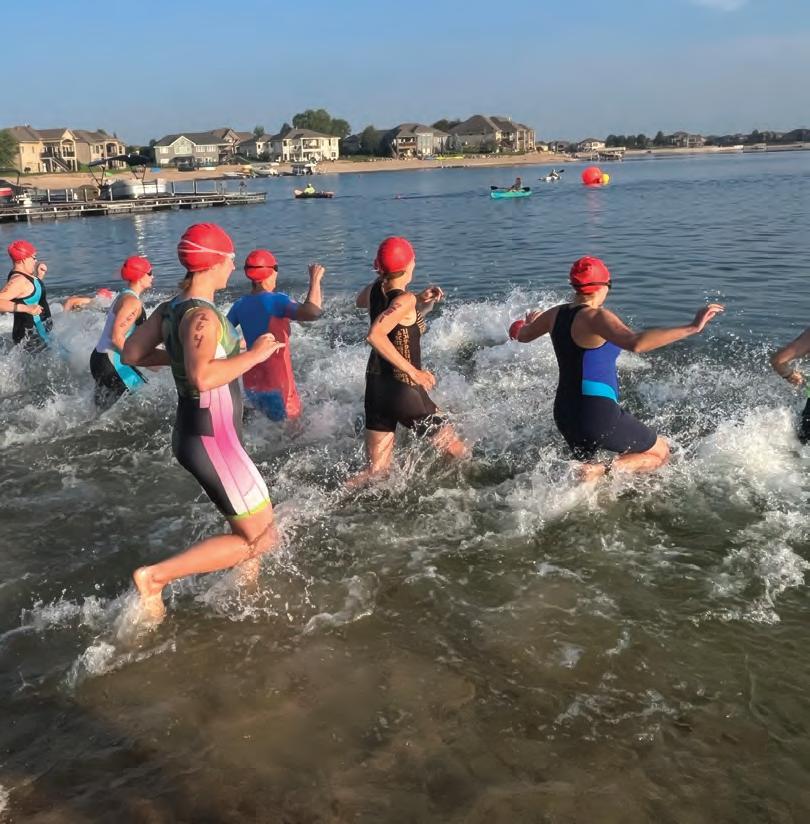

The CORNHUSKER STATE GAMES, hosted at more than 50 locations across Nebraska, is a 10-day spectacle of amateur SPORTSMANSHIP and ATHLETICISM.
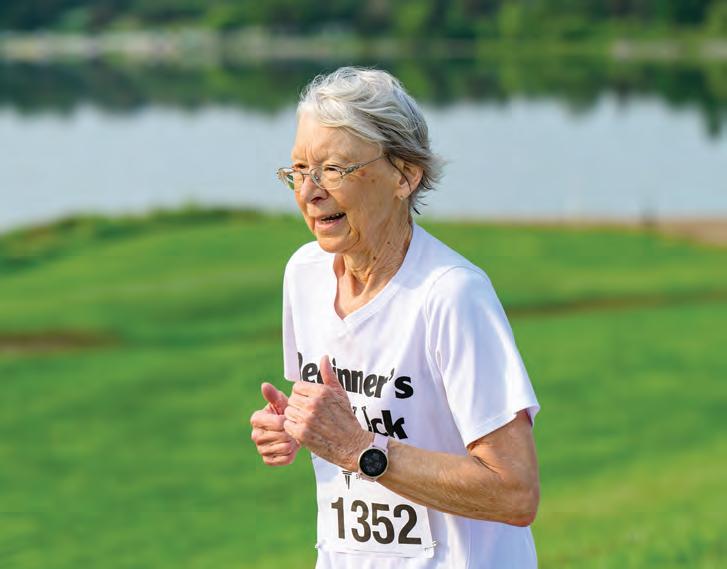
Sites across Nebraska host the games: Youth Sand Volleyball at Spikes Beach Bar & Grille in Lincoln; Triathlons course through Mallard Landing Lake in Valley and 5v5 Basketball at Speedway Sports Complex in Lincoln. Linda Kamble from Lincoln won a gold medal in the 5K Road Race around Holmes Lake in southeast Lincoln.
“It’s about FAMILY. It’s about FITNESS. It’s people having FUN. The Games are there for people who really need it.” – Dave Mlnarik, president of the Nebraska Sports Council


In the 2023 Games, Gwen Todd received six medals, earning gold in the 400-meter freestyle, 200-meter breaststroke and 200-meter backstroke.
become more important to them than they realized.
On May 28, 2021, just months before the 2021 games, Emmett suffered a spinal cord injury breaking his C3 and C4 vertebrae. He was paralyzed from the neck down. It was uncertain if he would ever walk again, but his family held on to hope. His parents promised him that he would walk again – and that he would compete with his family in the 4x100 relay.
During the 2021 games, while Emmet was still in rehab in Denver, his family made good on their promise. His father and brothers flew to Denver, sneaked Emmett out of the hospital and brought him to a high school track nearby. Tom Hassenstab and his three sons had their own 4x100 – Emmett finished the final leg.
“Tom helped Emmett out of his wheelchair and holding on to his gate belt, with Jack and George, walked with him the 100 meters to the finish line,” mother Cheri said.
In 2022 the family was back at it again, this time in person at the Cornhusker State Games, claiming second place. In 2023, with sweat and tears, the Hassenstab family wheeled into first yet again. The crowd was electric, and the stands were packed despite the day’s high heat. His mother was in tears, watching Emmett independently run his 100 yards and help the family cross the finish line in first place. “God is good,” she said.
“This is what it’s all about,” Mlnarik said. “It’s about family. It’s about fitness. It’s people having fun. The Games are there for people who really need it. It’s both humbling and a source of pride.”
Hundreds of small stories, both like the Hassenstab’s and Bloemker’s, happen at the Cornhusker State Games every year. Without fail thousands of Nebraskans gather just for the sake of friendly competition. They appreciate the thrill, the camaraderie and the chance to represent their state as a champion. Plain and simple.
The 40th annual Cornhusker State Games is July 11-21, 2024. Visit cornhuskerstategames.com for schedules, venues and athlete registration.
by ALAN J. BARTELS
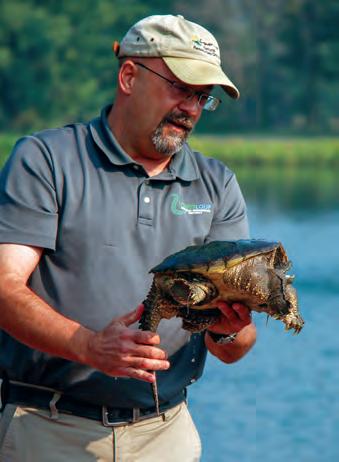
BRANT BECHTOLD/LLNRD
I set the beast in the backyard, admiring its prehistoric appearance while testing its tolerance of humankind.
Everyone who knows me will attest that I have a slight fascination with turtles. My mom would tell you that I always have. My close friends, and Mom, too, might say that my adoration for these shelled reptiles borders on the extreme.
Mom is always right. During the summer before eighth grade, my mom proved that yet again after I returned from an Elkhorn River fishing trip with a hefty common snapping turtle wedged headfirst into the basket on my bike – the first one I had ever caught! I set the beast in the backyard, admiring its prehistoric appearance while testing its tolerance of humankind.
“That thing is going to get you!” Mom yelled from the house.
Her words rang true moments later when the turtle’s sharp beak clamped onto my hand. I wouldn’t blame Mom for feeling just a little vindication when my shrill shriek echoed through Meadow Grove. Yep, Mom nailed it. Or rather, the turtle did. The experience gave new meaning to the term “hand-fed.”
Repeated run-ins with sharp snappers are why I only have nine fing...
Just kidding. Fortunately for me, Nebraska’s common snapping turtles simply do not have the jaw pressure to shear off fingers like their cousins, the distantly related alligator snapping turtles of the southeast United States.
My obsession went from having a herd of turtles as part-time childhood pets to my adult years giving educational turtle presentations to any group that asked. At the time, my collection of Chelonians –turtles and tortoises – included Nebraska’s nine native species, and varieties from across the U.S. and the world. The collection also included fossilized sea turtle fragments, a completely fossilized tortoise and cultural items such as Native American rattles.
I presented to Boy Scouts, Girl Scouts and summer youth camps, spoke at University of Nebraska-Lincoln and University of Nebraska at Kearney, appeared at Nebraska Game and Parks Commission events, and even gave a presentation to UNL’s Osher Lifelong Learning Institute.
While heading home that afternoon on I-80, a motorist slowed beside me pointing urgently toward the back of my Jeep. Turns out the 35-pound common snapping turtle I brought with me pried the lid off its tote, climbed out and watched traffic go by from the backseat.
Another time, while talking turtles at the Rivers and Wildlife Celebration in Kearney, an even larger snapper stole the show. Having already talked about painted turtles, box turtles, mud turtles and our other native species, I revealed the snapper that I always saved for last.
The crowd made a collective gasp as I pulled the behemoth from its crate. I wasn’t about to hand it through the crowd like I had the smaller animals, but wanting everyone to get a good look, I carried the reptile down the center aisle. Unexpectedly, a woman quickly reached toward the turtle’s head. Shocked, I turned the innocent turtle away just in time as its jaws snapped tightly shut. My old friend, the late John Murphy, told me when that happened, he saw the color drain from my face.
These days, the only turtle in my collection is a feisty snapping turtle that I hatched from an egg salvaged from its road-killed mother 17 years ago. Which reminds me: Turtles are on the move in late spring and early summer in Nebraska, headed toward safe places in which to lay their eggs. Unfortunately, this often puts them in harm’s way.
I brake for turtles and always help them off the road when it is safe to do so. Mom would say that it is just the right thing to do.
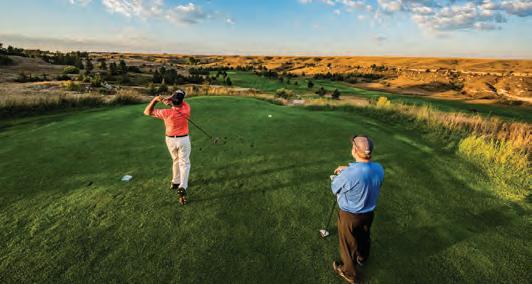
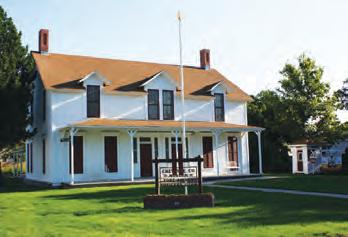

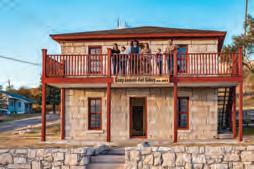
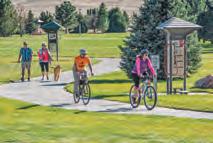


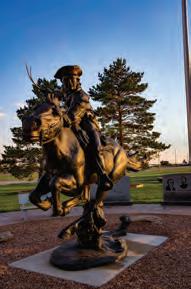
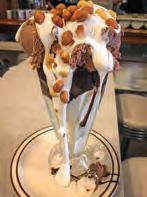
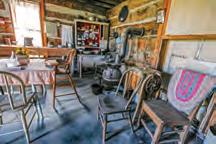
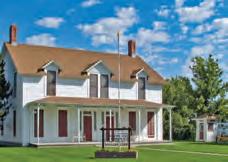



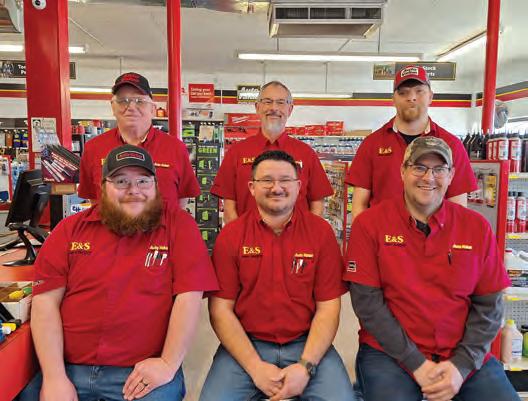
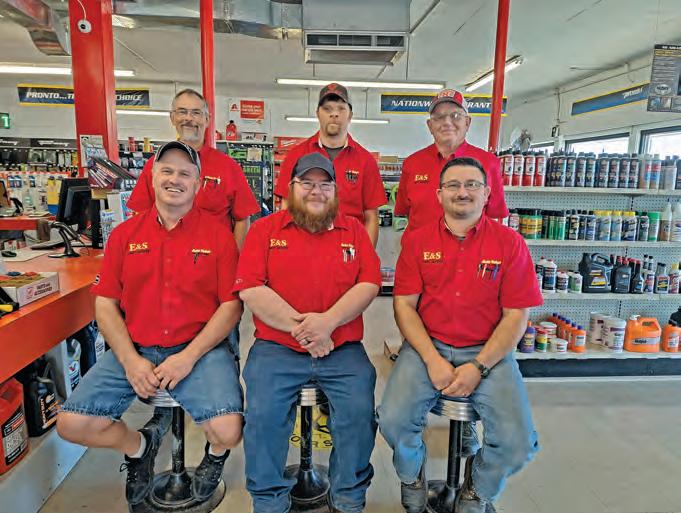
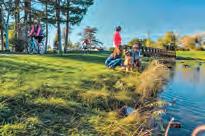
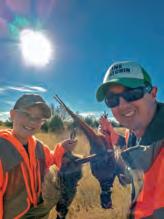
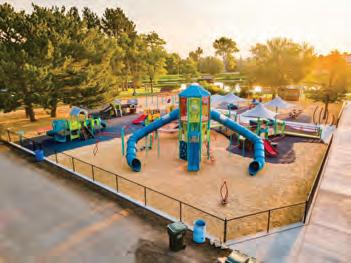
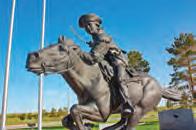
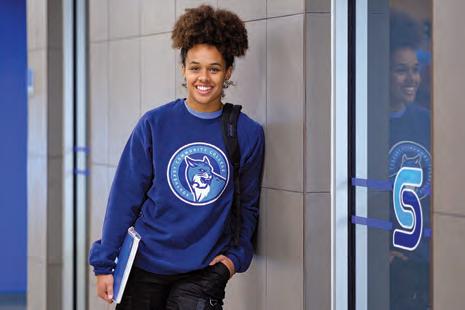
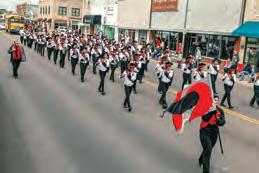
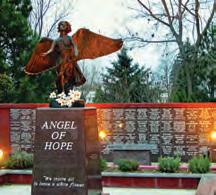

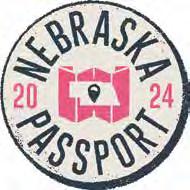
by LAUREN WARRING
Travel program celebrates its 15th year showcasing Nebraska’s hidden gems
EBRASKA TRAVELERS don’t need to look far this year for a curated road trip tour of the state: The 2024 Nebraska Passport Program has begun. To celebrate the 15th year, an additional 15 Bonus Stops have been added as a mini passport guide that accompanies the chosen 70-stop adventure.
A tradition since 2010, participants follow 10 “tours” across the state with unique themes like “Rise and Shine” featuring stops including a coffee house, a bed and breakfast and a campground. As participants visit each stop, their passports are stamped or checked in using the program’s digital app. Each stop is chosen to highlight Nebraska’s “hidden gems” – attractions, activities, restaurants, boutiques and more exceptional stops across the state. Not one year is the same as new stops are selected, grouped by new quirky themes.
As Nebraskans travel the state, they can follow along the “Drive, Stop, Drive, Stop” tour that follows stops along I-80 and the Lincoln Highway. Other 2024 themes include Bring Your Wallet (small businesses and boutiques), Drop Some Dough (bakeries and sweets), Fine Vines (wineries), Great Stops, Non-Stop (galleries and coffees), Parks A’ Plenty (outdoor activities and performances), Rare & Remarkable (extraordinary stops in Nebraska), The Old and the Beautiful (museums and historic sites) and Various Vittles (unique eateries).
This year, the anniversary passport includes 15 Bonus Stops that highlight fan favorites throughout the program’s history. Each stop on the mini passport includes a one-of-a-kind collectible sticker unique to its location. Fan Favorite
stops include Master’s Hand in Tekamah, Smith Falls State Park in Valentine, Our Lavender Co. in Big Springs, Museum of the Fur Trade in Chadron and Classic Car Collection in Kearney.
Each year, more and more participants have completed all 70 stops in the 152-day program. Champions are entered to win a monthly steak box from Omaha Steaks, one combo meal a week for a whole year from Runza Restaurants and a two-night stay at one of Nebraska Game and Parks properties. Even if a participant only collects one stamp, they are still entered to win other prizes donated from current and previous stops.
In 2023 alone, the program saw 47,500 requested passports, 131,203 collected stamps and 1,014 champions who completed all 70 stops. This year, the program continues its legacy to showcase the best stops across the state. Participants can order a physical passport or download the app today to follow along each curated tour. Visit nebraskapassport.com for more information.

Aurora
Susan’s Books & Gifts 1124 13th St. (402) 694-2244
Bennet
Antique Anthology 690 Monroe St. (402) 782-4247
Bridgeport
The Simple Co. Coffeehouse & Floral Shop 1023 Main St., (308) 262-1621
Fordyce Diane’s Greenhouse 88781 557th Ave., (402) 357-3754
Lincoln
Ten Thousand Villages Lincoln 140 N. 8th St., (402) 475-4122
Wax Buffalo Candle Lab + Small Bar 4723 Prescott Ave., (531) 500-1568
Stromsburg
Primitive Chicks – Antiques and Home Decor 113 E. 4th St., (402) 366-1823

DRIVE, STOP, DRIVE, STOP
Central City
Magnolias Boutique 1702 16th Ave., (308) 624-4157
Columbus The Broken Mug 2200 28th Ave., (402) 835-5504
Gothenburg
Gothenburg Historical Museum 1420 Ave. F, (308) 537-4212
Kearney
Steinbrink Landscaping & Greenhouses 2010 30th Ave., (308) 234-6670
North Platte
CR Rustic Antique Mall on the Bricks 108 E. 5th St., (308) 221-6725
Omaha Monolithic Brewing 4715 N. 120th St. Ste. 102, (402) 502-4477
Potter
Hanger 39 – Flyover Brewing Co. 947 Sherman St., (308) 250-2858
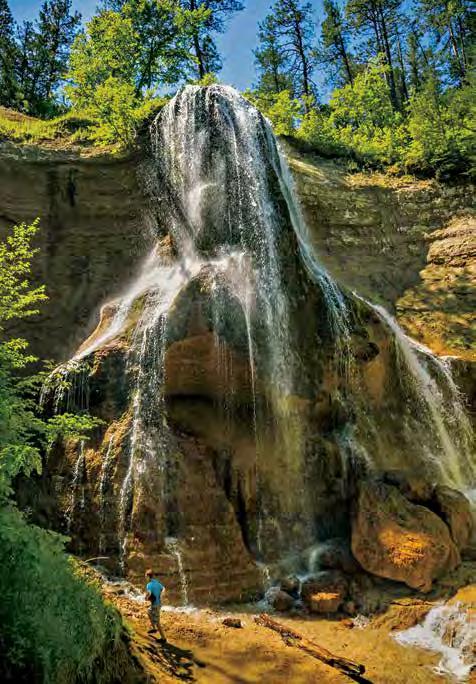
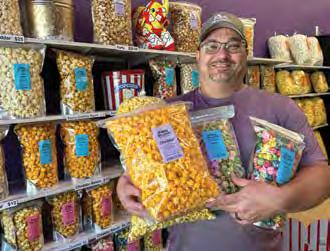

Beatrice
Happy Kernel Gourmet Kettle Corn & Pork Rinds 811 Court St., (531) 321-1494
Kala’s Savory Bites and Sifted Sweets 512 Court St., (402) 806-2319
Burr
Adeline’s Bakery 1910 R Road, (402) 430-0565
Hastings
Special Scoops Ice Cream Parlor 444 W. 2nd St., (402) 519-0192
Lodgepole
Wildeflour Baking Co. 832 Sheldon St., (308) 249-0516
McCook The Scoop Ice Cream
305 W. 10th St., (308) 737-0278
Norfolk
Poppin’ Delights Gourmet Popcorn 311 W. Norfolk Ave., (402) 316-9778

Central City
Prairie Creek Vineyard and Winery 1600 16th St., (308) 940-3863
Hartington
Nissen Winery and Tasting Room 88973 Hwy 57, (402) 254-3426
North Platte
Feather River Vineyards 5700 S.E. State Farm Road, (308) 696-0078
Every year, new stops are featured, like Poppin’ Delights Gourmet Popcorn in Norfolk. Fan Favorite stops including Smith Falls State Park in Valentine hand out collectible stickers to celebrate Nebraska Passport’s 15th year.
Raymond James Arthur Vineyards 2001 W. Raymond Road, (402) 783-5255
Seward
Junto Wine 1356 182nd, (402) 303-4871
Superior
Superior Estates Winery 200 W. 15th St., (402) 879-3001
Syracuse
Rich Harvest Vineyard and Winery 3010 G Road, (402) 828-0708

Alliance
Knight Museum and Sandhills Center
908 Yellowstone Ave. (308) 762-2384
Grand Island
Barista’s Coffee House 940 N. Webb Road, (308) 384-4584
Halsey
Nebraska National Forest Bessey Ranger Dist. 40637 River Loop Road, (308) 533-2257
Merna
The Secret Garden 80445 Road 431, (308) 643-9250
Mullen
Mullen Arts Center 109 NW 1st St. (308) 546-0636
Thedford
Anthem Coffee 39295 Hwy 2, (308) 645-2381

Ashland
Melodramas by Popcorn Productions at Eugene T. Mahoney State Park 28500 W. Park Hwy, (402) 944-2523
Elwood
Johnson Lake State Recreation Area 1 E. Park Dr. 25A, (308) 785-2685
Grand Island
Island Oasis Waterpark 321 E. Fonner Park Road, (308) 385-5381
Holdrege
Holdrege Sculpture Tour
Nebraska Prairie Museum 2701 Burlington St., (308) 995-5015
Louisville Lakeside in Louisville Louisville State Recreation Area 15810 Hwy 50, (402) 607-9022
Papillion
Werner Park 12356 Ballpark Way, (402) 738-5100
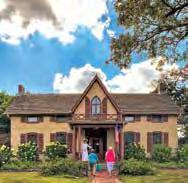
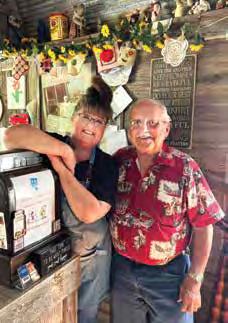
Passport stops celebrate small businesses and local favorites, such as Adeline’s Bakery in Burr, owned by Amy Oswalt (left).
Trenton
Swanson Reservoir State Recreation Area 36166 Road 44B, (308) 334-5493
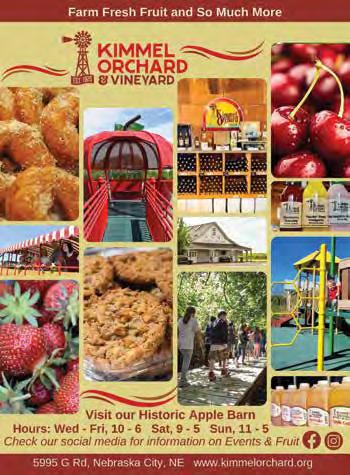

Kearney
The Archway
3060 E. 1st St., (308) 237-1000
Lincoln Art & Soul Cafe and Bar 5740 Hidcote Dr., (402) 483-1744
Ogallala
Petrified Wood and Art Gallery
418 E. 1st St., (308) 284-9996
Omaha
Mormon Trail Center, Historic Winter Quarters 3215 State St., (402) 453-9372
Paxton
Ole’s Big Game Steakhouse & Lounge
103 N. Oak St., (308) 239-4500
Plainview
Plainview Klown Doll Museum
306 W. Park Ave., (402) 582-4433
Raymond Branched Oak Observatory 14300 NW 98th St., (402) 480-5515

Atkinson
Sandhills Guest House Motel 119 S. Hyde St., (402) 925-5600
Brownville
Gospel Coffee & Ice Cream 121 Main St.
Chadron
Bean Broker Coffee House & Pub 202 W. 2nd St., (308) 432-4500
Fairfield
Spring Ranch Campground 30551 Road D, (402) 726-2282
Nebraska City
Lied Lodge at Arbor Day Farm 2700 Sylvan Rd., (800) 546-5433
Seward
Liberty House B&B, Antiques & Tours 441 N. 5th, (402) 643-2555
Sidney
Beans and Steams Coffee House 610 Glover Road, (308) 203-1417

Bancroft
John G. Neihardt State Historic Site 306 W. Elm St., (402) 648-3388
Lincoln Great Plains Art Museum 1155 Q St., (402) 472-6220
Nebraska City Wildwood Historic Center 420 Steinhart Park Road, (402) 873-6340
Omaha
El Museo Latino 4701 S. 25th St., (402) 731-1137
Red Cloud
The Willa Cather Childhood Home 425 N. Webster St., (402) 746-2653
Sidney Cheyenne County Museum and Post Commander’s House , 544 Jackson St., (308) 254-2150
Valentine
Centennial Hall Historic Museum 313 N. Macomb St., (800) 658-4024
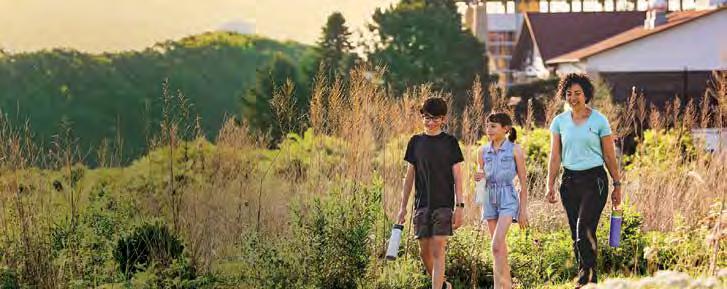
Discovery awaits at Arbor Day Farm. Whether feasting on local barbecue at Porter’s, exploring the one-of-a-kind Treetop Village®, or relaxing under the soaring timbers of Lied Lodge, there’s something for the entire family at Arbor Day Farm in Nebraska City.
Start planning your getaway at arbordayfarm.org.

Crofton
Dam Fish Shack
55310 Hwy 121, (402) 388-4140
Fairbury Rowdy’s Steakhouse
321 F St., (402) 729-5083
Fremont
Los Mezcales Ortiz
210 N. Main St., (402) 620-4848
Kearney
S.A.M. Que and Catering
324 3rd Ave., (308) 455-1190
Nebraska City
The Keeping Room
717 Central Ave., (402) 873-7797
Ponca
Outlaw Pizza and Ice Cream
105 E. 3rd St., (402) 755-2223
Scottsbluff Powerhouse on Broadway – Suites and Social 1721 Broadway, (308) 633-2288
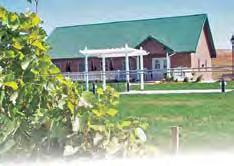



Bayard
Chimney Rock Museum 9822 County Road 75, (308) 586-2581
Big Springs
Our Lavender Co. 20380 County Road 4, (308) 289-7208
Chadron Museum of the Fur Trade 6321 Hwy 20, (308) 432-3843
Crawford
Fort Robinson Museum & History Center 3200 W. Hwy 20, (308) 665-2900
Edgar
Sugar Shack Home Decor 707 5th St., (402) 224-3211
Gering
Wildcat Hills State Recreation Area 210615 Hwy 71, (308) 436-3777
Greenwood Bakers Candies 831 S. Baker St., (402) 789-2700

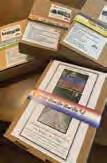


Kearney
Classic Car Collection 3600 E. Hwy 30, (308) 234-1964
Lincoln Robber’s Cave Tours 925 Robbers Cave Road, (402) 975-0598
Nebraska City
Kregel Windmill Factory Museum 1416 Central Ave., (402) 873-1078
Omaha
Great Plains Black History Museum 2221 N. 24th St., (402) 932-7077
Potter
Potter Sundry 324 Chestnut St., (308) 225-0740
Taylor Taylor Villagers, 822296 Hwy 183, (308) 214-0847
Tekamah Master’s Hand, 3599 County Rd. F, (402) 374-2003
Valentine Smith Falls State Park 90159 Smith Falls Road, (402) 376-1306
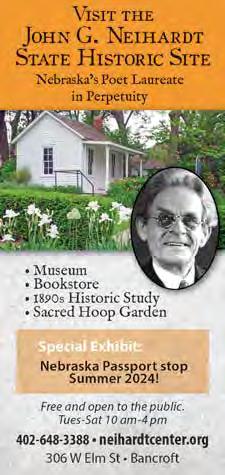

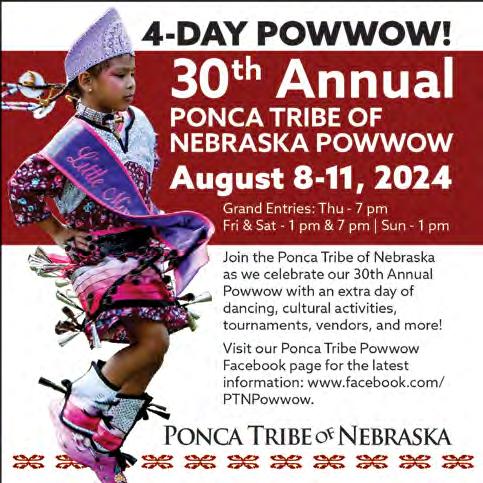




















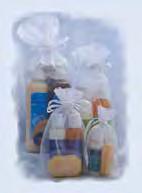

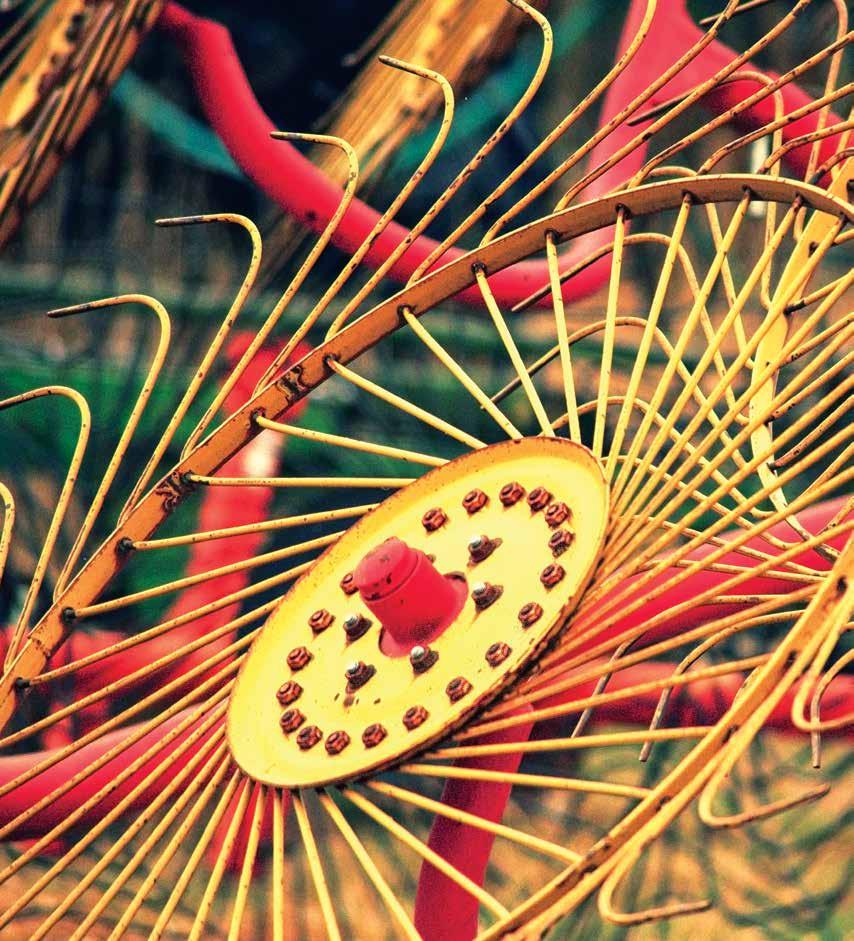
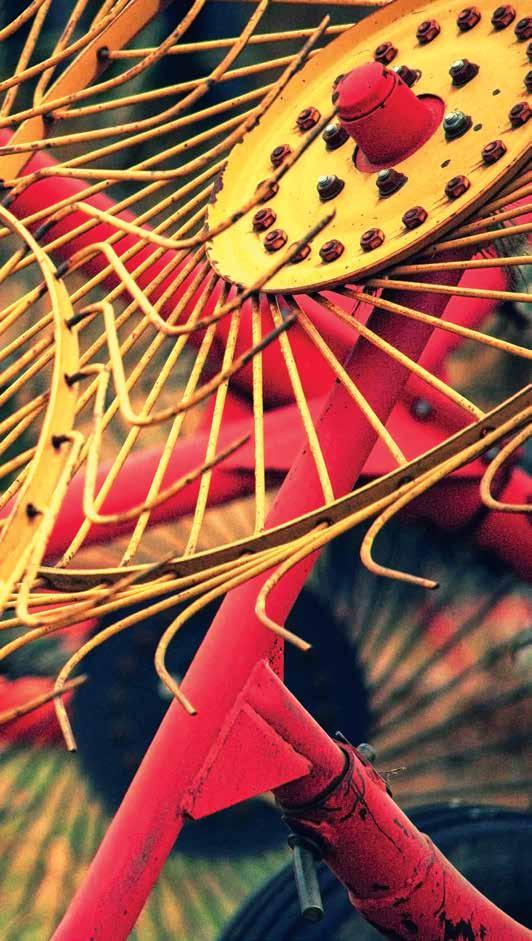
photograph by KAREN KADER
Karen Kader remembers her mother taking her on “gravel travels,” from Omaha into farm country to the west. There she saw objects and heard stories unfamiliar to a city girl.
“She taught me to drive through the small towns and near farms because there’s so much to see and so many stories,” Kader said. Among the things that caught her attention, to which she turned her camera, was a hay rake. She remembers taking this image of a wheel rake on one of her gravel travels, northeast of Wood River.
“Up close, it looked abstract,” she said. “I’ve seen blue and red ones. Plain metal ones. Looks like a sculpture, a nice piece of art.”
Among the people Kader and her mother met during the pandemic on their gravel travels was Marc Nemec in Prague.
“We didn’t see anybody, but we did hear faint accordion music,” she said. “We went to look for the source and found Marc playing to an invisible audience. Yet, people were listening, from inside homes and a few cars. My mom and I went to talk to him to hear his story.”
IN EACH ISSUE, Last Look features a reader’s photograph of Nebraska – landscapes, architecture, events, people or wildlife. Submit your best shots for the chance to be published in Nebraska Life. Send digital images with detailed photo descriptions and your contact information to photos@nebraskalife. com or visit nebraskalife.com/contribute.
THIS PHOTO was taken with a Nikon D5100, and exposed at ISO 1600, f/5.3 for 1/4000 of a second.




